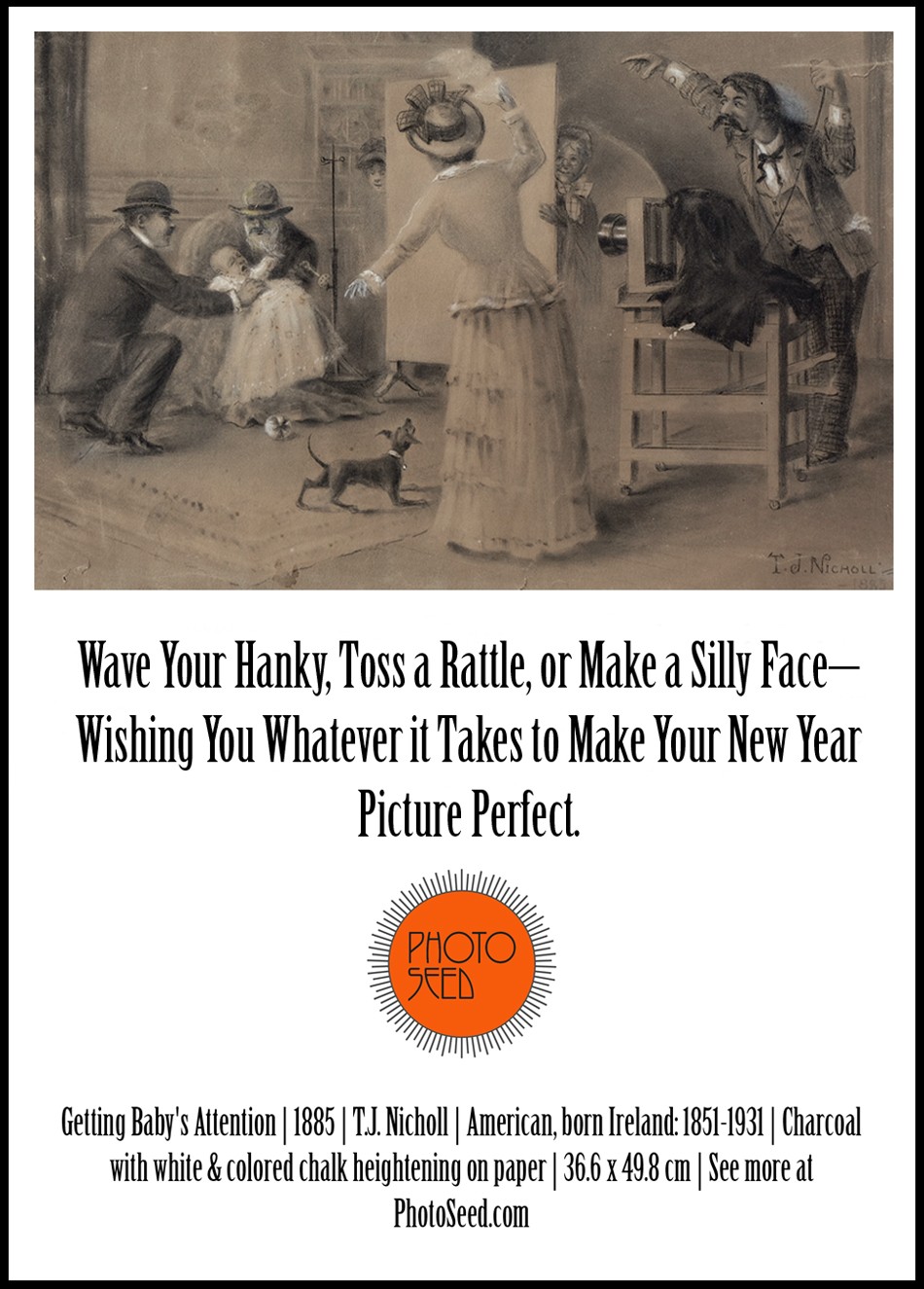Category
Photography
8 entries in this category | view all categories
Henry Ravell: Embracing Art & Photography
Posted August 2020 in Alternate Processes, Cameras, Color Photography, Documentary Photography, Framing, History of Photography, New Additions, Painters|Photographers, Photography, Scientific Photography, Significant Photographers
“Coburnesque”, or, in the style of American master pictorialist Alvin Langdon Coburn, (1882-1966) was how the work of now forgotten American photographer Henry Ravell (1864-1930) was described in 1908 by London’s Amateur Photographer & Photographic News.
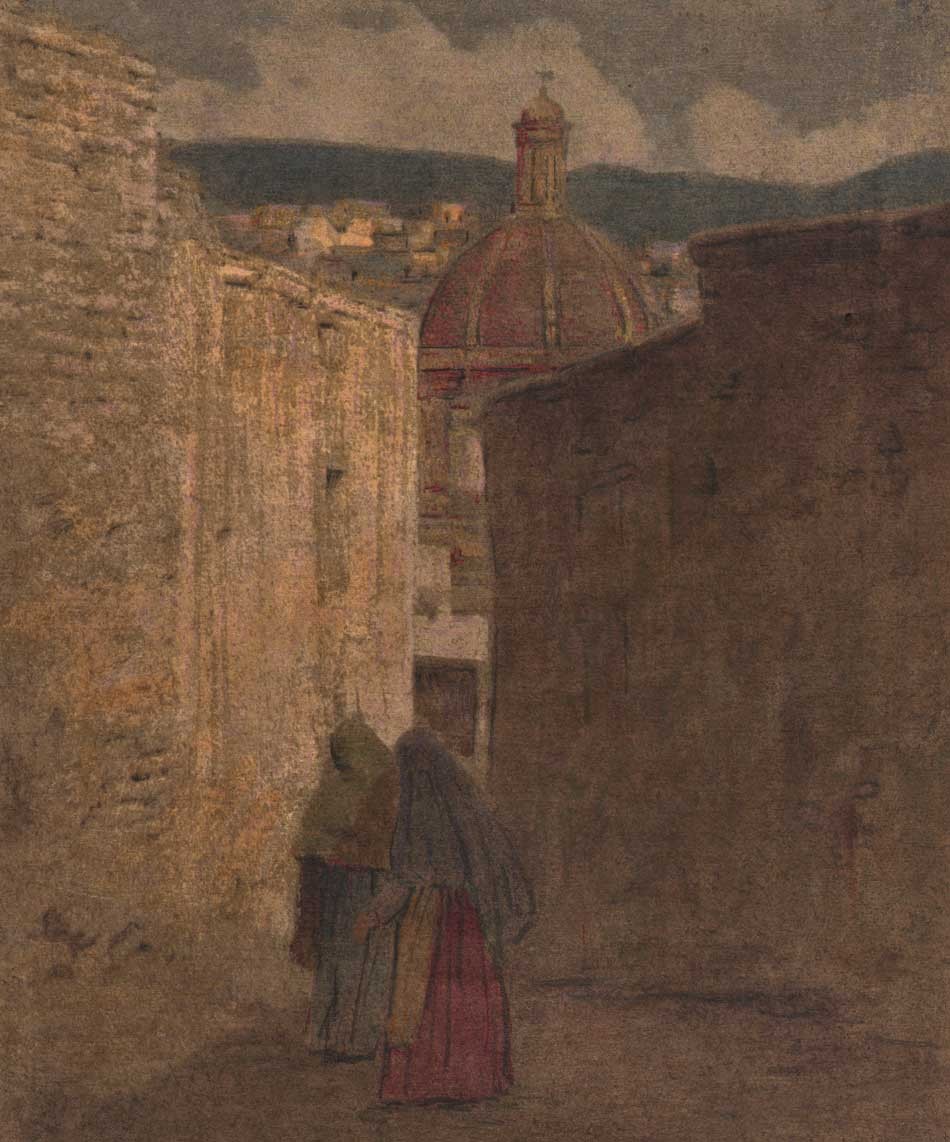 Detail: “A Narrow Street-Guanajuato”: Henry Ravell, American: 1864-1930. Vintage multiple color gum print c. 1907-14. Image: 33.1 x 23.5 presented loose within brown paper folder with overall support dimensions of 39.8 x 58.8 cm. In central Mexico, with the dome of a church framing the skyline at center in background, two native women make their way along one of Guanajuato’s narrow streets. Henry Ravell perfected the gum bichromate process to a very high level. Probably in 1906-07, he began experimenting in multiple color gum. In Germany, around this same time, similar examples were being done by the brothers Theodor (1868-1943) and Oscar Hofmeister, (1871-1937) as well as Heinrich Wilhelm Müller. (1859-1933) From: PhotoSeed Archive
Detail: “A Narrow Street-Guanajuato”: Henry Ravell, American: 1864-1930. Vintage multiple color gum print c. 1907-14. Image: 33.1 x 23.5 presented loose within brown paper folder with overall support dimensions of 39.8 x 58.8 cm. In central Mexico, with the dome of a church framing the skyline at center in background, two native women make their way along one of Guanajuato’s narrow streets. Henry Ravell perfected the gum bichromate process to a very high level. Probably in 1906-07, he began experimenting in multiple color gum. In Germany, around this same time, similar examples were being done by the brothers Theodor (1868-1943) and Oscar Hofmeister, (1871-1937) as well as Heinrich Wilhelm Müller. (1859-1933) From: PhotoSeed Archive
Under the headline “Local Colour.” by journal critic “The Magpie”, a discussion of the merits around Ravell’s new color multiple gum printing process was considered for their large readership. Commenting on a series of his Mexican church photographs published in the May issue of the Century Magazine, “Magpie” writes:
“Who is this Mr. Ravell, and what is his wonderful colour process, which is not “on the negative”? Multiple-gum, one may surmise- and one may also venture to guess that Mr. “de Forest” (Lockwood de Forest- editor) has, notwithstanding this flourish of trumpets, nothing very much to tell us. The Ravell photographs, illustrating “Some Mexican Churches,” are Coburnesque, and the pictures are, in their very Yankee style, fine and strong- which is more than can be said for those in our English monthlies. Couldn’t Mr. Ravell be induced to send some examples of his work to the R.P.S. or Salon? We badly need some new American exhibitors.” (June 16, p. 600)
A reassessment of Ravell’s output is long overdue in elevating him back to his rightful position as one of the more important practitioners of pictorialism in the early 20th Century canon of American artistic photographers.
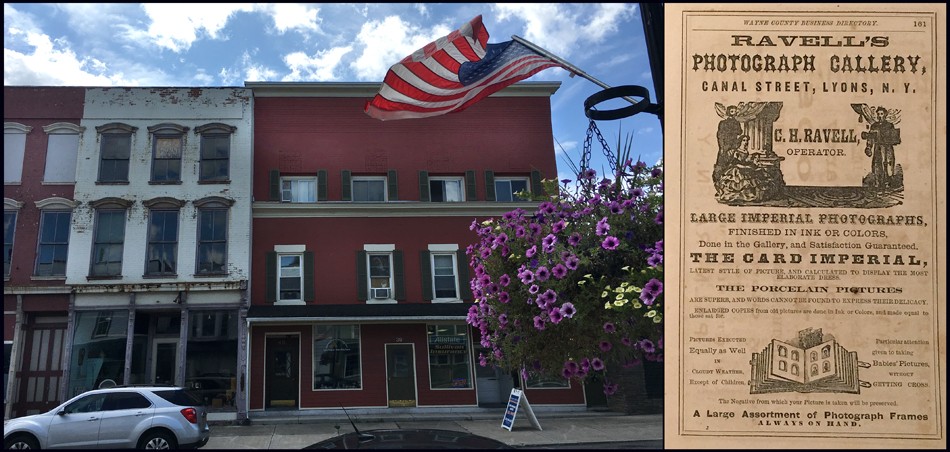 Left: Henry Ravell was only a toddler when his father Charles Henry Ravell (1833-1917) opened a skylight photographic studio on the third floor of this brick building painted red located on Canal Street in Lyons, New York around 1865-66. Shown here in the summer of 2019, the entrance was at the present day 36 Canal street (on the far right of the photo-presently an insurance office) but was numbered #30 Canal before the turn of the 20th Century. It was here that Henry was “brought up in photography from childhood and became an expert in all processes before he was twelve years old”. Right: A full-page advertisement for “Ravell’s Photograph Gallery” operated by C.H. Ravell at the Canal street building appeared in the 1867-68 Wayne County (New York) Business Directory. At the time, Charles Ravell would have been using the wet-plate process, and the ad highlights “Large Imperial Photographs finished in Ink or Colors”… “Pictures Executed Equally as Well in Cloudy Weather Except of Children”… “Particular attention given to taking Babies’ Pictures, without Getting Cross”. Left: David Spencer for PhotoSeed Archive; Right: courtesy Museum of Wayne County History.
Left: Henry Ravell was only a toddler when his father Charles Henry Ravell (1833-1917) opened a skylight photographic studio on the third floor of this brick building painted red located on Canal Street in Lyons, New York around 1865-66. Shown here in the summer of 2019, the entrance was at the present day 36 Canal street (on the far right of the photo-presently an insurance office) but was numbered #30 Canal before the turn of the 20th Century. It was here that Henry was “brought up in photography from childhood and became an expert in all processes before he was twelve years old”. Right: A full-page advertisement for “Ravell’s Photograph Gallery” operated by C.H. Ravell at the Canal street building appeared in the 1867-68 Wayne County (New York) Business Directory. At the time, Charles Ravell would have been using the wet-plate process, and the ad highlights “Large Imperial Photographs finished in Ink or Colors”… “Pictures Executed Equally as Well in Cloudy Weather Except of Children”… “Particular attention given to taking Babies’ Pictures, without Getting Cross”. Left: David Spencer for PhotoSeed Archive; Right: courtesy Museum of Wayne County History.
Undoubtedly, “Magpie” would have been pleased to know Henry Ravell sprung from fine English photographic stock. His father Charles Henry Ravell (1833-1917) emigrated to the U.S. from Boston, England and was known to have been active as a Daguerreotypist as early as 1857, (1.) his trade shingle set up early in the New York state village of Chittenango. By 1860, U.S. Census records show he had moved to Wolcott, New York, where he was a commercial photographer. Surviving cdv photographs from here bearing his C.H. Ravell back-stamp reveal some of his clients were young men heading off to fight in the American Civil War.
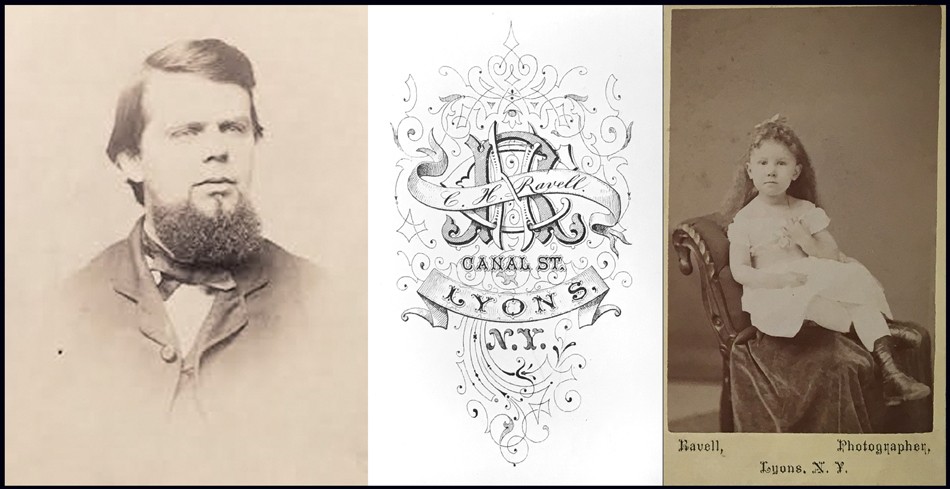 Left: This is the only known portrait of commercial portrait photographer Charles Henry Ravell, father of Henry Ravell. The carte de visite albumen portrait shows him most likely in his early 30’s, after he had settled in Lyons, New York. Born Charles Herring Ravel in Boston, England, he emigrated to the U.S. as a young man, with an early notice of his Daguerreotypist skills from 1857 showing he was living in Chittenango, New York State. By 1860, he had settled in Wolcott, where son Henry was born in early 1864. By 1867 or earlier, he and wife Cornelia Dudley Ravell (1840-1908) and Henry had moved permanently to nearby Lyons. Middle & Right: This elaborate backstamp engraving for C.H. Ravell’s Canal Street skylight studio in Lyons is ca. 1865-80, with the albumen portrait subject (Right) a young girl posing on a commercially available chair. Both: courtesy Museum of Wayne County History
Left: This is the only known portrait of commercial portrait photographer Charles Henry Ravell, father of Henry Ravell. The carte de visite albumen portrait shows him most likely in his early 30’s, after he had settled in Lyons, New York. Born Charles Herring Ravel in Boston, England, he emigrated to the U.S. as a young man, with an early notice of his Daguerreotypist skills from 1857 showing he was living in Chittenango, New York State. By 1860, he had settled in Wolcott, where son Henry was born in early 1864. By 1867 or earlier, he and wife Cornelia Dudley Ravell (1840-1908) and Henry had moved permanently to nearby Lyons. Middle & Right: This elaborate backstamp engraving for C.H. Ravell’s Canal Street skylight studio in Lyons is ca. 1865-80, with the albumen portrait subject (Right) a young girl posing on a commercially available chair. Both: courtesy Museum of Wayne County History
Born in early January of 1864 in Wolcott, Henry Ravell is known to have embraced photography from a very young age. As a boy, he became his father’s apprentice. Lockwood de Forest, (1850-1932) an important influence on Henry for the rest of his life in the 20th Century and important American painter and furniture designer, wrote in 1908 that Henry:
“was born and brought up in photography from childhood and became an expert in all processes before he was twelve years old.” Through a fascinating confluence of sons starting out in their father’s professions, Henry Ravell graduated to having an interest in art, and he studied water-color painting with the noted American artist and Tonalist Henry Ward Ranger, (1858-1916) probably in his late teens or early 20’s. The artist and student had much in common. Like Charles Henry Ravell, who had established his own Canal Street photo studio in Lyons, N.Y. by 1867, (Wayne County Business Directory) Ranger’s father Ward Valencourt Ranger (1835–1905) had opened his own commercial studio in 1868 in Syracuse, N.Y., 55 miles east of Lyons, almost at the same time. Like Henry Ravell working for his father at an early age, Henry Ranger was also known to have worked in his father’s establishment as a young man.
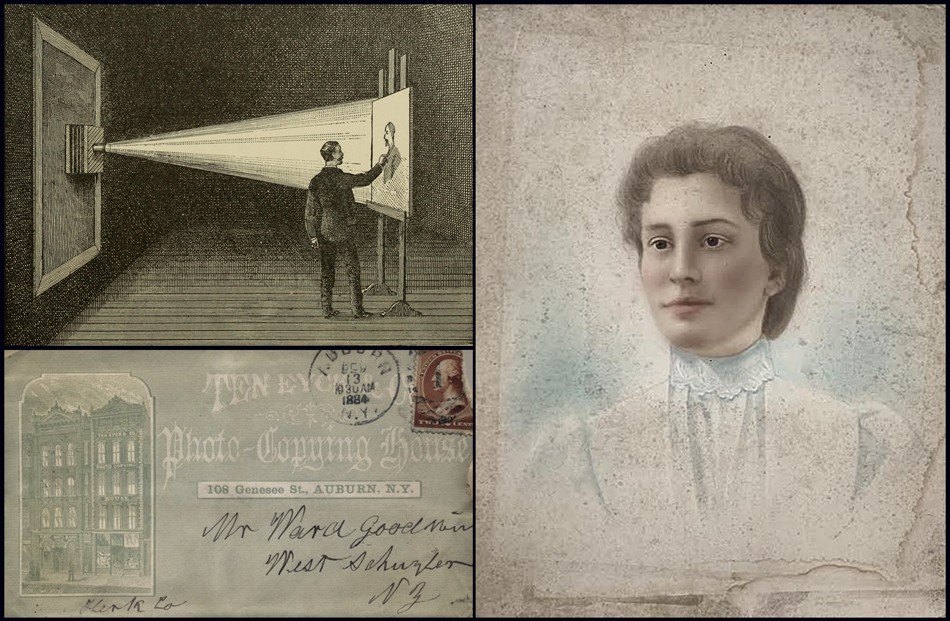 Upper Left: “Negative Outline-Dark Chamber”: woodcut from 1892 volume “Crayon Portraiture: Complete Instructions for making Crayon Portraits on Crayon Paper and on Platinum, Silver, and Bromide Enlargements” by J.A. Barhydt. In the early 1880’s, Henry Ravell worked in a similar capacity as the artist shown here for the Photo-Copying House Ten Eyck & Co. of Auburn, New York. Woodcut shows an enlarged and enhanced crayon portrait being made freehand on the easel at right. A photographic negative from a sitter has been placed inside a large box camera at left while mounted in front of a scrimmed-off window. This provides the light source for the projection within a darkened room while the artist goes over the outline and shadow lines of the projection in a first step. Other variations of crayon portraits began with an artist working in a lighted studio with charcoal and pastels after the initial projected outline on crayon, gelatin, bromide, etc. papers had been chemically fixed. Ten Eyck advertised on cover stationary from 1884: “Fine Portraits in India Ink, Water Colors and Crayon, By the Association of Celebrated Portrait Artists…” (From: Internet Archive) Lower Left: December, 1884 postmarked cover (envelope) from Ten Eyck & Co. Portraits located at 108 Genesee St., Auburn, N.Y. (8.5 x 15.0 cm-right margin perished) Ravell worked at the firm about this time, making a living combining his skill of photography and art. In the late 1880’s to early 1890’s, he became an agent for Ten Eyck after moving to Mexico. From: PhotoSeed Archive. Right: “Crayon-style Portrait” ca. 1890-5: (50.9 x 40.5 cm) enhanced water-color or India inks applied by hand to unknown (bromide?) photographic emulsion fixed onto light grade cardboard matrix. Henry Ravell produced similar crayon-style portraits for Ten Eyck, with this example from an unknown artist featuring Mary Carruthers Tucker (1877-1940) as subject, then living in Provo-City Utah. She was the spouse of C.R. Tucker, whose work is featured at PhotoSeed. From: PhotoSeed Archive
Upper Left: “Negative Outline-Dark Chamber”: woodcut from 1892 volume “Crayon Portraiture: Complete Instructions for making Crayon Portraits on Crayon Paper and on Platinum, Silver, and Bromide Enlargements” by J.A. Barhydt. In the early 1880’s, Henry Ravell worked in a similar capacity as the artist shown here for the Photo-Copying House Ten Eyck & Co. of Auburn, New York. Woodcut shows an enlarged and enhanced crayon portrait being made freehand on the easel at right. A photographic negative from a sitter has been placed inside a large box camera at left while mounted in front of a scrimmed-off window. This provides the light source for the projection within a darkened room while the artist goes over the outline and shadow lines of the projection in a first step. Other variations of crayon portraits began with an artist working in a lighted studio with charcoal and pastels after the initial projected outline on crayon, gelatin, bromide, etc. papers had been chemically fixed. Ten Eyck advertised on cover stationary from 1884: “Fine Portraits in India Ink, Water Colors and Crayon, By the Association of Celebrated Portrait Artists…” (From: Internet Archive) Lower Left: December, 1884 postmarked cover (envelope) from Ten Eyck & Co. Portraits located at 108 Genesee St., Auburn, N.Y. (8.5 x 15.0 cm-right margin perished) Ravell worked at the firm about this time, making a living combining his skill of photography and art. In the late 1880’s to early 1890’s, he became an agent for Ten Eyck after moving to Mexico. From: PhotoSeed Archive. Right: “Crayon-style Portrait” ca. 1890-5: (50.9 x 40.5 cm) enhanced water-color or India inks applied by hand to unknown (bromide?) photographic emulsion fixed onto light grade cardboard matrix. Henry Ravell produced similar crayon-style portraits for Ten Eyck, with this example from an unknown artist featuring Mary Carruthers Tucker (1877-1940) as subject, then living in Provo-City Utah. She was the spouse of C.R. Tucker, whose work is featured at PhotoSeed. From: PhotoSeed Archive
Sometime in the early 1880’s after Henry had finished this “apprenticeship”, he moved to nearby Auburn, New York, about halfway to Syracuse from Lyons, to a job crafting Crayon and Pastel portrait photographic enlargements for Ten Eyck & Co. At the time, this firm is said to have been the largest of its’ type in the world. This gave Henry additional artistic skills, combining his interest in photography and art, an important and influential confluence indeed. He kept at this profession until either 1883, according to Lockwood de Forest, or as late as 1892, in a posthumous biography of Henry by sister Florence.
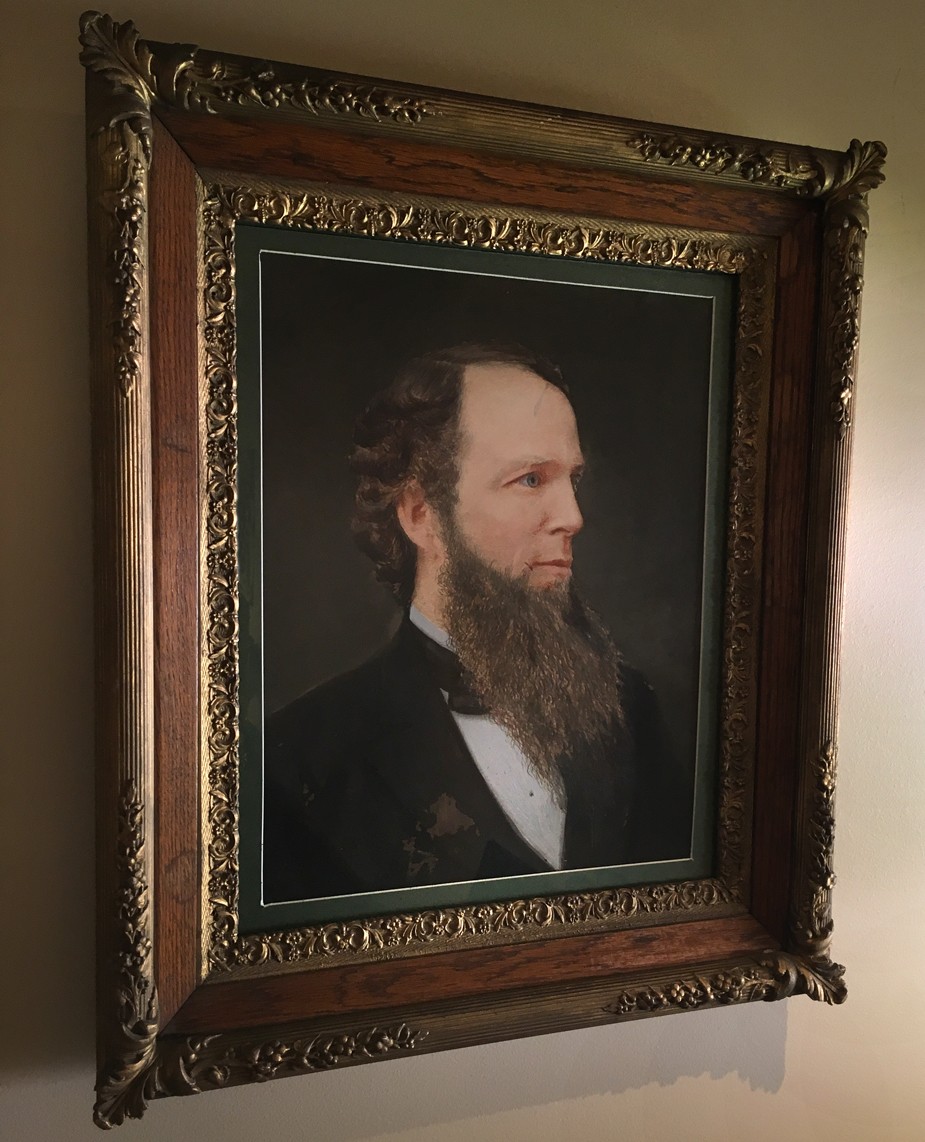 “Portrait of John Lee Cole”: Henry Ravell, American: 1864-1930. Ca. 1885 Gouache and or Oil? on paper, mounted within period wood frame bearing inscription “John L. Cole to Jason Parker, 1918”. This very rare example of a surviving painting by photographer Henry Ravell is now owned by the Museum of Wayne County History in Lyons, New York. Cole was a 1859 graduate of Yale and grandson of the Rev. John Cole, a founder with John Wesley of the Methodist Church in the U.S.. In 1862 he was admitted to the bar and later became a banker in Lyons for Mirick & Cole. An earlier 1882 notice of Henry’s artistic pursuits was published in The Democrat and Chronicle newspaper of Rochester, New York: “Henry Ravell, of Lyons, was in this city last night, on his return from Medina, (New York-editor) where he disposed of two of his latest paintings for $70.” (November 26) Photo by David Spencer for PhotoSeed Archive- artwork courtesy Museum of Wayne County History, Lyons N.Y.
“Portrait of John Lee Cole”: Henry Ravell, American: 1864-1930. Ca. 1885 Gouache and or Oil? on paper, mounted within period wood frame bearing inscription “John L. Cole to Jason Parker, 1918”. This very rare example of a surviving painting by photographer Henry Ravell is now owned by the Museum of Wayne County History in Lyons, New York. Cole was a 1859 graduate of Yale and grandson of the Rev. John Cole, a founder with John Wesley of the Methodist Church in the U.S.. In 1862 he was admitted to the bar and later became a banker in Lyons for Mirick & Cole. An earlier 1882 notice of Henry’s artistic pursuits was published in The Democrat and Chronicle newspaper of Rochester, New York: “Henry Ravell, of Lyons, was in this city last night, on his return from Medina, (New York-editor) where he disposed of two of his latest paintings for $70.” (November 26) Photo by David Spencer for PhotoSeed Archive- artwork courtesy Museum of Wayne County History, Lyons N.Y.
At this time, Henry is said to have moved to Cuernavava Mexico, south of Mexico City, where he became a far-flung agent for the Ten Eyck & Co. firm, although a certain amount of traveling back and forth to the U.S. and the family home was probably the reality. To wit, the Minnesota State Census for 1895 lists his occupation as “artist”, claiming an American residence while living with his father, mother and younger brother, Charles Ravell Jr. in the city of St. Paul. Here his father finished out his career running a photo studio on Western Ave. from 1890-92.
During the mid 1880’s back in Lyons, a fascinating yet presently unsubstantiated account of Henry’s involvement with the development of the first Kodak camera is relevant for background on his future career as a master photographer who became a striver with his own agenda. This event is worthy of historical contemplation in the present from reminisces provided in the aforementioned posthumous biography published in 1940:
“George Eastman of Rochester, New York, was a family friend. During a visit of three or four weeks, Mr. Eastman worked on and developed his famous Kodak, with the help of my father and brother.” “Their workshop was the basement of our former home at 70 Broad Street, Lyons. Mr. Eastman offered my father stock in the Kodak Company, which he often regretted not accepting.” (2.)
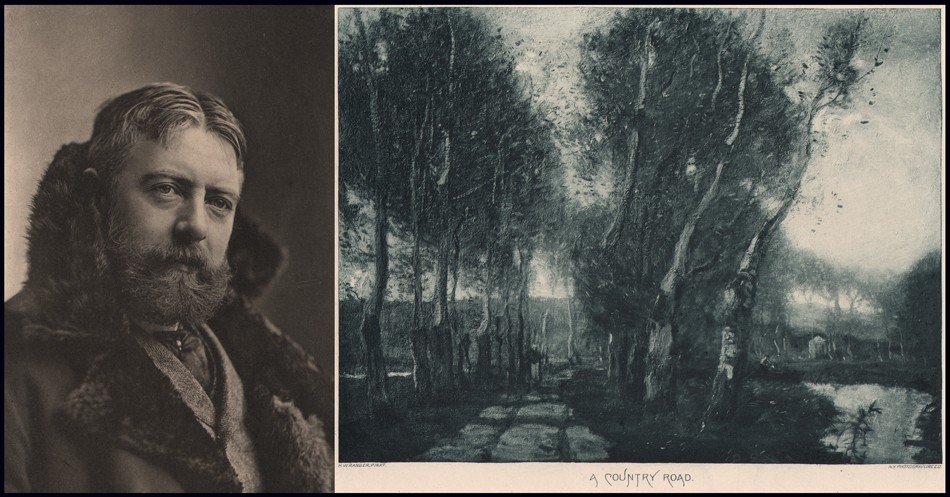 Left: “H.W. Ranger” (Henry Ward Ranger): Napoleon Sarony, American: born Quebec. (1821-1896) Photogravure published in periodical "Sun & Shade": New York: May, 1894: whole #69: N.Y. Photo-Gravure Co.: 22.4 x 15.2 | 34.9 x 27.6 cm. Like Henry Ravell assisting in his father’s studio, American artist and Tonalist Henry Ward Ranger (1858-1916) worked in his own father’s studio as a young man. Later, Ranger taught Henry water-color painting, probably when Ravell was in his late teens or early 20’s. The “Sun & Shade” periodical noting of Ranger: “His work in Lower Canada won him great repute, and as a water-color painter, before taking to oil-painting, he was undeniably excellent.” Right: “A Country Road”: Henry Ward Ranger, American. (1858-1916) Photogravure published in periodical "Sun & Shade": New York: May, 1894: whole #69: N.Y. Photo-Gravure Co.: 17.1 x 22.7 | 27.6 x 34.9 cm. Ranger’s bucolic painting style reveals itself in this simple country scene of a roadway lined with trees, probably done in Holland. Scenes like this would have undoubtedly made an impression on Henry the fledgling art student, assuming he had access to reproductions or the originals of his teacher’s work. On Ranger in the periodical: “He is an admirer and follower of the best Dutch school of art, and has made it his pleasure and his duty to pay many visits to Holland, in order to be perfectly au fait with the excellencies of its best masters.” On “A Country Road”: “It is seldom that so simple a subject becomes so important in form and color-so full of air and freedom, and so admirably harmonious in its proportions.” Both from: PhotoSeed Archive
Left: “H.W. Ranger” (Henry Ward Ranger): Napoleon Sarony, American: born Quebec. (1821-1896) Photogravure published in periodical "Sun & Shade": New York: May, 1894: whole #69: N.Y. Photo-Gravure Co.: 22.4 x 15.2 | 34.9 x 27.6 cm. Like Henry Ravell assisting in his father’s studio, American artist and Tonalist Henry Ward Ranger (1858-1916) worked in his own father’s studio as a young man. Later, Ranger taught Henry water-color painting, probably when Ravell was in his late teens or early 20’s. The “Sun & Shade” periodical noting of Ranger: “His work in Lower Canada won him great repute, and as a water-color painter, before taking to oil-painting, he was undeniably excellent.” Right: “A Country Road”: Henry Ward Ranger, American. (1858-1916) Photogravure published in periodical "Sun & Shade": New York: May, 1894: whole #69: N.Y. Photo-Gravure Co.: 17.1 x 22.7 | 27.6 x 34.9 cm. Ranger’s bucolic painting style reveals itself in this simple country scene of a roadway lined with trees, probably done in Holland. Scenes like this would have undoubtedly made an impression on Henry the fledgling art student, assuming he had access to reproductions or the originals of his teacher’s work. On Ranger in the periodical: “He is an admirer and follower of the best Dutch school of art, and has made it his pleasure and his duty to pay many visits to Holland, in order to be perfectly au fait with the excellencies of its best masters.” On “A Country Road”: “It is seldom that so simple a subject becomes so important in form and color-so full of air and freedom, and so admirably harmonious in its proportions.” Both from: PhotoSeed Archive
Memories can sometimes be suspect, but several details of Florence’s biography are important and worth following up on, with this website happy to accept the challenge. By tracking down old street addresses, the Ravell family home as published in the 1886-87 Lyons residential directory was actually found to be located as 40 Broad Street. (William Smith, whose occupation was Express Transfer Agent, lived at 70 Broad St. as published in the same directory) Coupled with the knowledge that Lyons street addresses had been renumbered, probably in the early 20th Century, and cross-referencing with a 1904 Sanborn Fire Insurance Company map found online at the Library of Congress, the former and still standing Ravell home built in 1850 revealed itself to be the present day 64 Broad Street. All of this effort, if somehow confirming a claim George Eastman had actually spent time in Lyons was true, could result in a potentially fascinating footnote to the development of one of the most important inventions of the 19th Century- The Kodak No. 1 Camera which debuted in 1888: “By far the most significant event in the history of amateur photography”, according to the Met Museum in New York City.
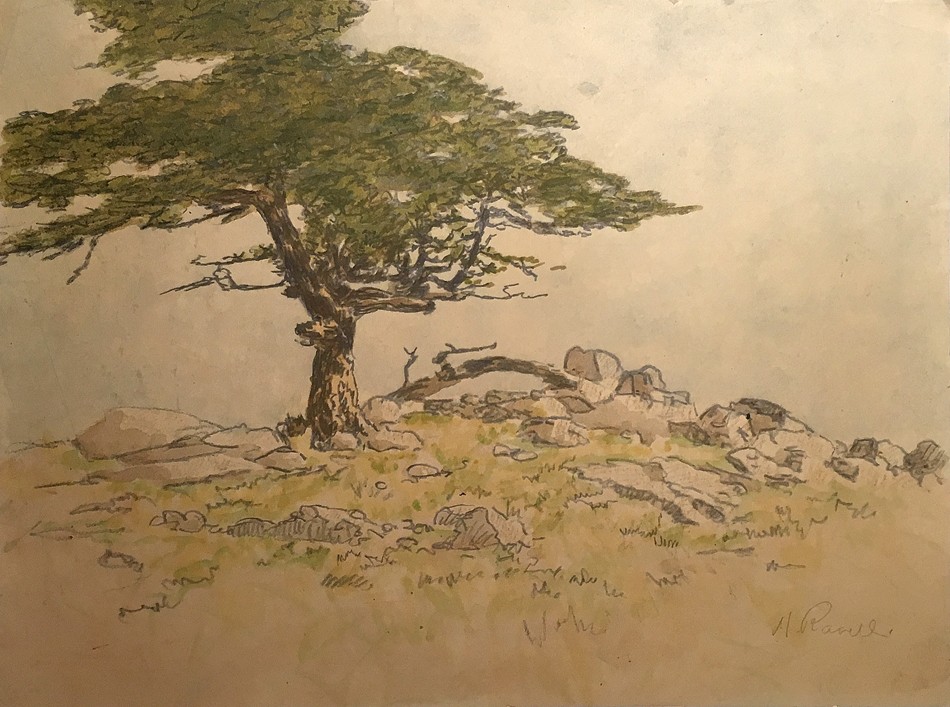 “Cypress Tree -Pebble Beach”: Henry Ravell, American: 1864-1930. Vintage watercolor drawing on paper: ca. 1915-20. (Museum of Wayne County History accession #Pi 176f with verso sticker additionally listing number 148 and $30.00) One of the few known examples of a watercolor drawing by Ravell is this delicate landscape featuring a lone cypress tree springing from a rock outcropping in Pebble Beach on California’s Monterey Peninsula. It may depict the world famous “Lone Cypress”, an approximately 250 year-old Monterey Cypress standing today on a granite hillside off the famed 17-Mile Drive. Courtesy: Museum of Wayne County History, Lyons N.Y.
“Cypress Tree -Pebble Beach”: Henry Ravell, American: 1864-1930. Vintage watercolor drawing on paper: ca. 1915-20. (Museum of Wayne County History accession #Pi 176f with verso sticker additionally listing number 148 and $30.00) One of the few known examples of a watercolor drawing by Ravell is this delicate landscape featuring a lone cypress tree springing from a rock outcropping in Pebble Beach on California’s Monterey Peninsula. It may depict the world famous “Lone Cypress”, an approximately 250 year-old Monterey Cypress standing today on a granite hillside off the famed 17-Mile Drive. Courtesy: Museum of Wayne County History, Lyons N.Y.
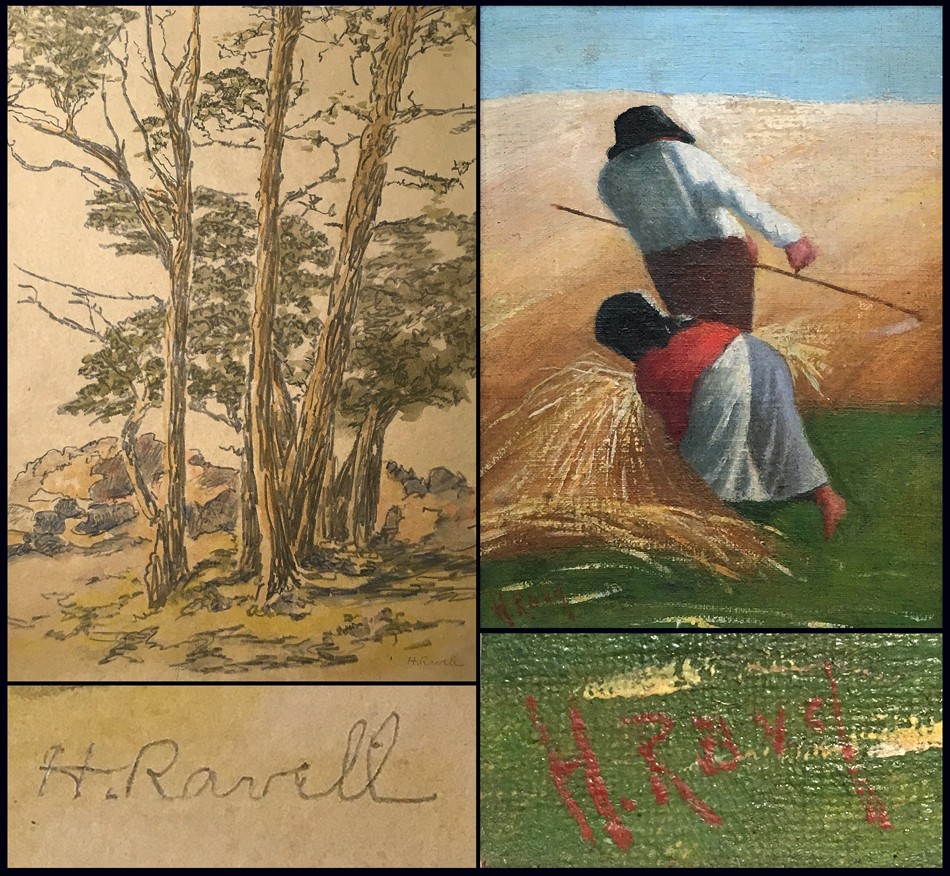 This panel reveals the artistic styles of two distinct artists signing their work nearly identically. It’s presented with the hope a distinction can be made for a larger audience. The reality at present: nearly every painting returned on web searches is misattributed to being by photographer/artist Henry Ravell. Left Diptych: Top: “Cypress Trees at Pebble Beach”: Henry Ravell, American: 1864-1930. Vintage watercolor drawing on paper: ca. 1915-20. (Museum of Wayne County History accession #Pi 176e with verso sticker additionally listing number 147 and $20.00) This is one of three rare watercolor drawings by Ravell. Showing a stand of cypress trees in Pebble Beach on California’s Monterey Peninsula, the signature of “H.Ravell” in graphite has been enlarged in separate bottom panel. Courtesy: Museum of Wayne County History. Right Diptych: Top: “The Ripers” (The Reapers): Henry Etienne Ravel, American, born Naples Italy to French citizens. (1872-1962) Oil on artists board: ca. 1946: 20.5 x 15.4 presented within wood frame (not shown) 24.5 x 19.4 x 2.0 cm. Two field workers harvest wheat, a small landscape most likely depicting the Italian countryside. Henry Ravel immigrated to America in 1906 and became a naturalized US citizen in 1920. A transportation clerk by trade in the early 1920’s, his paintings- many done in Europe- date from ca. 1930’s-1950’s. Enlarged signature at bottom panel: “H. Ravel”. From: PhotoSeed Archive
This panel reveals the artistic styles of two distinct artists signing their work nearly identically. It’s presented with the hope a distinction can be made for a larger audience. The reality at present: nearly every painting returned on web searches is misattributed to being by photographer/artist Henry Ravell. Left Diptych: Top: “Cypress Trees at Pebble Beach”: Henry Ravell, American: 1864-1930. Vintage watercolor drawing on paper: ca. 1915-20. (Museum of Wayne County History accession #Pi 176e with verso sticker additionally listing number 147 and $20.00) This is one of three rare watercolor drawings by Ravell. Showing a stand of cypress trees in Pebble Beach on California’s Monterey Peninsula, the signature of “H.Ravell” in graphite has been enlarged in separate bottom panel. Courtesy: Museum of Wayne County History. Right Diptych: Top: “The Ripers” (The Reapers): Henry Etienne Ravel, American, born Naples Italy to French citizens. (1872-1962) Oil on artists board: ca. 1946: 20.5 x 15.4 presented within wood frame (not shown) 24.5 x 19.4 x 2.0 cm. Two field workers harvest wheat, a small landscape most likely depicting the Italian countryside. Henry Ravel immigrated to America in 1906 and became a naturalized US citizen in 1920. A transportation clerk by trade in the early 1920’s, his paintings- many done in Europe- date from ca. 1930’s-1950’s. Enlarged signature at bottom panel: “H. Ravel”. From: PhotoSeed Archive
The earliest published references to Ravell’s photographic work in the popular press is found around 1905, when Boston’s Photo-Era, writing for their December issue, pronounces him “A new star of the first magnitude”, although noting his two pictures: “Pleasant Valley” and “Viga Canal”, “do not represent him at his best.” This assessment also including listing him on the journal’s noteworthy list of exhibitors whose work had been accepted for the Second American Photographic Salon which ran from 1905-06.
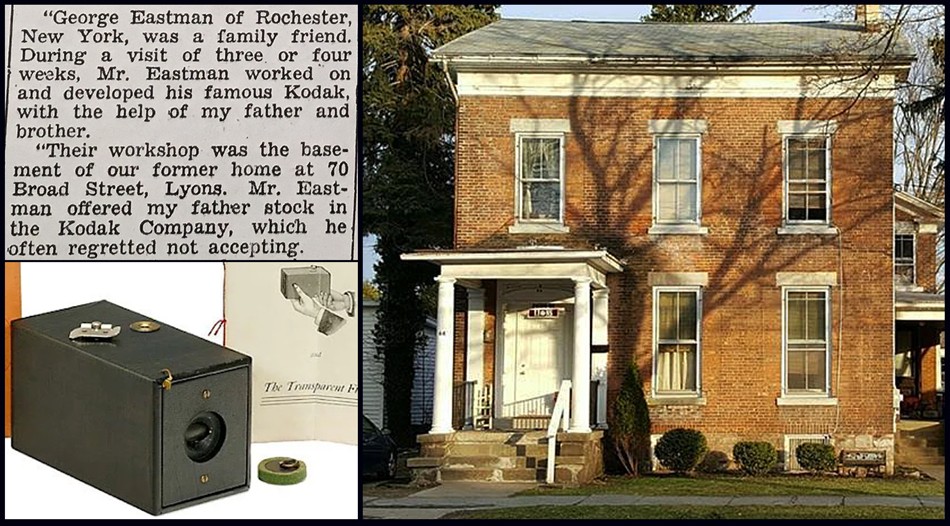 Upper Left: This quote by Henry Ravell’s older sister Florence Ravell Lothrop appeared in The Lyons Republican & Clyde Times on March 21, 1940 stating Henry and their father Charles Henry Ravell had worked with a young George Eastman in developing the world’s first Kodak camera from 1888 in the basement workshop of their Lyons home. Clipping courtesy Museum of Wayne County History. Lower Left: An original Kodak No. 1 camera from 1888 shown with its lens cap and original documents appeared as Lot 0238 and sold by Auction Team Breker of Cologne, Germany on September 30, 2006. The Metropolitan Museum of Art in New York states: “By far the most significant event in the history of amateur photography was the introduction of the Kodak #1 camera in 1888. Invented and marketed by George Eastman (1854–1932), a former bank clerk from Rochester, New York, the Kodak was a simple box camera that came loaded with a 100-exposure roll of film”. Courtesy Auction Team Breker. Far Right: Built in 1850, the former Ravell family home in Lyons, New York was actually located at 64 Broad Street-seen here: not 70 Broad Street as stated in the clipping. The actual address was confirmed by this website using Sanborn fire insurance maps and a Lyons residential street directory from 1886-7. Home exterior courtesy 2018 online real estate sales listing.
Upper Left: This quote by Henry Ravell’s older sister Florence Ravell Lothrop appeared in The Lyons Republican & Clyde Times on March 21, 1940 stating Henry and their father Charles Henry Ravell had worked with a young George Eastman in developing the world’s first Kodak camera from 1888 in the basement workshop of their Lyons home. Clipping courtesy Museum of Wayne County History. Lower Left: An original Kodak No. 1 camera from 1888 shown with its lens cap and original documents appeared as Lot 0238 and sold by Auction Team Breker of Cologne, Germany on September 30, 2006. The Metropolitan Museum of Art in New York states: “By far the most significant event in the history of amateur photography was the introduction of the Kodak #1 camera in 1888. Invented and marketed by George Eastman (1854–1932), a former bank clerk from Rochester, New York, the Kodak was a simple box camera that came loaded with a 100-exposure roll of film”. Courtesy Auction Team Breker. Far Right: Built in 1850, the former Ravell family home in Lyons, New York was actually located at 64 Broad Street-seen here: not 70 Broad Street as stated in the clipping. The actual address was confirmed by this website using Sanborn fire insurance maps and a Lyons residential street directory from 1886-7. Home exterior courtesy 2018 online real estate sales listing.
Florence Ravell, quoting Lockwood de Forest for her 1940 article on Henry, expanded on her brothers new found respect in the profession, particularly in his mastery of the gum print, which would soon establish him as a major talent:
“Henry Ravell was recognized as one of the leading artists in his profession, both in this country and in Europe where he had exhibited, and has been a contributor to many of the photographic magazines, where a description of his technical processes are given. He succeeded in making a gum print in one printing with results far beyond the finest etchings and very similar in character.”
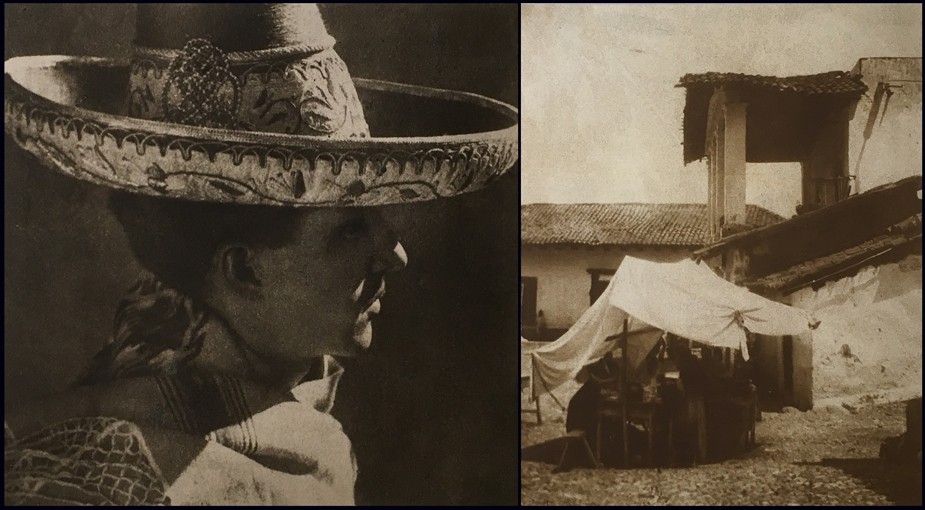 Left: “Mexican Peon”: Henry Ravell, American: 1864-1930. Vintage gum print ca. 1900-15. Alternately titled “A Mexican Peon” as listed in the catalogue of a 1978 retrospective of the artist at the Museum of Wayne County History, although an uncropped variant titled “Mexican Charro” (Mexican Cowboy)- is a more accurate description based on his fancily embroidered sombrero- is held by the California Museum of Photography, Riverside. Right: “Eating Tent-Taxco, Mexico”: Henry Ravell, American: 1864-1930. Vintage gum print ca. 1900-15. These photographs are part of a grouping of 18 singular gum prints featuring Mexican scenes and subjects held in the collection of the Museum of Wayne County History, Lyons N.Y.
Left: “Mexican Peon”: Henry Ravell, American: 1864-1930. Vintage gum print ca. 1900-15. Alternately titled “A Mexican Peon” as listed in the catalogue of a 1978 retrospective of the artist at the Museum of Wayne County History, although an uncropped variant titled “Mexican Charro” (Mexican Cowboy)- is a more accurate description based on his fancily embroidered sombrero- is held by the California Museum of Photography, Riverside. Right: “Eating Tent-Taxco, Mexico”: Henry Ravell, American: 1864-1930. Vintage gum print ca. 1900-15. These photographs are part of a grouping of 18 singular gum prints featuring Mexican scenes and subjects held in the collection of the Museum of Wayne County History, Lyons N.Y.
Henry perfected the gum bichromate process to a very high level. Probably in 1906-07, he began experimenting in multiple color gum. In Germany, around this same time, similar examples were being done by the brothers Theodor (1868-1943) and Oscar Hofmeister, (1871-1937) as well as Heinrich Wilhelm Müller (1859-1933) (3.) The following quote in the December,1908 issue of Boston’s Photo-Era encapsulates the admiration these gum prints received:
“It will be remembered that last summer Henry Ravell, of Mexico, exhibited in New York and Boston his results in multiple gum-bichromate printing in color. They excited considerable interest at the time, especially among our painters, who were very cordial in their praise of Mr. Ravell’s beautiful work, for it showed, in an eminent degree, the artistic possibilities of the gum-process.” (p. 300)
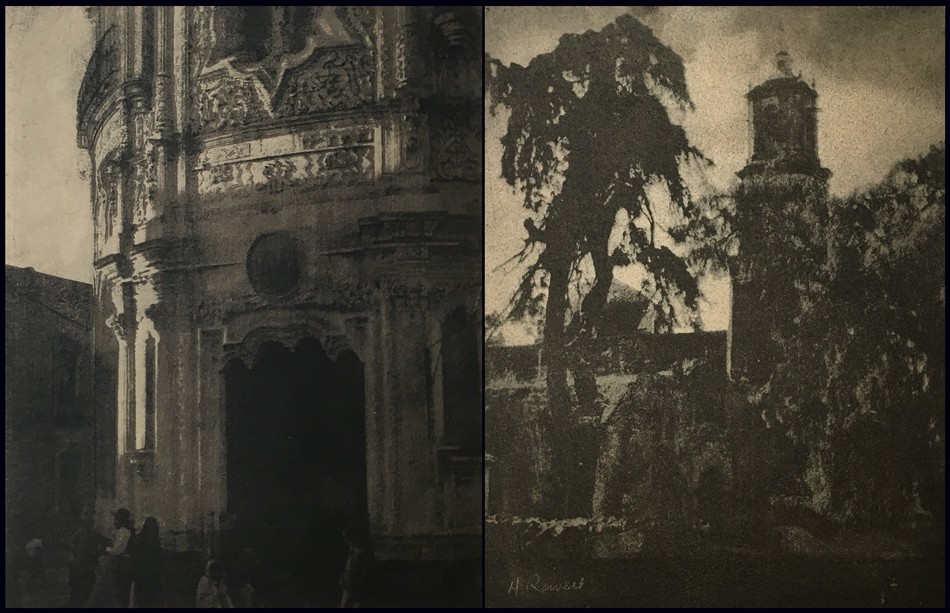 Left: “Chapel of the Holy Well near Mexico City”: Henry Ravell, American: 1864-1930. Vintage gum print ca. 1900-15. Right: “Church, Mexico”: Henry Ravell, American: 1864-1930. Vintage gum print ca. 1900-15. Museum of Wayne County History accession #Pi 176p with verso sticker additionally listing number 2 and $5.00) Featuring church architecture, these are part of a grouping of 18 singular gum prints of Mexican scenes and subjects held in the collection of the Museum of Wayne County History, Lyons N.Y.
Left: “Chapel of the Holy Well near Mexico City”: Henry Ravell, American: 1864-1930. Vintage gum print ca. 1900-15. Right: “Church, Mexico”: Henry Ravell, American: 1864-1930. Vintage gum print ca. 1900-15. Museum of Wayne County History accession #Pi 176p with verso sticker additionally listing number 2 and $5.00) Featuring church architecture, these are part of a grouping of 18 singular gum prints of Mexican scenes and subjects held in the collection of the Museum of Wayne County History, Lyons N.Y.
Again writing in 1940, Florence wrote of her younger brother: “but his favorite work was photography, and the gum print process. This process was original with an Austrian who refused to make it known, but Henry experimented until he developed it, and later gave the formula to the world.” The conjecture of this website is the possibility Henry originally gleaned and modified his own multiple gum color process from the earlier work of Austrian photographer Heinrich Kühn. (1866-1944) An 1897 example of a three-color gum print by him can be found in the collection of the Museum für Kunst und Gewerbe in Hamburg Germany.
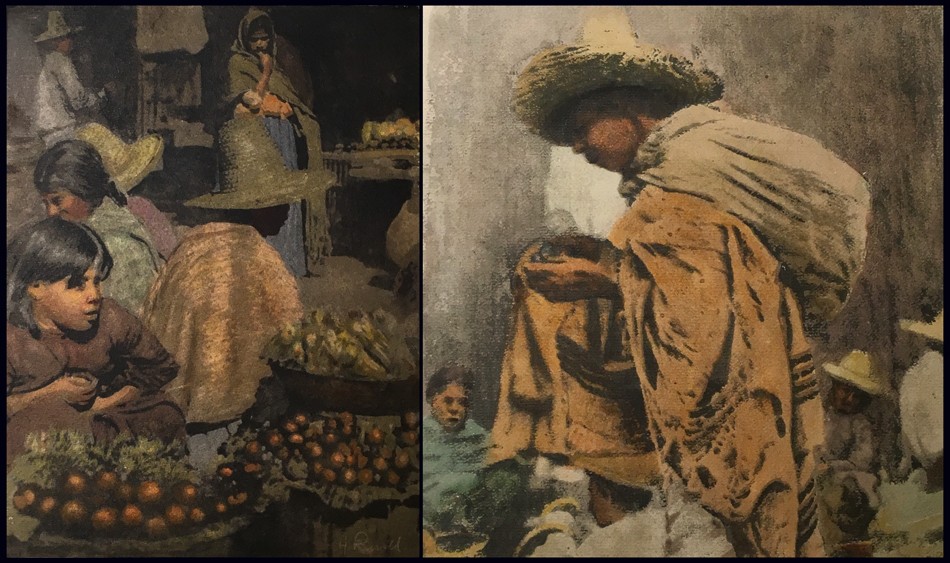 Left: “Mexican Vegetable Seller”: Henry Ravell, American: 1864-1930. Vintage multiple color gum print c. 1907-14. Right: “Mexican Youth”: Henry Ravell, American: 1864-1930. Vintage multiple color gum print c. 1907-14. These are two of the three rare multiple color gum prints by Henry Ravell held in the collection of the Museum of Wayne County History, Lyons N.Y.
Left: “Mexican Vegetable Seller”: Henry Ravell, American: 1864-1930. Vintage multiple color gum print c. 1907-14. Right: “Mexican Youth”: Henry Ravell, American: 1864-1930. Vintage multiple color gum print c. 1907-14. These are two of the three rare multiple color gum prints by Henry Ravell held in the collection of the Museum of Wayne County History, Lyons N.Y.
In 1908, Henry’s champion Lockwood de Forest gave a fuller explanation of the technical details for this color process, as part of copy included with a series of Mexican Church studies published in the May issue of the Century Illustrated Monthly Magazine:
“Last summer he started experiments in color-printing. His process is simple. Instead of introducing colors on the negatives, as in the lumière process, he is using the colors in the sensitizer of the printing paper. The specimens he has sent me are printed in three or four colors. Each print is finished, recoated all over with the sensitizer with the next color, and again printed. This is done for each color separately, the black print coming last, as in the regular color-printing process.”
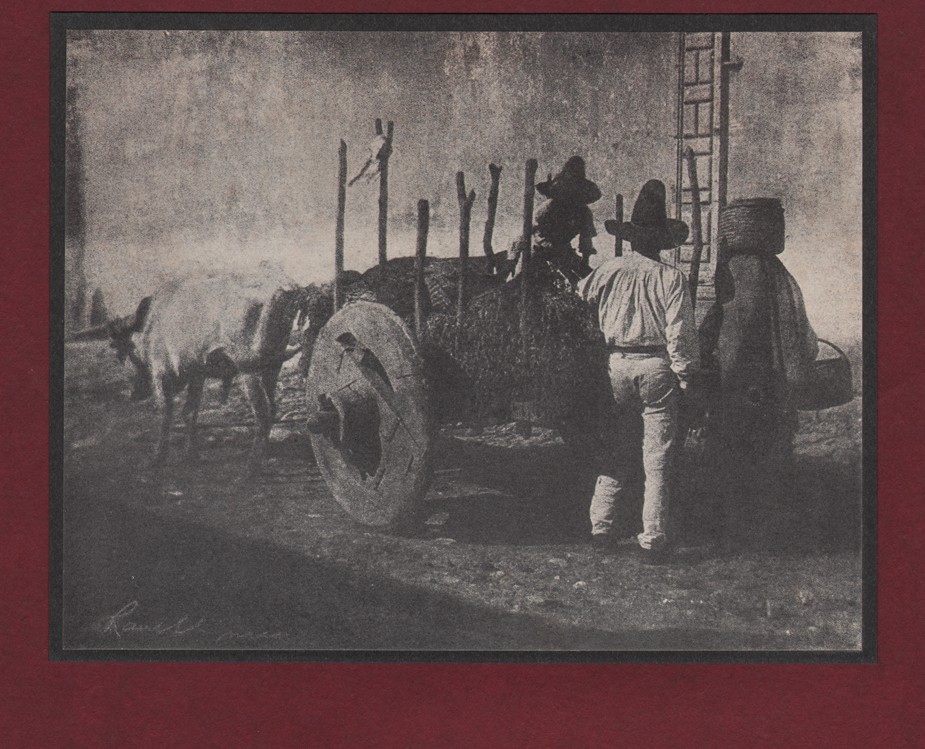 “An Ox Cart” (Mexico): Henry Ravell, American: 1864-1930. 1905: Vintage halftone tipped to mount: 16.6 x 21.4 | 17.4 x 22.2 | 45.0 x 30.5 cm “This mount is Sultan Bokhara and Royal Melton Egyptine Made by the Niagara Paper Mills”. Taken in Mexico ca. 1900-05, this is one of the earliest published examples of a Ravell photograph to appear in the popular press. It was included in the luxury portfolio publication “Art in Photography” issued by the Photo Era Publishing Company of Boston. From: PhotoSeed Archive
“An Ox Cart” (Mexico): Henry Ravell, American: 1864-1930. 1905: Vintage halftone tipped to mount: 16.6 x 21.4 | 17.4 x 22.2 | 45.0 x 30.5 cm “This mount is Sultan Bokhara and Royal Melton Egyptine Made by the Niagara Paper Mills”. Taken in Mexico ca. 1900-05, this is one of the earliest published examples of a Ravell photograph to appear in the popular press. It was included in the luxury portfolio publication “Art in Photography” issued by the Photo Era Publishing Company of Boston. From: PhotoSeed Archive
Ravell continued to work in Mexico until about 1914, when it is believed he moved back to the Los Angeles area of California in order to escape the Civil War (Mexican Revolution) then engulfing the country. A short biography included in the 1978 volume Pictorial Photography in Britain 1900-1920 gives 1916 as a slightly later date, although it was likely he was traveling back and forth from Mexico to the U.S. several times during this tumultuous time:
“In 1916 an article entitled “Cathedrals of Mexico”, illustrated by his work, was published in Harper’s magazine. About this time he left Mexico, almost as a refugee. His studio in Cuernavaca was destroyed by rebels. He moved to California where he began to photograph near Carmel and settled at Santa Barbara.”
Now that this American born “refugee” was back in his home country for good, he immediately set out photographing the beauty of the southern California coastline, with an emphasis on capturing the numerous entanglements of old cypress trees set against the landscape and Pacific Ocean. Conveniently, and perhaps not coincidentally, Lockwood de Forest had moved permanently to Santa Barbara in 1915 after wintering in the area since 1902, with his professional connections to the world of art giving Henry and his work credibility and entrance to a larger audience. These included retrospective exhibitions of nearly 100 framed works of his Mexican and California subjects at major American institutions. These began in October, 1918 at the Pratt Institute Art Gallery in Brooklyn and continued into 1919 at the Albright Art Gallery in Buffalo, New York followed by shows the same year at the newly opened Cleveland Museum of Art and then at the Chicago Art Institute.
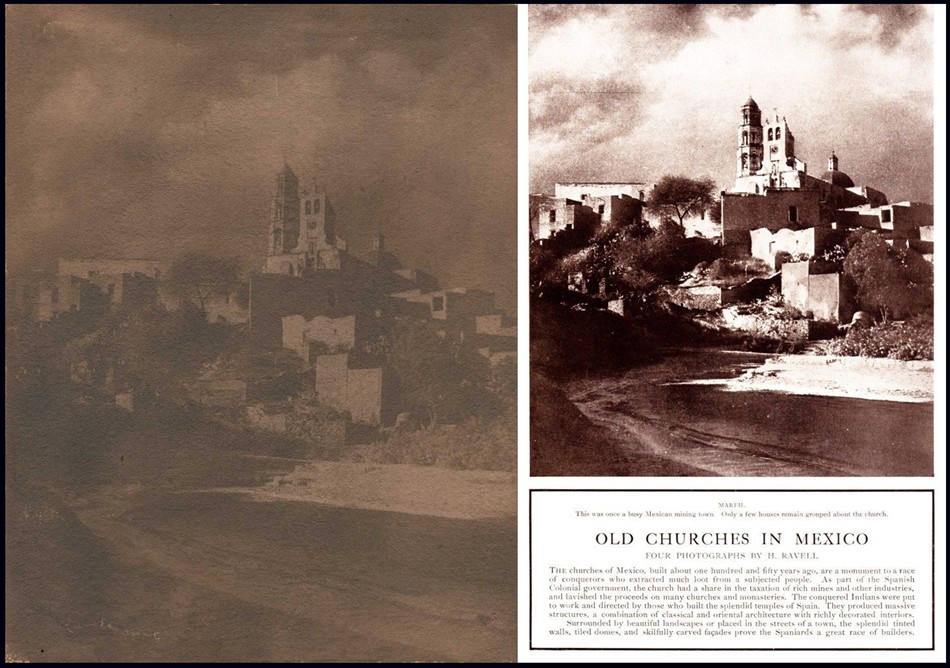 Left: “Marfil: Templo De Marfil De Arriba”: Henry Ravell, American: 1864-1930. Vintage gum print c. 1900-10: 37.4 x 29.0 cm. Still standing today, this church constructed in the Baroque style is located in Marfil, a suburb of the central Mexican city of Guanajuato. The church is colloquially known as “La Iglesia de Arriba”, or the “Church up Top”. From: PhotoSeed Archive Right: Four photographs of Mexican churches by Henry Ravell, including the Templo De Marfil De Arriba photograph, were published in the February, 1914 issue of Century Magazine for a picture spread titled “Old Churches in Mexico”: “The churches of Mexico, built about one hundred and fifty years ago, are a monument to a race of conquerors who extracted much loot from a subjected people. As part of the Spanish Colonial government, the church had a share in the taxation of rich mines and other industries, and lavished the proceeds on many churches and monasteries. The conquered Indians were put to work and directed by those who built the splendid temples of Spain. They produced massive structures, a combination of classical and oriental architecture with richly decorated interiors. Surrounded by beautiful landscapes or placed in the streets of a town, the splendid tinted walls, tiled domes, and skilfully carved facades prove the Spaniards a great race of builders.” From: Internet Archive
Left: “Marfil: Templo De Marfil De Arriba”: Henry Ravell, American: 1864-1930. Vintage gum print c. 1900-10: 37.4 x 29.0 cm. Still standing today, this church constructed in the Baroque style is located in Marfil, a suburb of the central Mexican city of Guanajuato. The church is colloquially known as “La Iglesia de Arriba”, or the “Church up Top”. From: PhotoSeed Archive Right: Four photographs of Mexican churches by Henry Ravell, including the Templo De Marfil De Arriba photograph, were published in the February, 1914 issue of Century Magazine for a picture spread titled “Old Churches in Mexico”: “The churches of Mexico, built about one hundred and fifty years ago, are a monument to a race of conquerors who extracted much loot from a subjected people. As part of the Spanish Colonial government, the church had a share in the taxation of rich mines and other industries, and lavished the proceeds on many churches and monasteries. The conquered Indians were put to work and directed by those who built the splendid temples of Spain. They produced massive structures, a combination of classical and oriental architecture with richly decorated interiors. Surrounded by beautiful landscapes or placed in the streets of a town, the splendid tinted walls, tiled domes, and skilfully carved facades prove the Spaniards a great race of builders.” From: Internet Archive
Henry Ravell would continue to exhibit his work late into the 1920’s at smaller venues, one example being a tri-colored gum print titled “Mexican Peon Boy” shown at the 1927 Los Angeles Salon and remarked on by Camera Craft, his gum prints deemed “for which he has gained a warranted renown”. Gum printing was indeed so important to the artist that he listed “Gum Printer” as his occupation for the 1920 U.S. Census.
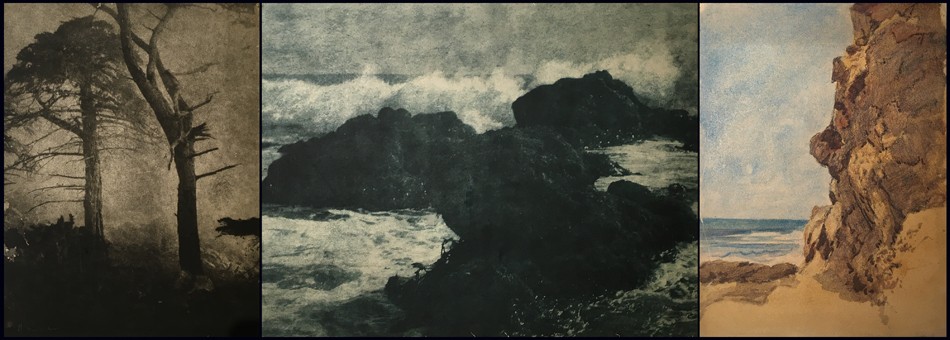 Left: “Pine and Cypress, Pebble Beach”: Henry Ravell, American: 1864-1930. Vintage gum print ca. 1915-20. (Museum of Wayne County History accession #Pi 176a with verso sticker additionally listing number 17 and $3.00) Middle: “Big Splash” (California coastline) Henry Ravell, American: 1864-1930. Vintage gum print ca. 1915-20. (Museum of Wayne County History accession #Pi 176m with verso sticker additionally listing number 122 and $12.00) Right: “Untitled Marine Landscape” (Mexico or California): Henry Ravell, American: 1864-1930. Vintage multiple colored gum print ca. 1907-1920. (Museum of Wayne County History accession #Pi 176n with verso sticker additionally listing number 156 ) All: Courtesy Museum of Wayne County History, Lyons N.Y.
Left: “Pine and Cypress, Pebble Beach”: Henry Ravell, American: 1864-1930. Vintage gum print ca. 1915-20. (Museum of Wayne County History accession #Pi 176a with verso sticker additionally listing number 17 and $3.00) Middle: “Big Splash” (California coastline) Henry Ravell, American: 1864-1930. Vintage gum print ca. 1915-20. (Museum of Wayne County History accession #Pi 176m with verso sticker additionally listing number 122 and $12.00) Right: “Untitled Marine Landscape” (Mexico or California): Henry Ravell, American: 1864-1930. Vintage multiple colored gum print ca. 1907-1920. (Museum of Wayne County History accession #Pi 176n with verso sticker additionally listing number 156 ) All: Courtesy Museum of Wayne County History, Lyons N.Y.
The Albright Art Gallery was an important venue for Ravell’s work, considering the groundbreaking exhibition it previously hosted in November, 1910: the International Exhibition of Pictorial Photography. Organized by the Photo-Secession under the direction of Alfred Stieglitz, it was “the first exhibition held at an American museum that aimed to elevate photography’s stature from a purely scientific pursuit to a visual form of artistic expression.” Even nine years later, in 1919, at a time when museum shows devoted to the work of a singular photographer anywhere in the world were still few and far between and remained so decades later, it’s refreshing in the present to read observations by one curator remarking on Ravell’s 93 framed photographs displayed at the Albright gallery for Academy Notes, the mouthpiece for The Buffalo Fine Arts Academy:
“THE collection of photographs by H. Ravell—which was on view in the gallery during the last week in February and all of March—is very unique and valuable. These photographs are technically known as gum-prints and have all the painter’s quality in their execution. They do not impress one as photographs but rather as work directly from the artist’s brush. The photographs were made by H. Ravell who is now in Santa Barbara. Many of the pictures were taken near Carmel, California, a seashore of much variety where the fantastic cypress trees with their twisted dramatic forms produce wonderful compositions against sea and sky.” …This is but a short description of the remarkable exhibition of photographs shown at the Albright Art Gallery. It was seen by many art lovers and appreciated especially by all of those interested in artistic photography.” (4.)
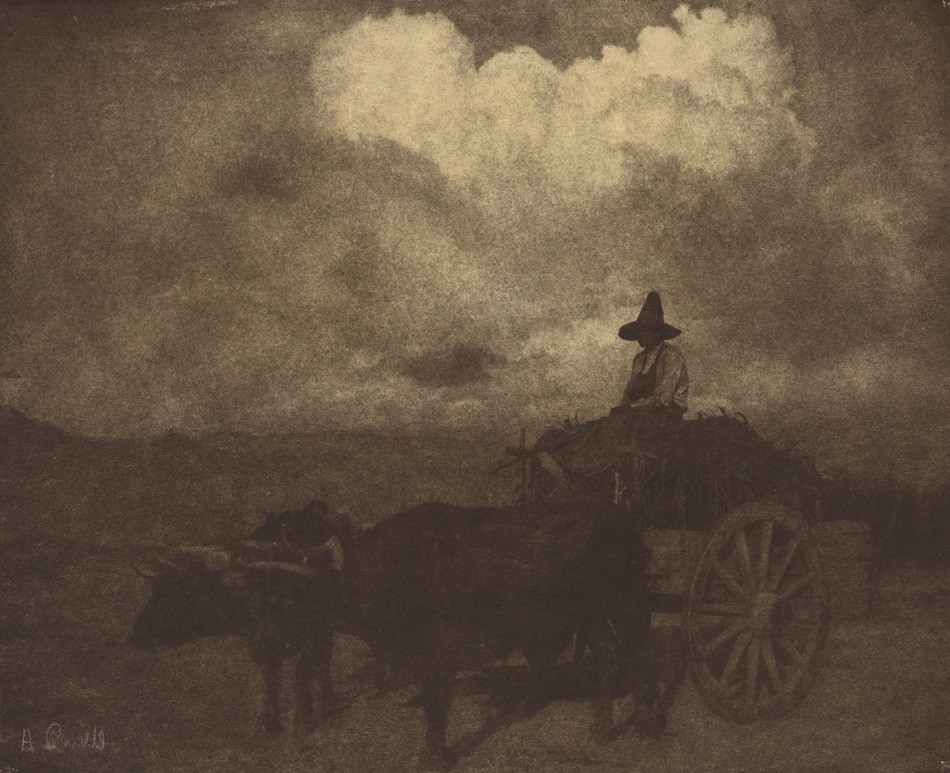 “Ox Cart- Sunset”: Henry Ravell, American: 1864-1930. Vintage gum print ca. 1900-10. Image: 27.0 x 32.6 cm presented loose within dark brown paper folder with overall support dimensions of 58.8 x 36.7 cm. Wearing a traditional sombrero hat, (Sombrero de charro) the driver of this ox or bullock cart pauses atop a full load of what looks like hay or silage. This Mexican scene may date to around 1905-consistent with a different view by the artist of an ox cart published that year in “Art in Photography” by the the Photo Era Publishing Company of Boston. From: PhotoSeed Archive
“Ox Cart- Sunset”: Henry Ravell, American: 1864-1930. Vintage gum print ca. 1900-10. Image: 27.0 x 32.6 cm presented loose within dark brown paper folder with overall support dimensions of 58.8 x 36.7 cm. Wearing a traditional sombrero hat, (Sombrero de charro) the driver of this ox or bullock cart pauses atop a full load of what looks like hay or silage. This Mexican scene may date to around 1905-consistent with a different view by the artist of an ox cart published that year in “Art in Photography” by the the Photo Era Publishing Company of Boston. From: PhotoSeed Archive
A reevaluation of Henry Ravell’s body of work is important to consider in the present given the broad acknowledgement of his talent by major institutions and the popular press for the benefit of many large audiences over 100 years ago. An important pictorialist photographer who was also a painter, Henry Ravell was a striver and apprentice graduate inspired by his father’s steady trade in the New York state village of Lyons who embraced a love for craft and mastery of art. Together, these skills gave him the passion to embrace adventure in capturing the beauty in far-off Mexico and southern California for the ages.
Four original gum prints in the PhotoSeed Archive can be seen here, each listing an expanded biography, timeline and major institutional holdings for the artist.
Afterword | Notes
A conundrum on internet research into Henry Ravell’s artistic output reveals itself quickly. The bottom line is that most every painting on the web attributed to Henry Ravell the photographer is not by him. Instead, through PhotoSeed’s research and purchase of the small painting: “The Ripers”, (The Reapers) the true identity of this artist can now be revealed as Henry Etienne Ravel. (1872-1962) Born in Naples Italy to French citizens, Henry Ravel immigrated to America in 1906 and became a naturalized US citizen in 1920. A transportation clerk by trade in the early 1920’s, his paintings- many done in Europe- date from ca. 1930’s-1950’s. What causes the confusion is that like Henry Ravell the photographer, who signed his photographs “H. Ravell”, Henry Ravel the painter also signed his work similarly, but as “H. Ravel” Numerous examples of his paintings show up on Google searches-unlike the real and quite rare examples of watercolors done by Ravell the photographer. I’ve included links to some of these paintings on the page showing “The Ripers”. As always- buyer beware and do your homework!
1. C. Ravel won a $3.00 premium for “Best Daguerreotypes” during the Annual Fair of the Madison County Agricultural Society held at Morrisville, (N.Y.) on the 15th, 16th and 17th days of September,1857 according to a newspaper account in the Cazenovia Republican. Shout out to the Pioneer American Photographers 1839-1860 website. Langdon’s List of 19th & Early 20th Century Photographers additionally list Ravel working in Manlius, New York in the 1859 N.Y. State Business Directory.
2. See: The Lyons Republican & Clyde Times: Lyons, N.Y. Thursday, March 21, 1940. Article excerpts: HENRY RAVELL: “Resided in Lyons for twenty-eight years, died in Los Angeles California, January 20, 1930. This account was written by his sister, Mrs. Florence Ravell Lothrop, of 721 Fifth Street North, St. Petersburg, Florida.: “Henry had no special training in any school or under any masters except my father, Charles Herring Ravel, who was born in Boston, England, and became one of the first photographers in the United States. His forbears came over with William the Conqueror to England, which accounts for the one “L” in the name. My mother was annoyed because most people called her Mrs. Rav’-el and persuaded my father to add “L”, so the family adopted that spelling of our name.…Henry studied and experimented all his life. His photographic subjects were portraits, landscapes, street scenes, trees, cloud and moonlight effects. His Mexican Cathedrals were especially noteworthy. He used both oils and water colors, but his favorite work was photography, and the gum print process. This process was original with an Austrian who refused to make it known, but Henry experimented until he developed it, and later gave the formula to the world. I remember seeing around his studio, pans of water about three inches deep. The photo-print was put into the water and pigments of paint dropped on it, this gave the effect when completed of a soft beautiful painting. My description to an artist will seem crude but that is as I recall it.…Henry never taught, that is, acted as a teacher in any school, and I do not know what societies he belonged. He exhibited in the Pittsburgh, Pennsylvania, Salon about 1907. From the thousands of photographs submitted, three of his were among the 237 accepted. His work was exhibited at the Salmagundi Club, New York City; Thurber’s and Anderson’s Galleries in Chicago, Los Angeles, California, and many, many other places. Fifteen of his photographs are at the Metropolitan Museum, New York City. Seven are Mexican subjects and eight are California trees. These were selected by Forest Lockwood.(sic) After Henry’s death at Los Angeles, California, in 1930, a request came for him to send an exhibit to the Fifth International Photographic Salon of Japan held at Tokyo and Osaka in May, 1931.”
3. In the December, 1908 issue of Boston’s Photo-Era, a short article titled “Gum-Prints In Colors” appeared, linking Ravell’s gum prints as being similar to “a collection of prints by the same process, probably with modifications” to work done by the Hofmeister brothers and Müller. These German works were shown at the offices of The British Journal of Photography in London’s Strand from September 28- October 24, 1907.
4. See: Academy Notes: The Buffalo Fine Arts Academy: Albright Art Gallery: Buffalo, New York: vol. XIV: Jan.-Oct. 1919, p. 67
The New Decade Roars In
Posted January 2020 in Childhood Photography, Painters|Photographers, Photography
From the Trenches a Century On
Posted November 2018 in Advertising, History of Photography, Photography, Significant Photographs, Unknown Photographers
For your consideration, we offer a happier vision of patriotic leanings supporting the home-front on this milestone day in history marking the end of World War 1.
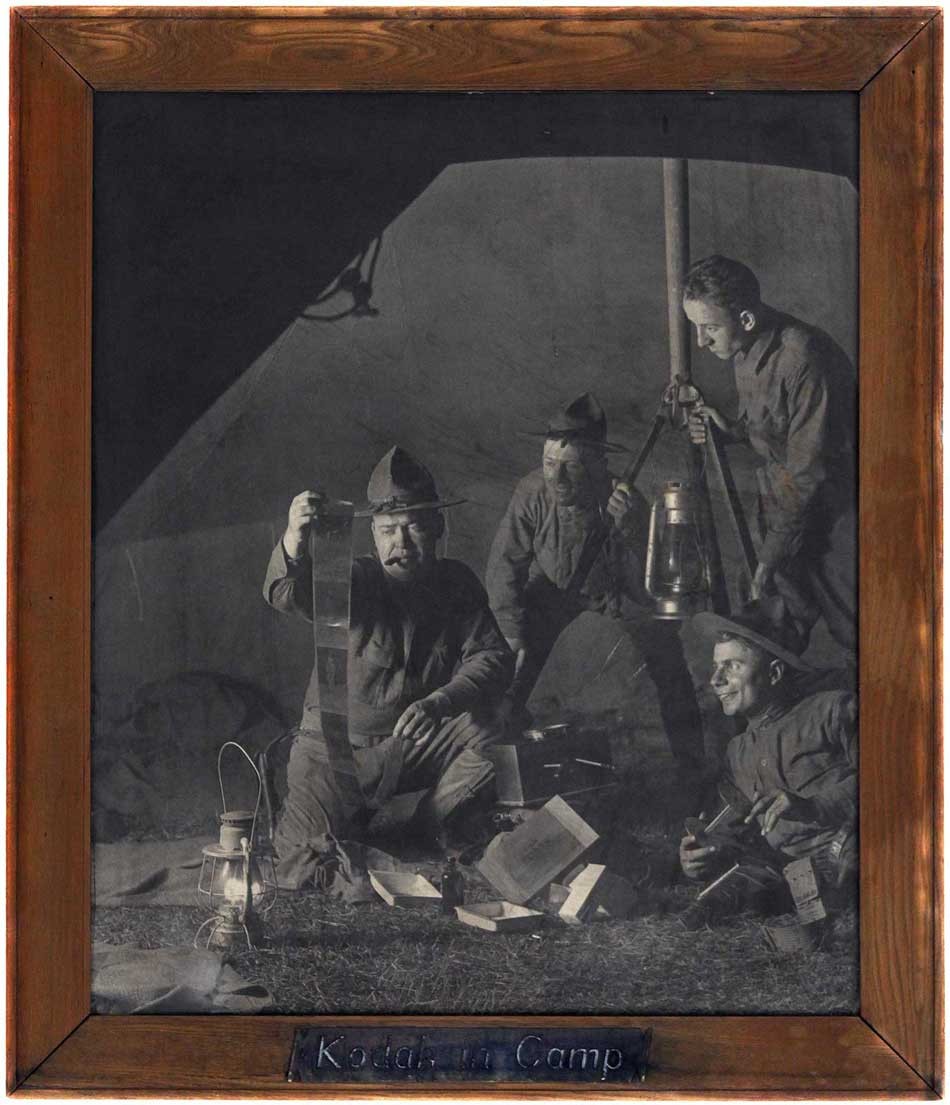 "Kodak in Camp": vintage framed bromide print ca. 1917 by unknown American photographer: Image Dimensions: 71.4 x 60.0 | cm 83.2 x 71.8 cm stained oak frame. This rare mammoth-sized Kodak advertising photograph featuring American “Doughboys” working together developing film in their tent at night was used by the Eastman company in their “Take a KODAK With You” advertising campaign. In late 1917, it appeared in publications including The Saturday Evening Post and The Independent (with which is incorporated Harpers Weekly) From: PhotoSeed Archive
"Kodak in Camp": vintage framed bromide print ca. 1917 by unknown American photographer: Image Dimensions: 71.4 x 60.0 | cm 83.2 x 71.8 cm stained oak frame. This rare mammoth-sized Kodak advertising photograph featuring American “Doughboys” working together developing film in their tent at night was used by the Eastman company in their “Take a KODAK With You” advertising campaign. In late 1917, it appeared in publications including The Saturday Evening Post and The Independent (with which is incorporated Harpers Weekly) From: PhotoSeed Archive
On the Eleventh Hour of the Eleventh Day of the Eleventh Month- November 11, 1918, the signing of the Armistice ending the Great War took place 60 kilometers north of Paris inside a railway carriage parked in the Forest of Compiègne. It has now been 100 years since that fateful day, on that fateful month and on that fateful hour. Sadly, mankind seems doomed to repeat his failures.
But a pivoting to Photography in relation to these weighty issues will always be of interest to the historian.
In 1914, the role of the medium expanded greatly at the outset of World War 1. In addition to photography’s new found power through smaller cameras to document unspeakable human suffering and death by the millions brought about by trench warfare, aerial reconnaissance photography gave countries the ability to monitor troop movements and to devise strategy in nearly real time. And then there was the home-front. The Eastman Kodak Company was certainly not going to let a war get in the way in order to call attention to their brand and sell more product.
Retooling like other large concerns in order to become an essential military contractor, they saw American Doughboys entering the war late in the conflict as brand ambassadors. As proof, the Kodak Vest Pocket camera, which debuted in 1912, found its’ way onto the front lines and trenches of many battlefields-legally or otherwise, and advertising posters hawking the camera as well as this oversized framed bromide print of soldiers for darkroom supplies and film called Kodak in Camp prominently appeared displayed in camera shops throughout the country.
And Kodak went further. As part of their national print advertising campaign dubbed “Take a KODAK with you”, this photo of nighttime developing in camp appeared full page in the pages of the Saturday Evening Post magazine for their August 4, 1917 issue as well as other publications around that time.
But most importantly, we honor the memory today of all the fallen. In a tribute to just one, a Scottish photographer by the name of Nichol Elliot, whose 1917 death in wartime Belgium is memorialized by a volume of his pictorial photographs accompanied by poems written by his wife Alice Elliot, we give her final stanza from An Idyll of Peace:
How swift from summer idylls came the wrench
Of life flung thence, by war and manhood’s will,
To battle roar and glare, or deathly chill
Of watch and warfare in the nightmare trench!
For peace divine man paid diviner price ⎯
In world-wide idyll of high sacrifice.
-Paired with Nichol Elliot photograph: In the Island, Toronto
For additional background on photography and the Great War, check out this New York Times Lens blog post from 2014.
Kodak City: the Sequel
Posted April 2018 in Cameras, Conservation, Exhibitions, History of Photography, Photographic Preservation, Photography, Publishing
Speaking of photography in general, of which this website is particularly enamored of, our recent visit to Rochester, New York and attendance in the three-day conference “PhotoHistory/PhotoFuture” sponsored and organized by RIT Press and The Wallace Center at the Rochester Institute of Technology gave new meaning to their claims for the medium: “there has never been more of it than there is today.” That might be stating the obvious, especially in 2018, but the new meaning part was my own takeaway and inspiration.
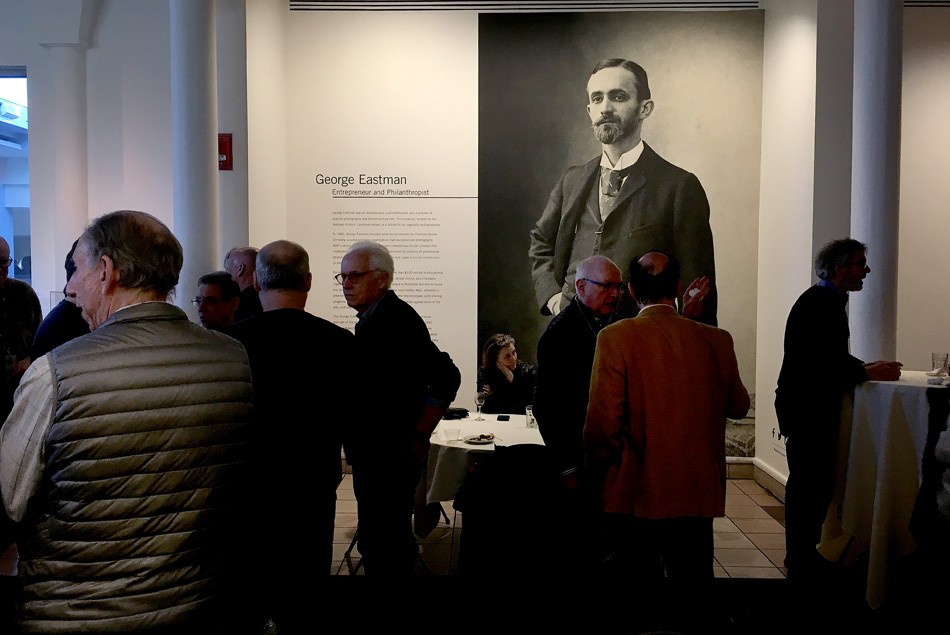 By George, Still Relevant: During a reception at the George Eastman Museum for conference attendees, a young George Eastman,(1854-1932) who founded the Eastman Kodak Company, looms larger than life in a photograph taken in 1890 by Nadar. Entrepreneur and Philanthropist are emphasized on the wall label, and with good reason. From the museum's website:"The George Eastman Museum is located in Rochester, New York, on the estate of George Eastman, the pioneer of popular photography and motion picture film. Founded in 1947 as an independent nonprofit institution, it is the world’s oldest photography museum and one of the oldest film archives. The museum holds unparalleled collections—encompassing several million objects—in the fields of photography, cinema, and photographic and cinematographic technology, and photographically illustrated books. The institution is also a longtime leader in film preservation and photographic conservation." David Spencer for PhotoSeed Archive
By George, Still Relevant: During a reception at the George Eastman Museum for conference attendees, a young George Eastman,(1854-1932) who founded the Eastman Kodak Company, looms larger than life in a photograph taken in 1890 by Nadar. Entrepreneur and Philanthropist are emphasized on the wall label, and with good reason. From the museum's website:"The George Eastman Museum is located in Rochester, New York, on the estate of George Eastman, the pioneer of popular photography and motion picture film. Founded in 1947 as an independent nonprofit institution, it is the world’s oldest photography museum and one of the oldest film archives. The museum holds unparalleled collections—encompassing several million objects—in the fields of photography, cinema, and photographic and cinematographic technology, and photographically illustrated books. The institution is also a longtime leader in film preservation and photographic conservation." David Spencer for PhotoSeed Archive
In present day Kodak city, the power of ideas relating to what made this place significant as an imaging industrial behemoth still exists, but has now gone in a new direction. With all due apologies, but the pun indeed appropriate, a snapshot of those ideas put forth by the conference attendees and speakers shows their passion for the medium’s minutiae both preserves and continues this essential democratic language. Those of memories past surely, but more and more the future in the form of ones and zeroes hurtling forward.
Although the “Big Yellow” of Rochester’s past is long gone, the ideas nourishing photography’s entire corpus continues apace, an alternate reality both present and future. For those curious enough, the RIT conference program along with a list of presenters can be found here, along with a few photos from the weekend courtesy of yours truly. David Spencer-
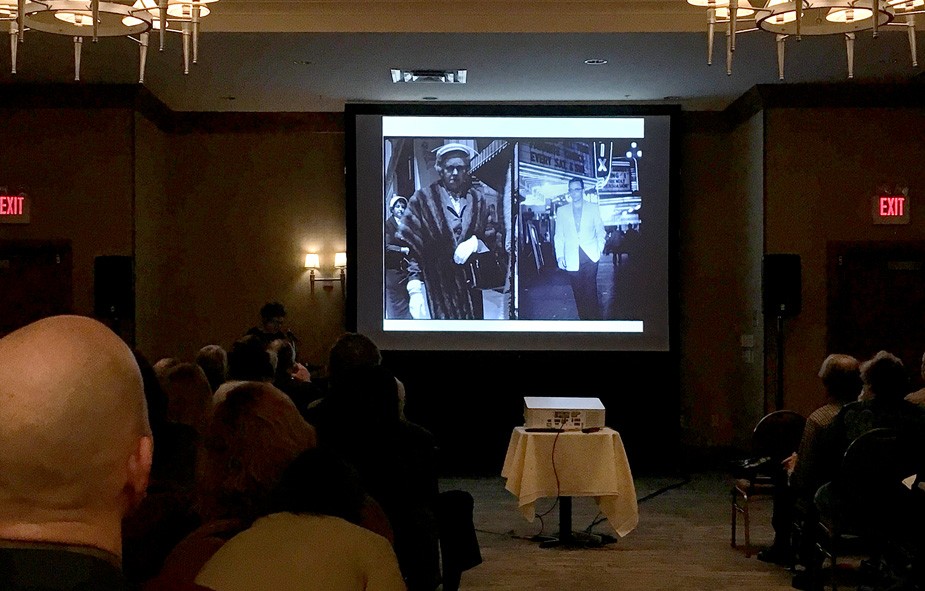 Documentary photography practiced as commerce on busy streets around the world, a genre roughly known as "Movie Snaps" because of the retrofitted movie cameras used in their making, was part of a fascinating presentation under the working title “Street Vendor Portraits Around the World: Czernowitz, Capetown, San Francisco, More!” given by independent scholar Mary Panzar of Rochester. Here, the hybrid look of Winogrand meeting Arbus becomes a document in a projected frame of a woman sporting fur and white gloves at left while a gentleman unaware at right emerges to flash and instant celebrity from a movie theatre on a nighttime street. David Spencer for PhotoSeed Archive
Documentary photography practiced as commerce on busy streets around the world, a genre roughly known as "Movie Snaps" because of the retrofitted movie cameras used in their making, was part of a fascinating presentation under the working title “Street Vendor Portraits Around the World: Czernowitz, Capetown, San Francisco, More!” given by independent scholar Mary Panzar of Rochester. Here, the hybrid look of Winogrand meeting Arbus becomes a document in a projected frame of a woman sporting fur and white gloves at left while a gentleman unaware at right emerges to flash and instant celebrity from a movie theatre on a nighttime street. David Spencer for PhotoSeed Archive
 Triptych in the Dark: Left: During his presentation “Did Talbot Make Daguerreotypes?”, the eminence of English photography pioneer William Henry Fox Talbot (1800-1877) is shown here by an image most in attendance had seen, yet Grant Romer- formerly of the Eastman House but now Founding Director of the Academy of Archaic Imaging, challenged us with another view: a decidedly unflattering profile of the paper/negative pioneer he rightly remarked might have made for a different public perception for the emerging medium had it been the lone evidence of his existence. Middle: a quote of photographic philosophy by American writer Susan Sontag (1933-2004) struck this observer as particularly relevant in the present day- University of Illinois Springfield professors Kathy Petitte Novak and Brytton Bjorngaard used it as supporting evidence while speaking on “The Blurring Distinctions of Taking versus Making Photographs: Teaching Photography in a Digital Culture”. Right: the appropriated late Victorian era reality of the dark underbelly of a small Wisconsin town through the lens of Black River Falls photographer Charles Van Schaik repurposed by author Michael Lesy in his 1973 cult classic "Wisconsin Death Trip" was supporting material for Nicolette Bromberg of the University of Washington, who argued photographic archivists need to understand context in her paper “Loss of Vision: How Art Historians and Critics Misjudge Early 20th Century Photography and How Early Photographers Along with Art Museums and Archives Help to Obscure the Photographic Record”. David Spencer for PhotoSeed Archive
Triptych in the Dark: Left: During his presentation “Did Talbot Make Daguerreotypes?”, the eminence of English photography pioneer William Henry Fox Talbot (1800-1877) is shown here by an image most in attendance had seen, yet Grant Romer- formerly of the Eastman House but now Founding Director of the Academy of Archaic Imaging, challenged us with another view: a decidedly unflattering profile of the paper/negative pioneer he rightly remarked might have made for a different public perception for the emerging medium had it been the lone evidence of his existence. Middle: a quote of photographic philosophy by American writer Susan Sontag (1933-2004) struck this observer as particularly relevant in the present day- University of Illinois Springfield professors Kathy Petitte Novak and Brytton Bjorngaard used it as supporting evidence while speaking on “The Blurring Distinctions of Taking versus Making Photographs: Teaching Photography in a Digital Culture”. Right: the appropriated late Victorian era reality of the dark underbelly of a small Wisconsin town through the lens of Black River Falls photographer Charles Van Schaik repurposed by author Michael Lesy in his 1973 cult classic "Wisconsin Death Trip" was supporting material for Nicolette Bromberg of the University of Washington, who argued photographic archivists need to understand context in her paper “Loss of Vision: How Art Historians and Critics Misjudge Early 20th Century Photography and How Early Photographers Along with Art Museums and Archives Help to Obscure the Photographic Record”. David Spencer for PhotoSeed Archive
 Photographic Preservation: With a mission statement stating they are the "world leader in the development and deployment of sustainable practices for the preservation of images and cultural heritage", conference attendees toured the Image Permanence Institute, (www.imagepermanenceinstitute.org) which opened in 1985 as an academic research laboratory within the College of Imaging Arts and Sciences at RIT. For many visitors, IPI is known for their Graphics Atlas, (www.graphicsatlas.org) an online resource that helps identify photographic and other process print types. In front of a table with various displayed print types including a row of portraits toned with Polysulfide & Selenium Toner, Institute senior research scientist Douglas Nishimura at left chats with a visitor. David Spencer for PhotoSeed Archive
Photographic Preservation: With a mission statement stating they are the "world leader in the development and deployment of sustainable practices for the preservation of images and cultural heritage", conference attendees toured the Image Permanence Institute, (www.imagepermanenceinstitute.org) which opened in 1985 as an academic research laboratory within the College of Imaging Arts and Sciences at RIT. For many visitors, IPI is known for their Graphics Atlas, (www.graphicsatlas.org) an online resource that helps identify photographic and other process print types. In front of a table with various displayed print types including a row of portraits toned with Polysulfide & Selenium Toner, Institute senior research scientist Douglas Nishimura at left chats with a visitor. David Spencer for PhotoSeed Archive
 Conference participants attended the exhibition "The Luminous Print: An Appreciation of Photogravure" organized by David Pankow, Curator Emeritus for the Cary Graphic Arts Collection at RIT now running through June 15, 2018. With beginnings in intaglio printing by artists working in the late 15th Century, photogravure's historical timeline which evolved by the 19th Century as a medium for "images from real life" is showcased by superb examples featuring plates from bound volumes, portfolios and individual works. The pleasure in real life can be seconded by this attendee, with the following observation from the catalogue true to form: "enjoy this exhibition for the beauty of its images alone and discover why it has been said that a photogravure print is endowed with a luminosity unequalled by any other process."David Spencer for PhotoSeed Archive
Conference participants attended the exhibition "The Luminous Print: An Appreciation of Photogravure" organized by David Pankow, Curator Emeritus for the Cary Graphic Arts Collection at RIT now running through June 15, 2018. With beginnings in intaglio printing by artists working in the late 15th Century, photogravure's historical timeline which evolved by the 19th Century as a medium for "images from real life" is showcased by superb examples featuring plates from bound volumes, portfolios and individual works. The pleasure in real life can be seconded by this attendee, with the following observation from the catalogue true to form: "enjoy this exhibition for the beauty of its images alone and discover why it has been said that a photogravure print is endowed with a luminosity unequalled by any other process."David Spencer for PhotoSeed Archive
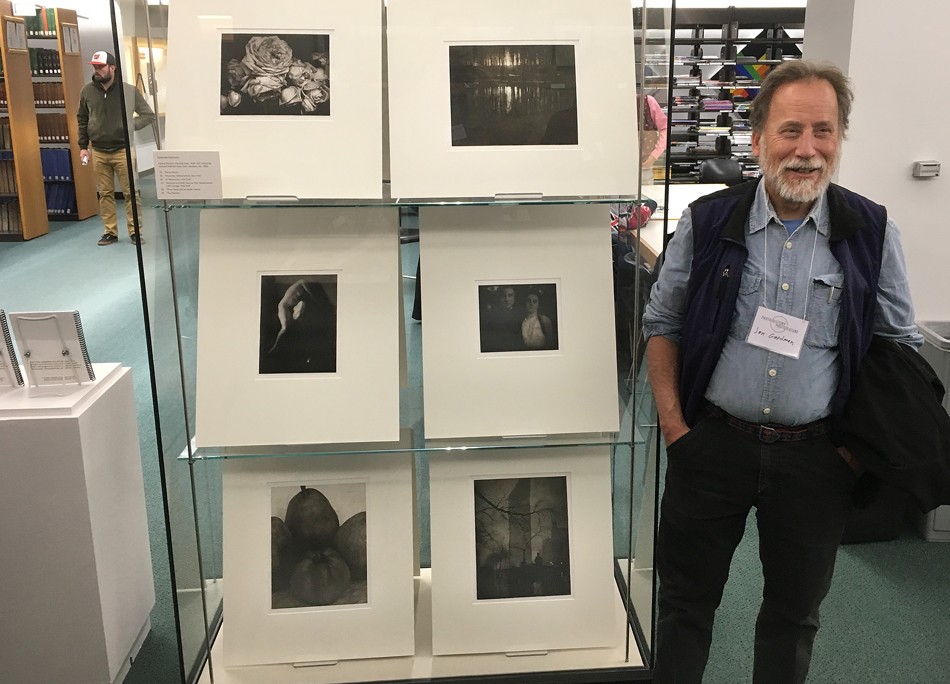 Royal Visit: As an added bonus, conference attendees viewing "The Luminous Print" could rub shoulders with Massachusetts resident Jon Goodman, a master craftsman who has worked full time since 1976 as a photogravure printer specializing in the Talbot Klic photogravure technique . Beginning in 1980 through the Photogravure Workshop, a division of the Aperture Publishing Foundation and their namesake Aperture magazine and the Paul Strand Foundation, Jon has produced sumptuous, superb, and collectable portfolios of the early work of Paul Strand, Edward Steichen, and British photography. His mission continues today in his Florence, MA atelier along with a new interest: carbon printing. Displayed are six of Jon's gravure plates featuring the pictorial work of Edward Steichen from the 1981 Aperture portfolio: "Edward Steichen; The Early Years, 1900-1927". Top to bottom left to right: "Heavy Roses", "Moonrise, Mamaroneck, New York", "In Memoriam, New York", "Steichen and Wife Clara on their Honeymoon, Lake George, New York", "Three Pears and an Apple, France", "The Flatiron". Visit jgoodgravure.com and gravureportfolios.com for more information. David Spencer for PhotoSeed Archive
Royal Visit: As an added bonus, conference attendees viewing "The Luminous Print" could rub shoulders with Massachusetts resident Jon Goodman, a master craftsman who has worked full time since 1976 as a photogravure printer specializing in the Talbot Klic photogravure technique . Beginning in 1980 through the Photogravure Workshop, a division of the Aperture Publishing Foundation and their namesake Aperture magazine and the Paul Strand Foundation, Jon has produced sumptuous, superb, and collectable portfolios of the early work of Paul Strand, Edward Steichen, and British photography. His mission continues today in his Florence, MA atelier along with a new interest: carbon printing. Displayed are six of Jon's gravure plates featuring the pictorial work of Edward Steichen from the 1981 Aperture portfolio: "Edward Steichen; The Early Years, 1900-1927". Top to bottom left to right: "Heavy Roses", "Moonrise, Mamaroneck, New York", "In Memoriam, New York", "Steichen and Wife Clara on their Honeymoon, Lake George, New York", "Three Pears and an Apple, France", "The Flatiron". Visit jgoodgravure.com and gravureportfolios.com for more information. David Spencer for PhotoSeed Archive
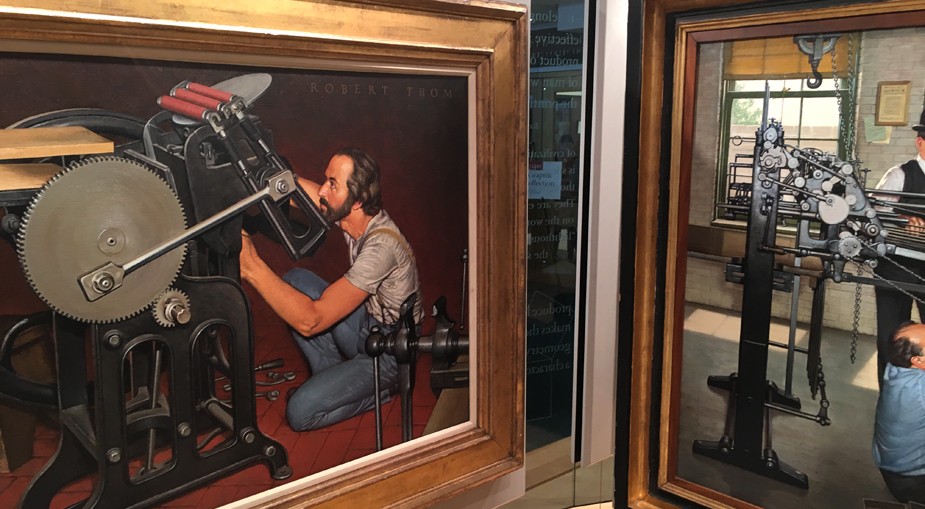 History of Printing: A series of oil paintings by three artists originally commissioned in 1966 by the Kimberly-Clark Corporation commemorating "Graphic Communications through the Ages" hangs within the offices of the RIT Press ( www.rit.edu/press/ ) and the adjoining Cary Graphic Arts Collection at The Wallace Center. This painting shows a detail of the work "George P. Gordon and the Platen Press" done by American illustrator Robert A. Thom, (1915-1979) with a detail at right by Thom: "Ira Rubel and the Offset Press". David Spencer for PhotoSeed Archive
History of Printing: A series of oil paintings by three artists originally commissioned in 1966 by the Kimberly-Clark Corporation commemorating "Graphic Communications through the Ages" hangs within the offices of the RIT Press ( www.rit.edu/press/ ) and the adjoining Cary Graphic Arts Collection at The Wallace Center. This painting shows a detail of the work "George P. Gordon and the Platen Press" done by American illustrator Robert A. Thom, (1915-1979) with a detail at right by Thom: "Ira Rubel and the Offset Press". David Spencer for PhotoSeed Archive
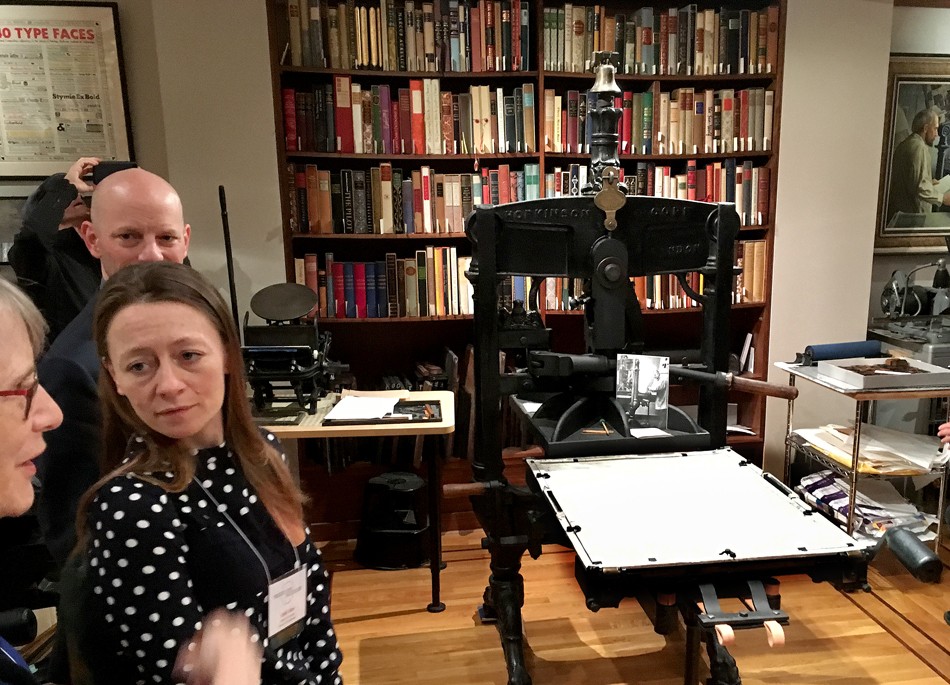 Making an Impression: Taking center stage for visitors is the famed Kelmscott/Goudy iron hand-press featured among other working presses in the Arthur M. Lowenthal Memorial Pressroom within the Cary Graphics Arts Collection at RIT. Visitors learned it was first owned by the English printer William Morris and then Frederic Goudy, two giants of the letterpress printing art. The press was built in London in 1891 by Hopkinson & Cope- an Improved Albion model (No. 6551). Now featuring around 40,000 fine and rare volumes on graphic communication history and practices, The Cary Collection is considered one of the premier libraries on the subject in the United States. ( library.rit.edu/cary ) David Spencer for PhotoSeed Archive
Making an Impression: Taking center stage for visitors is the famed Kelmscott/Goudy iron hand-press featured among other working presses in the Arthur M. Lowenthal Memorial Pressroom within the Cary Graphics Arts Collection at RIT. Visitors learned it was first owned by the English printer William Morris and then Frederic Goudy, two giants of the letterpress printing art. The press was built in London in 1891 by Hopkinson & Cope- an Improved Albion model (No. 6551). Now featuring around 40,000 fine and rare volumes on graphic communication history and practices, The Cary Collection is considered one of the premier libraries on the subject in the United States. ( library.rit.edu/cary ) David Spencer for PhotoSeed Archive
 Alternate History: The coverage by war photographer Robert Capa (1913-1954) for Life Magazine of American troops landing on Omaha Beach on D-Day during World War II was deconstructed after seven decades of public myth to facts by Staten Island, NY independent critic and historian A. D. Coleman. The first photo critic for the New York Times in 1967 and prolific author of books on photography as well as thousands of articles on the medium, Coleman presented his research during the conference titled “Deconstructing Robert Capa’s D-Day: The Unmaking of a Myth” that recently took place over three years helped by the efforts of war photographer J. Ross Baughman, Rob McElroy and Charles Herrick. As a former photojournalist myself for over three decades, I found his presentation convincing and enlightening: I still remember drying strips of film as a young photographer in large upright darkroom cabinets-the focus of some of the research when it was claimed a Life lab tech had melted Capa's film on deadline- the worst I remember was curled film! Please visit capaddayproject.com to learn more. Malcolm Gladwell, (revisionisthistory.com) are you interested? David Spencer for PhotoSeed Archive
Alternate History: The coverage by war photographer Robert Capa (1913-1954) for Life Magazine of American troops landing on Omaha Beach on D-Day during World War II was deconstructed after seven decades of public myth to facts by Staten Island, NY independent critic and historian A. D. Coleman. The first photo critic for the New York Times in 1967 and prolific author of books on photography as well as thousands of articles on the medium, Coleman presented his research during the conference titled “Deconstructing Robert Capa’s D-Day: The Unmaking of a Myth” that recently took place over three years helped by the efforts of war photographer J. Ross Baughman, Rob McElroy and Charles Herrick. As a former photojournalist myself for over three decades, I found his presentation convincing and enlightening: I still remember drying strips of film as a young photographer in large upright darkroom cabinets-the focus of some of the research when it was claimed a Life lab tech had melted Capa's film on deadline- the worst I remember was curled film! Please visit capaddayproject.com to learn more. Malcolm Gladwell, (revisionisthistory.com) are you interested? David Spencer for PhotoSeed Archive
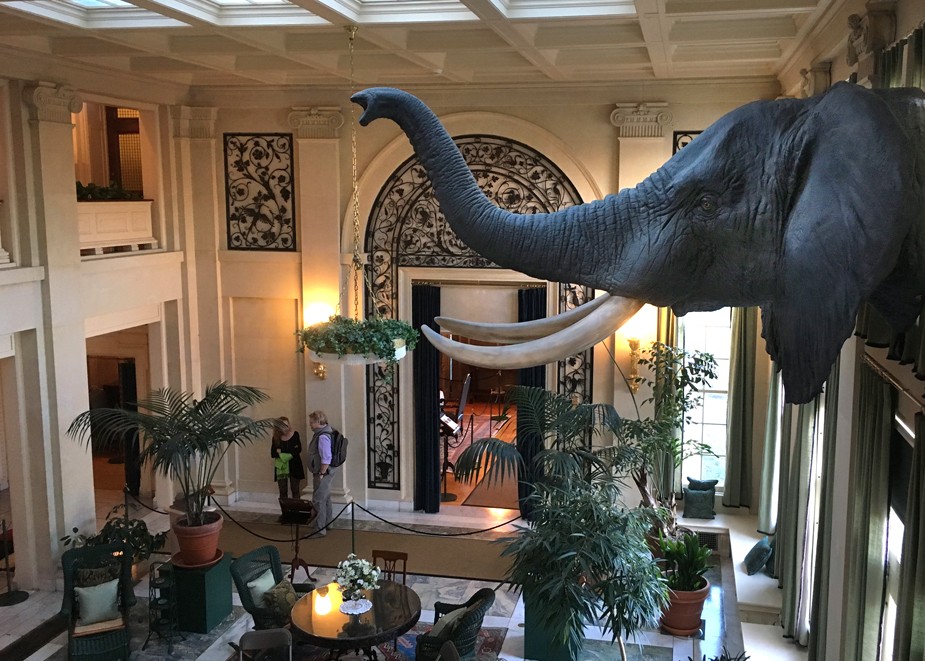 Digital Elephant in Room: Visitors to George Eastman's stately 50-room Colonial revival mansion adjoining the Eastman Museum will always remember the conservatory, where a fiberglass replica mount of an African bull elephant hangs- a conquest by the company founder during a 1928 Sudanese safari. Conveniently- and speaking of elephants in the room, I earlier had thoroughly enjoyed listening and pondering conference presenter Stephen Fletcher's talk: “The Photographic Archivist is Dead, Long Live the Photographic Archivist!”, his call to action for the task of photo archivists in the 21st Century: what do we do and how do we preserve a portion for posterity and history the digital evidence of billions and billions of photographs taken-seemingly, every day? A photographic archivist in the North Carolina collection at the University of North Carolina at Chapel Hill, Fletcher's call to arms would surely have inspired Eastman himself, a hands-on guy who is reported to have overseen every aspect of the construction of his mansion and made sure it contained all the cutting-edge technology of its' day: from the Eastman Museum website: "Beneath this exterior were modern conveniences such as an electrical generator, an internal telephone system with 21 stations, a built-in vacuum cleaning system, a central clock network, an elevator, and a great pipe organ, which made the home itself an instrument, a center of the city’s rich musical life from 1905 until Eastman’s death in 1932. Eastman was involved in every aspect of the construction, paying close attention to detail and requiring the use of high-quality materials." David Spencer for PhotoSeed Archive
Digital Elephant in Room: Visitors to George Eastman's stately 50-room Colonial revival mansion adjoining the Eastman Museum will always remember the conservatory, where a fiberglass replica mount of an African bull elephant hangs- a conquest by the company founder during a 1928 Sudanese safari. Conveniently- and speaking of elephants in the room, I earlier had thoroughly enjoyed listening and pondering conference presenter Stephen Fletcher's talk: “The Photographic Archivist is Dead, Long Live the Photographic Archivist!”, his call to action for the task of photo archivists in the 21st Century: what do we do and how do we preserve a portion for posterity and history the digital evidence of billions and billions of photographs taken-seemingly, every day? A photographic archivist in the North Carolina collection at the University of North Carolina at Chapel Hill, Fletcher's call to arms would surely have inspired Eastman himself, a hands-on guy who is reported to have overseen every aspect of the construction of his mansion and made sure it contained all the cutting-edge technology of its' day: from the Eastman Museum website: "Beneath this exterior were modern conveniences such as an electrical generator, an internal telephone system with 21 stations, a built-in vacuum cleaning system, a central clock network, an elevator, and a great pipe organ, which made the home itself an instrument, a center of the city’s rich musical life from 1905 until Eastman’s death in 1932. Eastman was involved in every aspect of the construction, paying close attention to detail and requiring the use of high-quality materials." David Spencer for PhotoSeed Archive
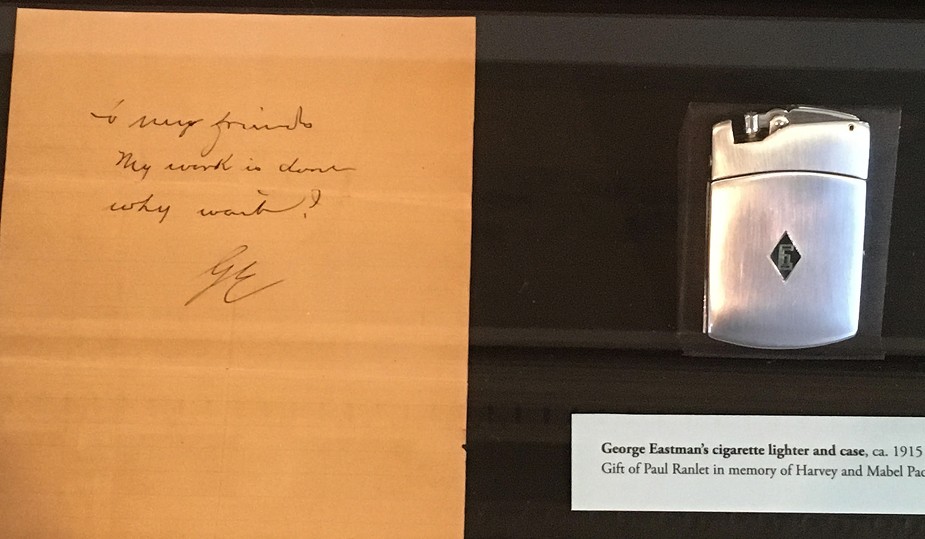 Smoking also Works: Perhaps the most startling object on display in the mansion-at least to those who do not know the intimate details of George Eastman's life- is a facsimile of his 1932 suicide note: "To my friends - My work is done - why wait? GE." Suppressed initially by the Eastman Kodak Company for decades, this news is sobering but important. Eastman had been crippled by a degenerative spinal disease and unable to walk, he shot himself through the heart in his upstairs bedroom. A music lover even after the end, a 1990 New York Times story on the renovation of the mansion noted he "requested a rousing ''Marche Romaine'' by Charles Gounod be played at his funeral". David Spencer for PhotoSeed Archive
Smoking also Works: Perhaps the most startling object on display in the mansion-at least to those who do not know the intimate details of George Eastman's life- is a facsimile of his 1932 suicide note: "To my friends - My work is done - why wait? GE." Suppressed initially by the Eastman Kodak Company for decades, this news is sobering but important. Eastman had been crippled by a degenerative spinal disease and unable to walk, he shot himself through the heart in his upstairs bedroom. A music lover even after the end, a 1990 New York Times story on the renovation of the mansion noted he "requested a rousing ''Marche Romaine'' by Charles Gounod be played at his funeral". David Spencer for PhotoSeed Archive
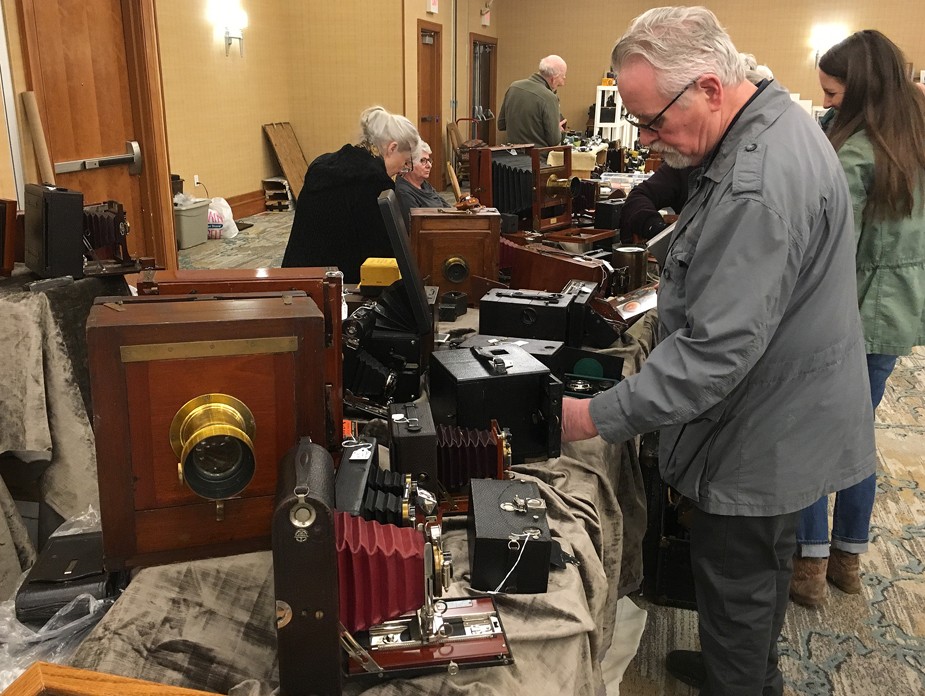 Fancy Box with Hole in It: Collectors and the curious had the opportunity to peruse the physical evidence of the history of photography during the concluding event of the conference, an antiquarian photography show and sale featuring 80 tables of wares including these vintage wooden box and Kodak cameras. Earlier, the RIT Press and Syracuse University Press showed off their latest offerings, including some wonderful photography volumes during the event. David Spencer for PhotoSeed Archive
Fancy Box with Hole in It: Collectors and the curious had the opportunity to peruse the physical evidence of the history of photography during the concluding event of the conference, an antiquarian photography show and sale featuring 80 tables of wares including these vintage wooden box and Kodak cameras. Earlier, the RIT Press and Syracuse University Press showed off their latest offerings, including some wonderful photography volumes during the event. David Spencer for PhotoSeed Archive
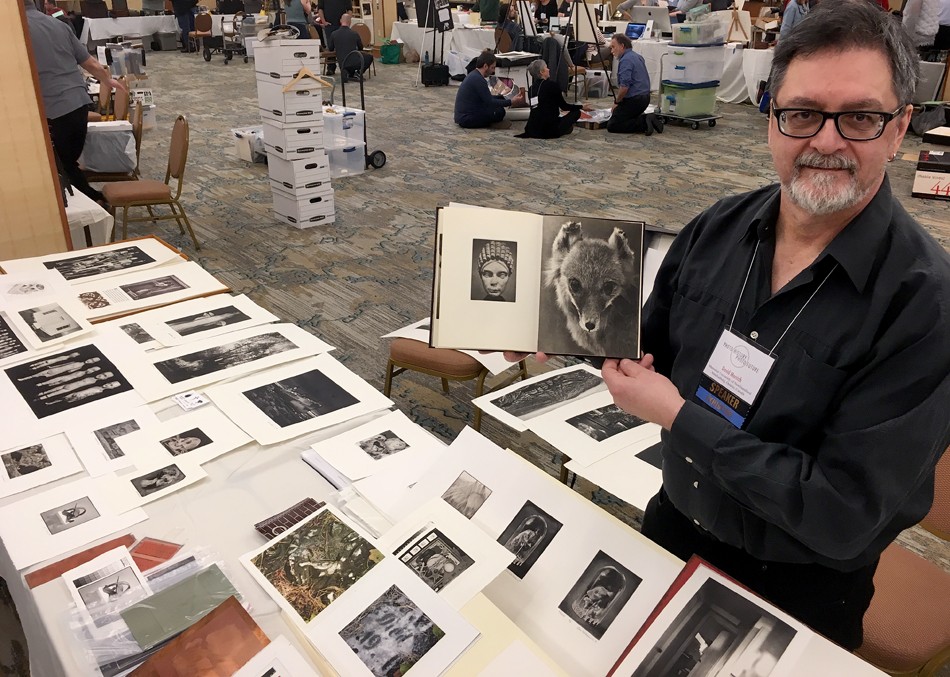 Learned from Jon Goodman: During the antiquarian photography show and sale, Ontario-based visual artist David Morrish, co-author along with Marlene MacCallum of the 2003 volume "Copper Plate Photogravure: Demystifying the Process", shows off a page spread of original photogravures from his 2004 Deadcat Press imprint "Gaze" he was selling along with other work during the antiquarian photography show and sale. Earlier in the conference, Morrish and visual artist MacCallum, former professor in the Visual Arts Program at Memorial University of Newfoundland, presented on "Photogravure: Then and Now" highlighting the gravure process while showing how the medium’s ongoing relevance to contemporary art practice has influenced their own work in the production of print suites and artists’ books. Learn more at marlenemaccallum.com and davidmorrish.com. David Spencer for PhotoSeed Archive
Learned from Jon Goodman: During the antiquarian photography show and sale, Ontario-based visual artist David Morrish, co-author along with Marlene MacCallum of the 2003 volume "Copper Plate Photogravure: Demystifying the Process", shows off a page spread of original photogravures from his 2004 Deadcat Press imprint "Gaze" he was selling along with other work during the antiquarian photography show and sale. Earlier in the conference, Morrish and visual artist MacCallum, former professor in the Visual Arts Program at Memorial University of Newfoundland, presented on "Photogravure: Then and Now" highlighting the gravure process while showing how the medium’s ongoing relevance to contemporary art practice has influenced their own work in the production of print suites and artists’ books. Learn more at marlenemaccallum.com and davidmorrish.com. David Spencer for PhotoSeed Archive
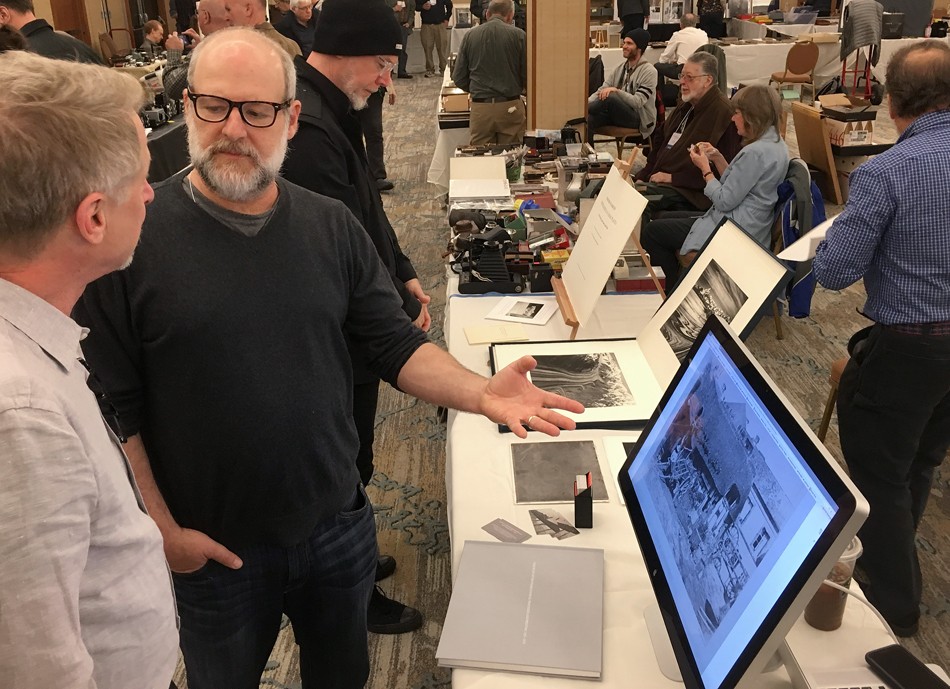 Future with a Past: St. Louis resident and commercial photographer Mark Katzman, the key force in proselytizing for the medium and beauty of hand-pulled photogravure worldwide through his website Photogravure.com, speaks with conference speaker Jeff Rosen during the antiquarian photography show and sale. Curious to learn what a real photogravure is, unlike the many who simply use the term-wrongly-to sell you something not what they claim? Head over to his newly redesigned site, where the mission statement is: "Peeling back a layer of the history of photography, this site examines the role that photogravure has played in shaping our shared visual experience. Through exploring thousands of examples, we learn about the relentless and ambitious 19th century pursuit to reproduce photographs in ink and discover the exquisite, sublime process that resulted. It is our hope that this site firmly establishes photogravure as not only one of the most under-recognized photographic processes, but also an important and beautiful art." David Spencer for PhotoSeed Archive
Future with a Past: St. Louis resident and commercial photographer Mark Katzman, the key force in proselytizing for the medium and beauty of hand-pulled photogravure worldwide through his website Photogravure.com, speaks with conference speaker Jeff Rosen during the antiquarian photography show and sale. Curious to learn what a real photogravure is, unlike the many who simply use the term-wrongly-to sell you something not what they claim? Head over to his newly redesigned site, where the mission statement is: "Peeling back a layer of the history of photography, this site examines the role that photogravure has played in shaping our shared visual experience. Through exploring thousands of examples, we learn about the relentless and ambitious 19th century pursuit to reproduce photographs in ink and discover the exquisite, sublime process that resulted. It is our hope that this site firmly establishes photogravure as not only one of the most under-recognized photographic processes, but also an important and beautiful art." David Spencer for PhotoSeed Archive
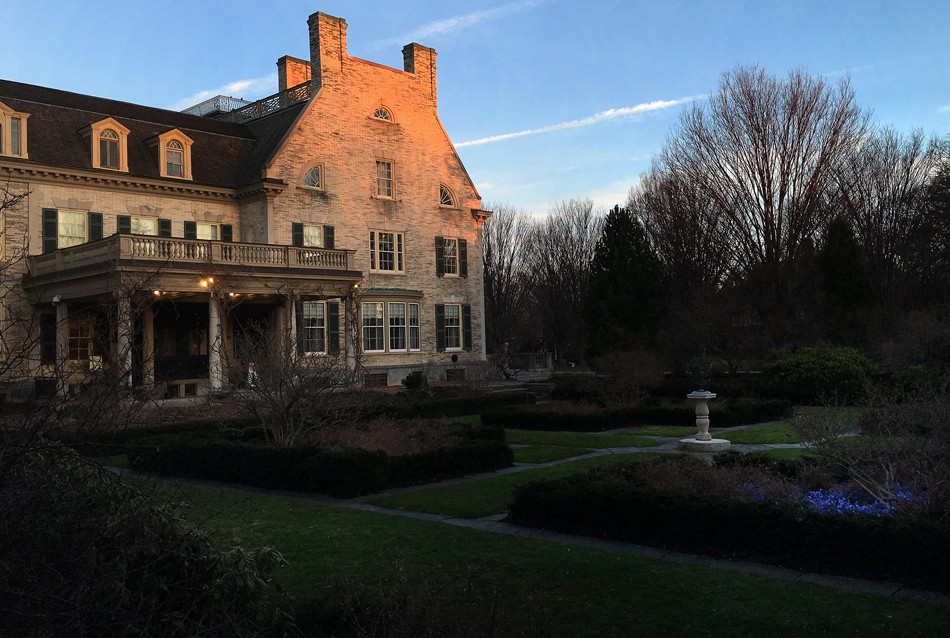 Keeper of Memories: Located at 900 East Ave. in Rochester, New York, the George Eastman Museum, along with a section of his original mansion and gardens on 8.5 acres constructed beginning in 1902, is a grand American repository for the study of photography past, present and future. Besides a growing archive of over 400,000 photographic objects spanning the history of the medium, the museum also features 16,000 + examples of photographic and cinematographic technology- the world's largest. For those interested in the printed legacy, the accessible Richard and Ronay Menschel Library is also onsite, with a special collections and archive division housing "manuscripts, papers, and ephemera, including those of Alvin Langdon Coburn, Lewis W. Hine, Southworth and Hawes, and Edward Steichen, among other photographers, collectors, and inventors." Curious? eastman.org. David Spencer for PhotoSeed Archive
Keeper of Memories: Located at 900 East Ave. in Rochester, New York, the George Eastman Museum, along with a section of his original mansion and gardens on 8.5 acres constructed beginning in 1902, is a grand American repository for the study of photography past, present and future. Besides a growing archive of over 400,000 photographic objects spanning the history of the medium, the museum also features 16,000 + examples of photographic and cinematographic technology- the world's largest. For those interested in the printed legacy, the accessible Richard and Ronay Menschel Library is also onsite, with a special collections and archive division housing "manuscripts, papers, and ephemera, including those of Alvin Langdon Coburn, Lewis W. Hine, Southworth and Hawes, and Edward Steichen, among other photographers, collectors, and inventors." Curious? eastman.org. David Spencer for PhotoSeed Archive
Let the Children Selfie
Posted June 2017 in Advertising, Cameras, Childhood Photography, Photography
Cute and engaging as they are, these photographs showing a little boy posing with his then new No. 1A Kodak Jr. Autographic camera and Staten Island, N.Y. resident Dorothy Tucker with her model 3A Folding Pocket model are not known to have been singled out by judges in the annual Kodak Advertising Contests they were entered in.
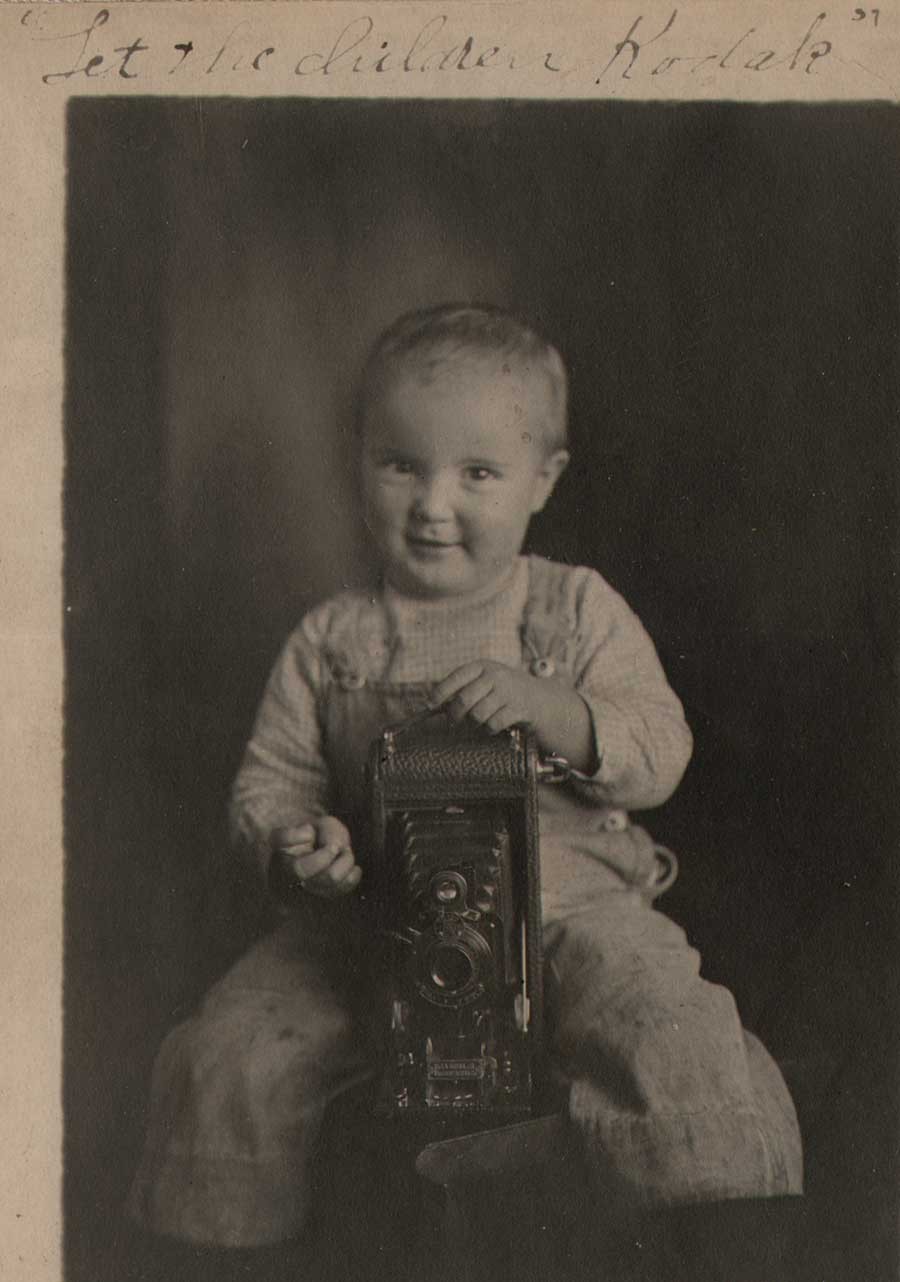 Detail: "Let the Children Kodak": Anonymous American Photographer: ca. 1915-20: Gelatin Silver print, mounted to vintage 1890's era cabinet card: 11.3 x 7.7 | 13.2 x 8.7 | 16.4 x 13.9 cm. This amateur photograph was submitted as part of Kodak's annual Advertising Contest around 1915. An unknown little boy in overalls is shown about to take a photograph using a pneumatic bulb shutter release in his right hand while posing behind a No. 1A Kodak Jr. (Autographic) camera. The camera was produced and sold by the Eastman Kodak Company of Rochester, New York from 1914-27. From: PhotoSeed Archive
Detail: "Let the Children Kodak": Anonymous American Photographer: ca. 1915-20: Gelatin Silver print, mounted to vintage 1890's era cabinet card: 11.3 x 7.7 | 13.2 x 8.7 | 16.4 x 13.9 cm. This amateur photograph was submitted as part of Kodak's annual Advertising Contest around 1915. An unknown little boy in overalls is shown about to take a photograph using a pneumatic bulb shutter release in his right hand while posing behind a No. 1A Kodak Jr. (Autographic) camera. The camera was produced and sold by the Eastman Kodak Company of Rochester, New York from 1914-27. From: PhotoSeed Archive
But times do change, and so has the company that promoted their namesake as a verb, as in the following slogan used to promote themselves for advertising purposes: Let the Children Kodak.
Belatedly, it’s reassuring to know Eastman Kodak did re-emerge from 20 months of Chapter 11 bankruptcy protection on September 3, 2013. (1.)
For the record, Kodak now brands itself “a technology company focused on imaging”, with major divisions including separate Print and Enterprise Inkjet Systems, Flexographic Packaging, Software and Solutions, Consumer and Film, Advanced Materials and 3D Printing Technology.
 Detail: "Let the Children Kodak": Anonymous American Photographer: ca. 1915-20: Gelatin Silver print, mounted to vintage 1890's era cabinet card: 10.9 x 7.7 | 13.0 x 9.7 | 16.4 x 13.9 cm. This amateur photograph was submitted as part of Kodak's annual Advertising Contest around 1915. An unknown little boy in overalls is shown about to take a photograph using a pneumatic bulb shutter release in his right hand while standing and holding a No. 1A Kodak Jr. (Autographic) camera. The camera was produced and sold by the Eastman Kodak Company of Rochester, New York from 1914-27. From: PhotoSeed Archive
Detail: "Let the Children Kodak": Anonymous American Photographer: ca. 1915-20: Gelatin Silver print, mounted to vintage 1890's era cabinet card: 10.9 x 7.7 | 13.0 x 9.7 | 16.4 x 13.9 cm. This amateur photograph was submitted as part of Kodak's annual Advertising Contest around 1915. An unknown little boy in overalls is shown about to take a photograph using a pneumatic bulb shutter release in his right hand while standing and holding a No. 1A Kodak Jr. (Autographic) camera. The camera was produced and sold by the Eastman Kodak Company of Rochester, New York from 1914-27. From: PhotoSeed Archive
The Consumer and Film part of the above is what were interested in here, and happily, Kodak is at least trying to stay in the game, with an outside licensing agreement in place for their own branded PixPro series digital camera and camcorder line (manufactured in China) as well as a new Android™ based smartphone called the Ektra. The company does a good job in putting the Ektra in historical context with all the Kodak innovations going way back, with a company website copywriter pontificating a bit about how company founder George Eastman would …” totally understand the power of putting a camera into a smartphone, a device that everyone always carries.”
The reality however-and I do hope they push back given their rich heritage in photography-are plenty of negative reviews for the Ektra. (on CNET, among other sites) Luckily they have a few aces up their sleeves and are proactive and smart enough to diversify into smartphone accessories like wireless selfie sticks, vehicle dashboard mounts and mini tripods, among other things. Word in January, 2017 of the re-introduction of Ektachrome film for both motion picture cinematographers and still shooters scheduled for later this year has also made plenty of folks very happy indeed.
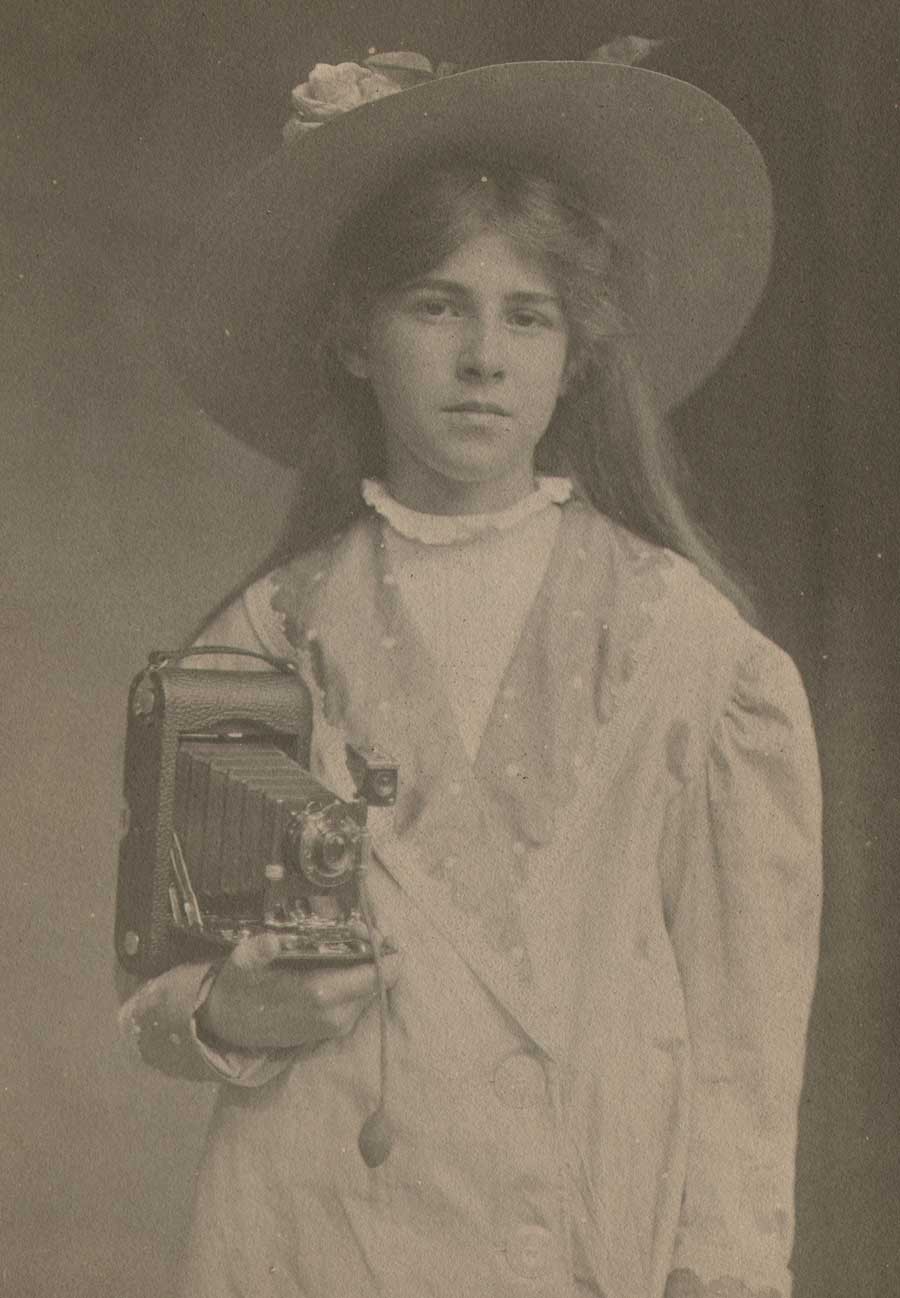 Detail: "Dorothy Tucker with Kodak 3A Folding Pocket Camera": Charles Rollins Tucker, American (b. 1868): unmounted vintage platinum print ca. 1910-15: 23.6 x 15.0 cm: Dorothy Tucker, b. August, 1899, of Staten Island, N.Y., the photographer's daughter, is shown holding what is believed to be Kodak's first postcard format camera introduced in 1903 and manufactured until 1915. Wearing an elegant hat and overcoat, Dorothy posed for a series of photographs that were entered over successive years by her father in Kodak's annual Advertising contests. From: PhotoSeed Archive
Detail: "Dorothy Tucker with Kodak 3A Folding Pocket Camera": Charles Rollins Tucker, American (b. 1868): unmounted vintage platinum print ca. 1910-15: 23.6 x 15.0 cm: Dorothy Tucker, b. August, 1899, of Staten Island, N.Y., the photographer's daughter, is shown holding what is believed to be Kodak's first postcard format camera introduced in 1903 and manufactured until 1915. Wearing an elegant hat and overcoat, Dorothy posed for a series of photographs that were entered over successive years by her father in Kodak's annual Advertising contests. From: PhotoSeed Archive
So go out and buy that Kodak 40” Selfie Stick with Wireless Remote: impress your neighbors by taking photos and videos “to a whole new level of awesome” as the ad copy promotes, and don’t forget to take some ancient advice from a company that knew a thing or two about winning photo contests with cameras they once made themselves:
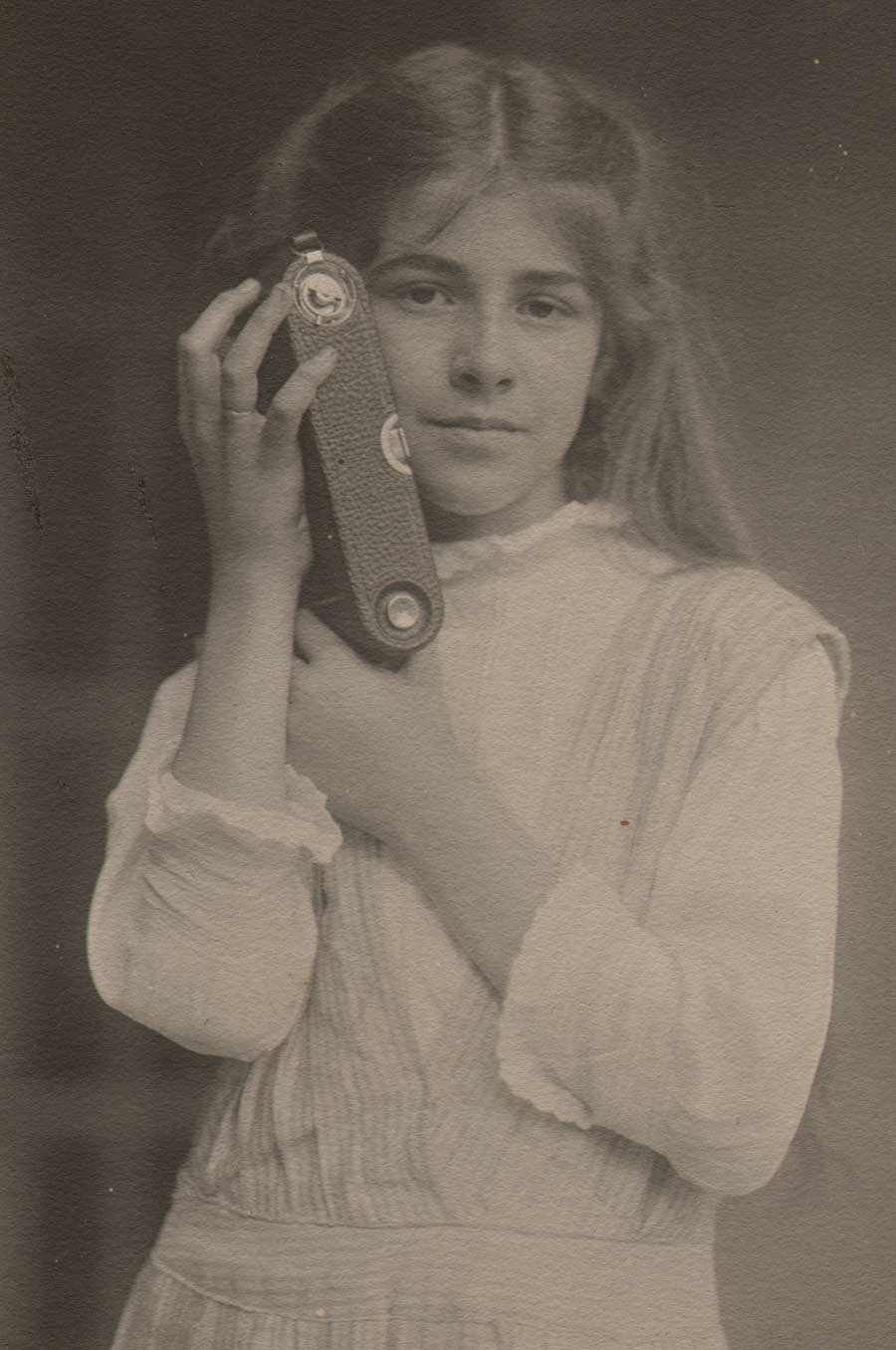 Detail: "Dorothy Tucker with Kodak 3A Folding Pocket Camera": Charles Rollins Tucker, American (b. 1868): mounted vintage platinum print ca. 1910-15: 22.0 x 14.0 | 33.9 x 24.9 cm: Dorothy Tucker, b. August, 1899, of Staten Island, N.Y., the photographer's daughter, is shown holding and snuggling up to what is believed to be Kodak's first postcard format camera (shown in closed position) introduced in 1903 and manufactured until 1915. Over a period of successive years, Dorothy posed for a series of photographs taken by her father and entered in Kodak's annual Advertising contests. Scott's Photographica Collection online resource states the 3A was manufactured in seven different models over its' lifetime and that the "1912 Eastman Kodak catalog prices the 3A FPK with Kodak Ball Bearing shutter at 20 dollars, with Kodak Automatic shutter at 25 dollars and with Compound shutter and Zeiss Kodak anastigmat lens at 61.40 dollars." From: PhotoSeed Archive
Detail: "Dorothy Tucker with Kodak 3A Folding Pocket Camera": Charles Rollins Tucker, American (b. 1868): mounted vintage platinum print ca. 1910-15: 22.0 x 14.0 | 33.9 x 24.9 cm: Dorothy Tucker, b. August, 1899, of Staten Island, N.Y., the photographer's daughter, is shown holding and snuggling up to what is believed to be Kodak's first postcard format camera (shown in closed position) introduced in 1903 and manufactured until 1915. Over a period of successive years, Dorothy posed for a series of photographs taken by her father and entered in Kodak's annual Advertising contests. Scott's Photographica Collection online resource states the 3A was manufactured in seven different models over its' lifetime and that the "1912 Eastman Kodak catalog prices the 3A FPK with Kodak Ball Bearing shutter at 20 dollars, with Kodak Automatic shutter at 25 dollars and with Compound shutter and Zeiss Kodak anastigmat lens at 61.40 dollars." From: PhotoSeed Archive
Pretty pictures of pretty children will not sell Kodaks, but the picture of a pretty little girl photographing her playmates will make other children want Kodaks to photograph their playmates. Make an attractive picture of this sort and you have an entry for Class 4, which calls for pictures illustrating the slogan, “Let the children Kodak.” (2.)
1. see 2012 post on this website: “Kodak’s Work not Done”. A history of Kodak’s annual contests from this site can be found here.
2. excerpt: Thirty Days Left (Kodak Advertising Competition) in: Studio Light (publication of the Eastman Kodak Company): October, 1915, p. 20. A nice historical overview of George Eastman and the Kodak company can be found here on their website.
No Junk in Trunk
Posted December 2015 in Alternate Processes, Cameras, Color Photography, New Additions, Photography, Unknown Photographers
If the story is to be believed, the contents of a mystery trunk ⎯the artistic passion of yet another unknown early 20th Century photographer ⎯have been saved once again in the name of photographic collecting. The evidence was several hundred photographs tucked inside:
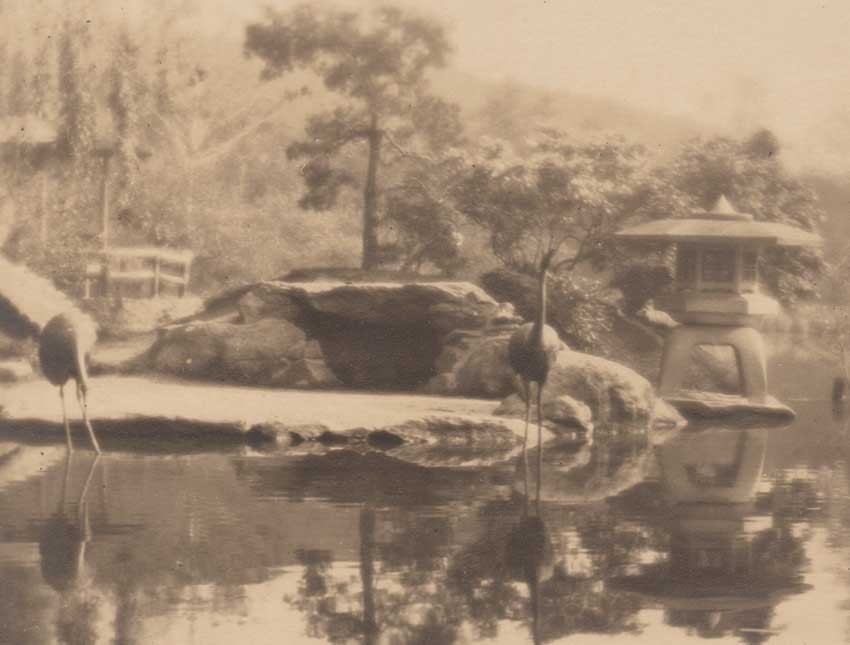 Detail: "Japanese Hill-and-Pond Garden Island" (at Brooklyn, New York Botanic Garden): ca. 1920-25: Unknown Brooklyn photographer: gelatin silver: 8.8 x 11.4 cm | 12.6 x 17.3 cm cream-colored, photographic paper stock: from: PhotoSeed Archive
Detail: "Japanese Hill-and-Pond Garden Island" (at Brooklyn, New York Botanic Garden): ca. 1920-25: Unknown Brooklyn photographer: gelatin silver: 8.8 x 11.4 cm | 12.6 x 17.3 cm cream-colored, photographic paper stock: from: PhotoSeed Archive
”The dealer had bought a trunk from an estate of a lady who had passed away.”
A story I’ve encountered before in my online foraging. My offer, in order to keep the archive together, was fortunately accepted, and now share with you a glimpse of some of these fruits.
Typically, when photographs enter this collection, initial research on origins and other factors are made and then set aside-often for years- until more deductions can be made or oftentimes additional primary source material percolates into that vast library we all humbly know as the public Internet.
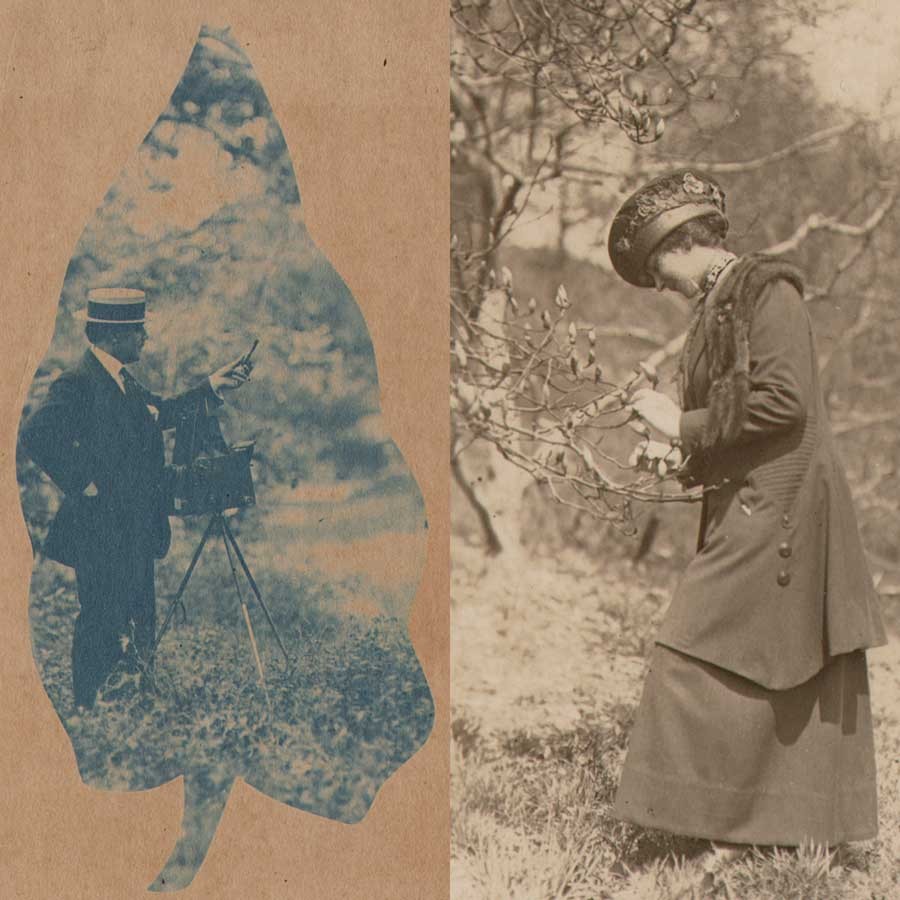 Husband & Wife? L: Detail: "Photographer in Boater Hat Behind Graflex Camera": ca. 1910-1920: Unknown Brooklyn photographer: cyanotype: 11.2 x 5.2 cm | 14.6 x 8.2 cm: image printed within leaf shape on thin cream-colored paper: R: Detail: "Woman Examining Magnolia Blossom": ca. 1910-1920: Unknown Brooklyn photographer: gelatin silver: 11.1 x 7.3 cm | 17.1 x 10.5 cm: both from: PhotoSeed Archive
Husband & Wife? L: Detail: "Photographer in Boater Hat Behind Graflex Camera": ca. 1910-1920: Unknown Brooklyn photographer: cyanotype: 11.2 x 5.2 cm | 14.6 x 8.2 cm: image printed within leaf shape on thin cream-colored paper: R: Detail: "Woman Examining Magnolia Blossom": ca. 1910-1920: Unknown Brooklyn photographer: gelatin silver: 11.1 x 7.3 cm | 17.1 x 10.5 cm: both from: PhotoSeed Archive
But exceptions, at least in my world, always exist. For these latest trunk photographs coming to light, my discovery a small portion documenting a place and event celebrating 100 year anniversaries in 2015 were primary motivators in showcasing them now with this post. These were the establishment of the Japanese Hill-and-Pond Garden in 1915 at the Brooklyn Botanic Garden, considered the first Japanese garden created in an American public garden, as well as a small cache of photographs taken the same year at the Panama-Pacific International Exposition in San Francisco, California.
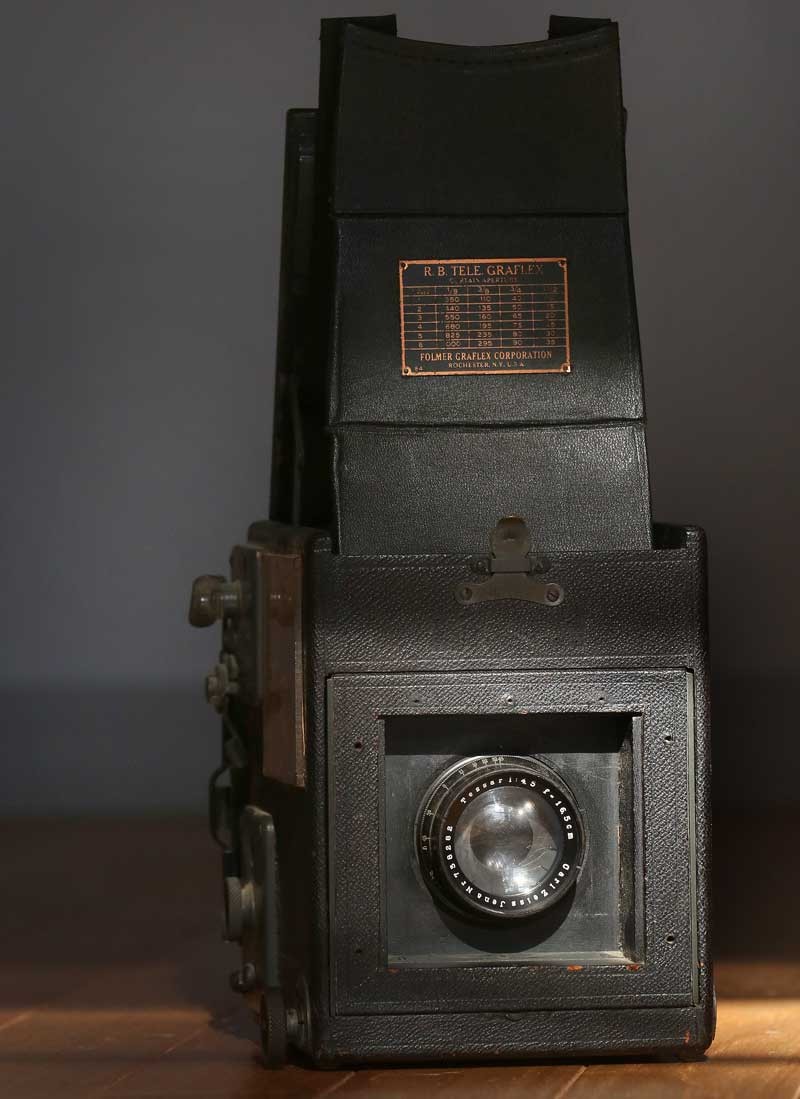 R.B.Tele-Graflex Camera outfitted with Carl Zeiss Tessar lens ca. 1913 (last patent is for June of this year on camera bottom) Manufactured by the Folmer Graflex Corporation, Rochester, New York. The Unknown Brooklyn photographer who took the images seen with this post used a similar Graflex model pictured in the above cyanotype. Lightweight so it could be carried in the field and used on a tripod or hand-held, it features a revolving back so the glass or cut film plates loaded into individual holders could be oriented on the camera back for a vertical or horizontal field of view. The photographer looked through the top of the camera (shown in open position here) and focused on the ground glass inside while bringing the subject into focus by manipulating the bellows (not extended in this photo) using the knob located at the far left of the lens board on lower side of camera. from: PhotoSeed Archive
R.B.Tele-Graflex Camera outfitted with Carl Zeiss Tessar lens ca. 1913 (last patent is for June of this year on camera bottom) Manufactured by the Folmer Graflex Corporation, Rochester, New York. The Unknown Brooklyn photographer who took the images seen with this post used a similar Graflex model pictured in the above cyanotype. Lightweight so it could be carried in the field and used on a tripod or hand-held, it features a revolving back so the glass or cut film plates loaded into individual holders could be oriented on the camera back for a vertical or horizontal field of view. The photographer looked through the top of the camera (shown in open position here) and focused on the ground glass inside while bringing the subject into focus by manipulating the bellows (not extended in this photo) using the knob located at the far left of the lens board on lower side of camera. from: PhotoSeed Archive
But there’s more as they say. Many of the photographs: gorgeous little jewels printed directly onto small impressed and ruled pieces of photographic paper which act as mounts-some toned in verdant hues of green for landscapes, blues for seascapes and others beautifully hand-colored, are known to have been taken in the mother of the Brooklyn Botanic Garden itself, the expansive 585-acre Prospect Park designed by Frederick Law Olmsted and Calvert Vaux- Brooklyn’s version of New York City’s Central Park which is celebrating its’ 150th anniversary in 2016.
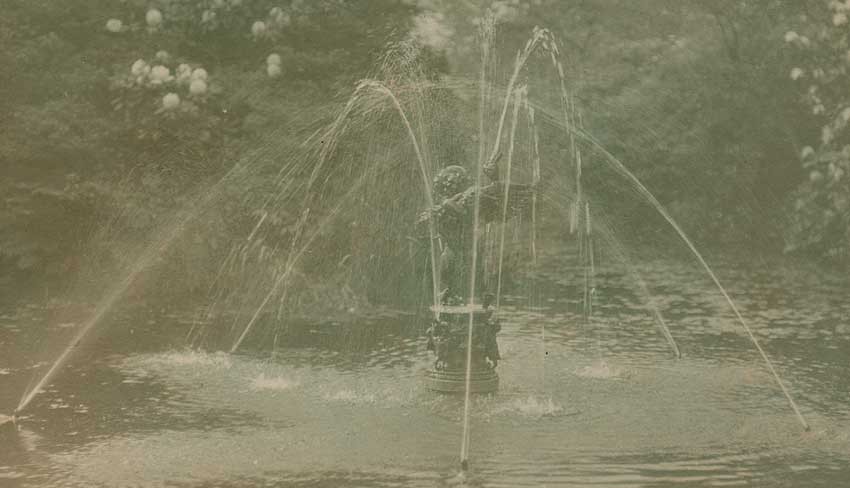 Detail: "Boy and Duck Fountain in Vale of Cashmere", sculpture by Frederick William MacMonnies, American: 1863-1937 (at Brooklyn Botanic Garden): ca. 1910-20: Unknown Brooklyn photographer: green toned gelatin silver: 8.8 x 11.6 cm|12.4 x 16.9 cm: from: PhotoSeed Archive
Detail: "Boy and Duck Fountain in Vale of Cashmere", sculpture by Frederick William MacMonnies, American: 1863-1937 (at Brooklyn Botanic Garden): ca. 1910-20: Unknown Brooklyn photographer: green toned gelatin silver: 8.8 x 11.6 cm|12.4 x 16.9 cm: from: PhotoSeed Archive
Frustratingly, the photographer’s identity responsible for these fruits is presently unknown, other than a cyanotype image included with the collection showing a dapper gentleman believed to be this person standing behind a tripod-mounted Graflex model camera. Photographically printed within the outlines of a leaf while standing in a park-like setting, he wears a straw boater hat while dressed in a suit and raises his hand clenching a pipe towards the scene before him as if to say, “now that’s a scene worthy of my camera”, or something to that effect.
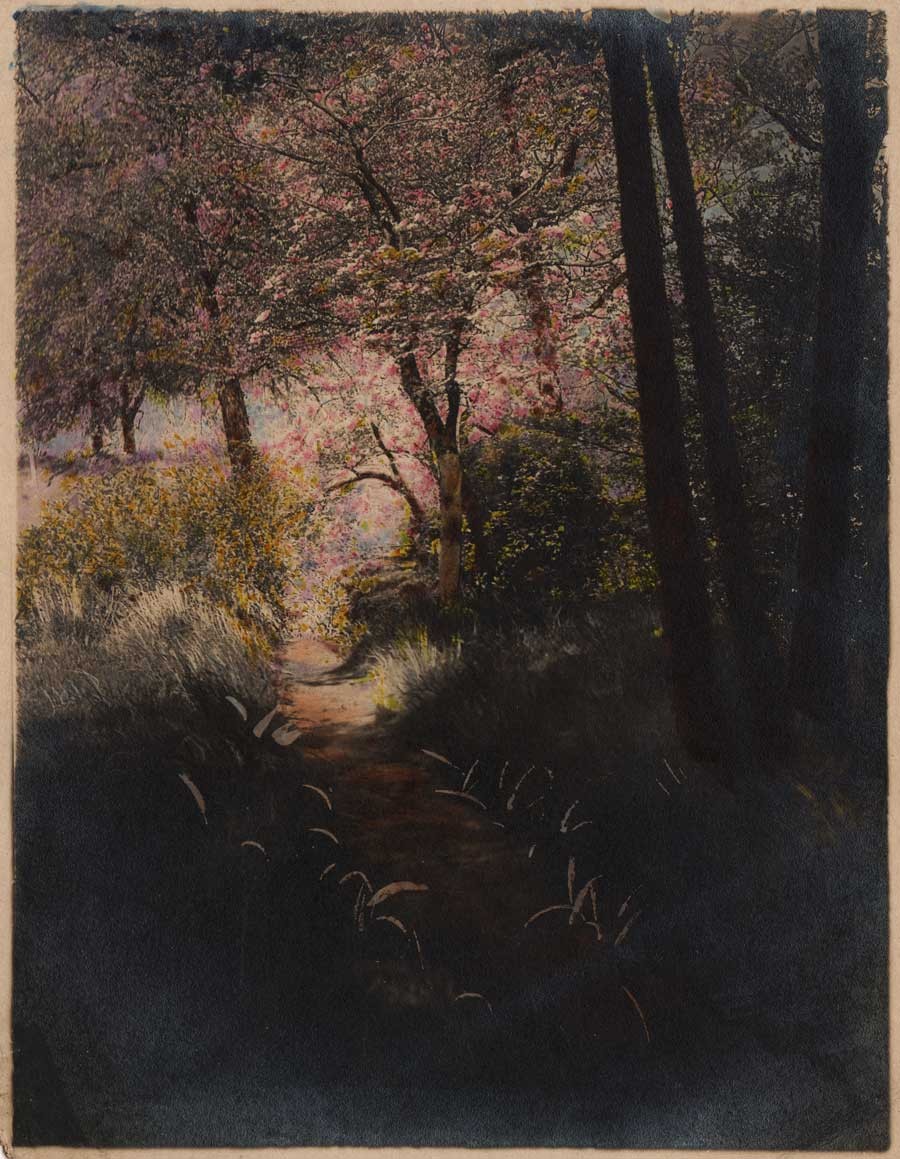 "Spring at Prospect Park"(Brooklyn, New York): ca. 1910-20: Unknown Brooklyn photographer: hand-colored gelatin silver: 11.8 x 9.0 cm | 13.2 x 9.9 cm: from: PhotoSeed Archive
"Spring at Prospect Park"(Brooklyn, New York): ca. 1910-20: Unknown Brooklyn photographer: hand-colored gelatin silver: 11.8 x 9.0 cm | 13.2 x 9.9 cm: from: PhotoSeed Archive
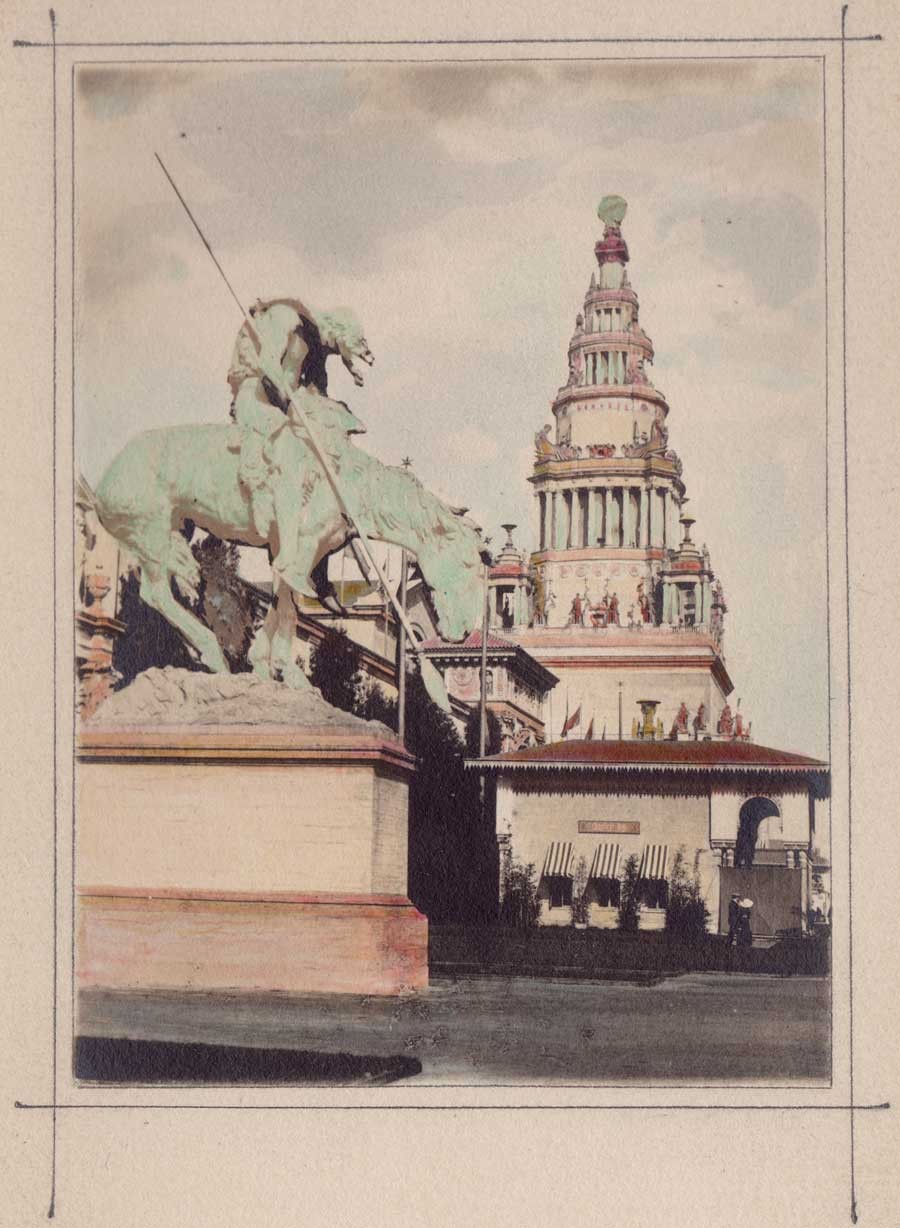 "The End of the Trail": sculpture by James Earle Fraser (American: 1876-1953) at Panama-Pacific International Exposition, San Francisco, California (Tower of Jewels in background) : 1915: Unknown Brooklyn photographer: hand-ruled & colored gelatin silver: 11.0 x 8.0 cm | 17.1 x 11.5 cm: from: PhotoSeed Archive
"The End of the Trail": sculpture by James Earle Fraser (American: 1876-1953) at Panama-Pacific International Exposition, San Francisco, California (Tower of Jewels in background) : 1915: Unknown Brooklyn photographer: hand-ruled & colored gelatin silver: 11.0 x 8.0 cm | 17.1 x 11.5 cm: from: PhotoSeed Archive
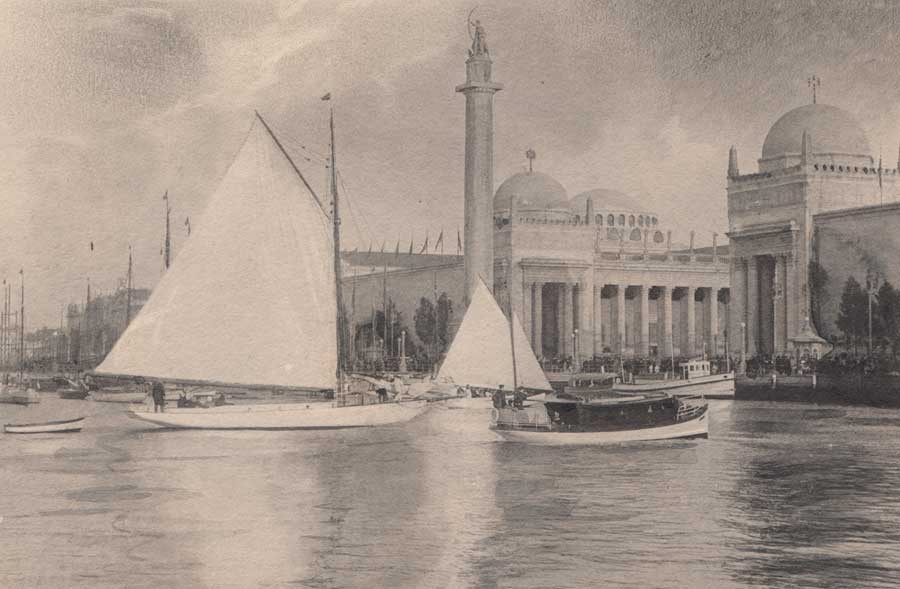 Detail: "Yacht Harbor at Panama-Pacific International Exposition" (Palaces of Agriculture & Transportation in background): 1915: Unknown Brooklyn photographer: gelatin silver with ink wash & photographic border: 7.4 x 11.5 cm | 11.4 x 17.8 cm: from: PhotoSeed Archive
Detail: "Yacht Harbor at Panama-Pacific International Exposition" (Palaces of Agriculture & Transportation in background): 1915: Unknown Brooklyn photographer: gelatin silver with ink wash & photographic border: 7.4 x 11.5 cm | 11.4 x 17.8 cm: from: PhotoSeed Archive
Several other photographs showing an unknown woman, most likely the photographer’s wife, or perhaps the artist herself, (can’t be ruled out) were also included in the trunk photographs. In one, a full-length profile view, she examines a Magnolia blossom in a park setting. (shown here) In another, her gaze is directed towards the camera while wearing an Asian influenced floral dress posing in front of blooming Wisteria vines. The dealer who had initially acquired the photographs, according to the seller I purchased them from, stated they had been acquired from the estate of a woman, (most likely depicted in the photographs) who had (presumably) attended or graduated from Wesleyan Female College, (now Wesleyan College) in Macon, Georgia at the turn of the 20th Century.
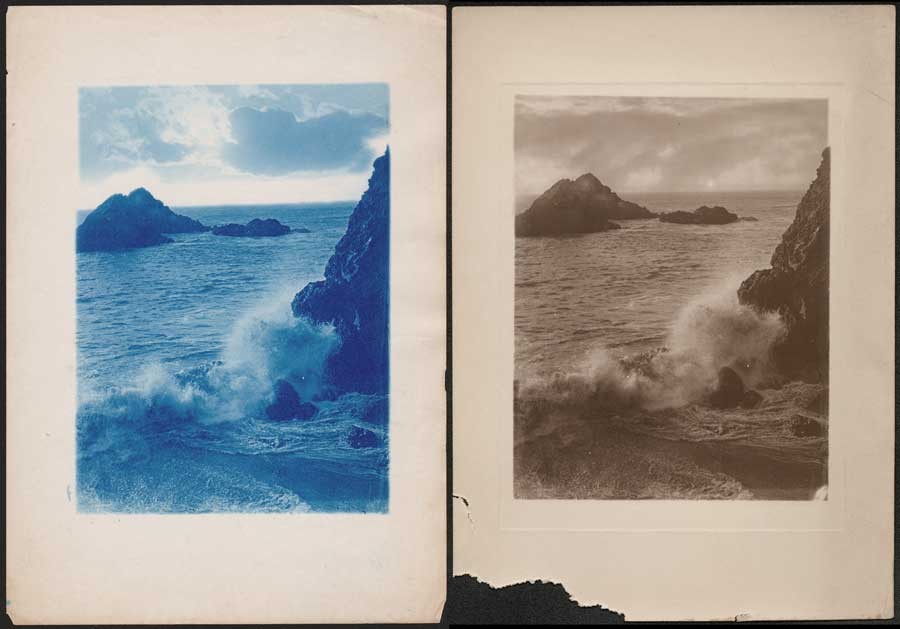 L: "Coastline with Rocks & Wave Action" (possibly California ) :12.3 x 9.0 cm | 17.7 x 12.6 cm: ca. 1910-1920: Unknown Brooklyn photographer: cyanotype with addition of clouds from alternate source photo: R: variant: "Coastline with Rocks & Wave Action" (possibly California) : 11.5 x 9.0 cm | 17.6 x 12.7 cm: ca. 1910-1920: Unknown Brooklyn photographer: gelatin silver: (mouse damage to lower margin): both from: PhotoSeed Archive
L: "Coastline with Rocks & Wave Action" (possibly California ) :12.3 x 9.0 cm | 17.7 x 12.6 cm: ca. 1910-1920: Unknown Brooklyn photographer: cyanotype with addition of clouds from alternate source photo: R: variant: "Coastline with Rocks & Wave Action" (possibly California) : 11.5 x 9.0 cm | 17.6 x 12.7 cm: ca. 1910-1920: Unknown Brooklyn photographer: gelatin silver: (mouse damage to lower margin): both from: PhotoSeed Archive
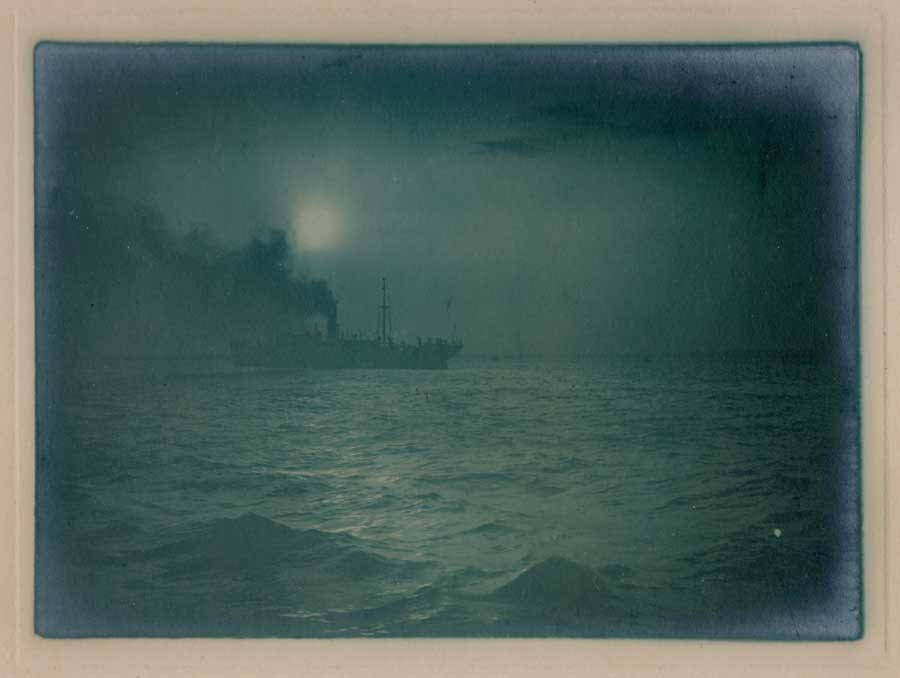 "Steamer in New York Harbor": ca. 1910-20: Unknown Brooklyn photographer: green toned gelatin silver: 8.4 x 11.6 cm | 12.3 x 17.9 cm: from: PhotoSeed Archive
"Steamer in New York Harbor": ca. 1910-20: Unknown Brooklyn photographer: green toned gelatin silver: 8.4 x 11.6 cm | 12.3 x 17.9 cm: from: PhotoSeed Archive
And even though the photographs ended their life residing in a mystery trunk in the American South, I’ll label them for now as being the work of Unknown Brooklyn, in order to keep their attribution consistent for those searching this archive going forward.
The Permanence of Disruption
Posted August 2014 in History of Photography, Painters|Photographers, Photography, Publishing, Significant Photographers
By all accounts, Scotsman David Octavius Hill, (1802-1870) Secretary of the Royal Scottish Academy of Fine Arts in Edinburgh, was an accomplished landscape painter. Thankfully, for the nascent medium of photography beginning around 1843, he is not remembered for that. Blame the Disruption, if you will.
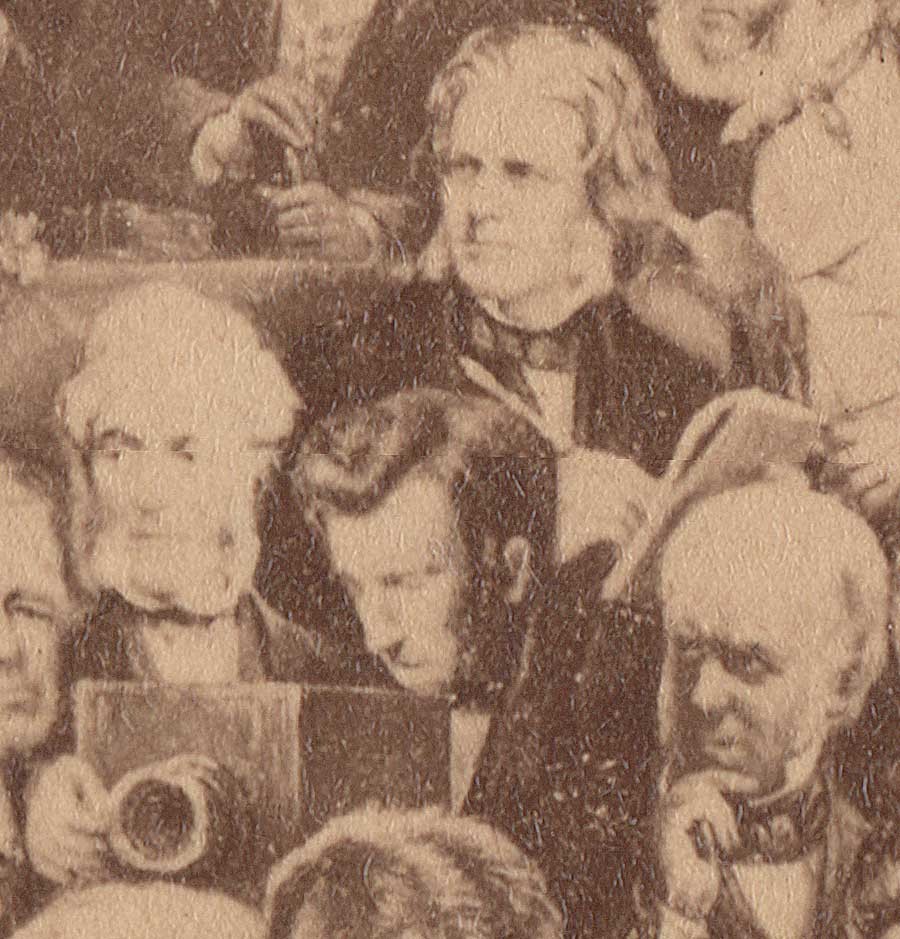 Detail: 1868: Artist David Octavius Hill with sketchpad at top; Photographer Robert Adamson behind wooden box camera at bottom. : Thomas Annan: vintage carbon copy photograph after D.O. Hill painting: "The Disruption of the Church of Scotland"completed 1866: original: (13.5 x 31.4 cm | 34.4 x 41.4 cm ) : from: PhotoSeed Archive
Detail: 1868: Artist David Octavius Hill with sketchpad at top; Photographer Robert Adamson behind wooden box camera at bottom. : Thomas Annan: vintage carbon copy photograph after D.O. Hill painting: "The Disruption of the Church of Scotland"completed 1866: original: (13.5 x 31.4 cm | 34.4 x 41.4 cm ) : from: PhotoSeed Archive
Disruption with a capitol D? He didn’t know it at the time, but when the freethinking Hill, a devout churchman seen above in detail in his own painting, sketchpad in hand, attended what became known as the Disruption: or, the historical occasion of Scottish religious free will known as the First General Assembly of the Free Church of Scotland signing the Act of Separation and Deed of Demission at Edinburgh’s Tanfield Hall, the artistic potential of photography would soon stake its’ own claim among the arts.
The Scots are Coming
Admittedly, the focus of this website doesn’t claim any great insights into the evolution of early photography, with the exception that certain photographers, those being the team of Hill and fellow Scotsman Robert Adamson, (1821-1848) popularly known as “Hill & Adamson”, are profoundly important to our understanding of artistic developments in relation to photography that came later in the 19th Century. Similar to the concept of how precedent by itself can build a case in the courtroom or in the more democratic court of public opinion, the reach of Hill & Adamson through their artistic achievement, especially in portraiture, impacted greatly the later working methods of many photographers and in particular, the eventual achievement of two fellow Scots who came into their orbit: Thomas Annan and his son James Craig Annan beginning around 1865 and in the early 1890’s.
As for that “Disruption” in relation to Hill’s completion 23 years later of an over-sized painting commemorating the event, the decision to separate from the accepted order gave former Church of Scotland congregations the freedom from central Church control to choose their own ministers, among other religious freedoms. For this alone, photography’s potential was nicely summed up in the London Art-Union journal in late 1869:
To photography Mr. Hill, soon after its discovery, about the year 1843, gave much attention, and we shall not be wrong in assigning him the credit of giving to the process its first artistic impetus; and, in conjunction with his friend, Mr. R. Adamson, of having produced many specimens of the Talbotype as yet unsurpassed for high artistic qualities. (1.)
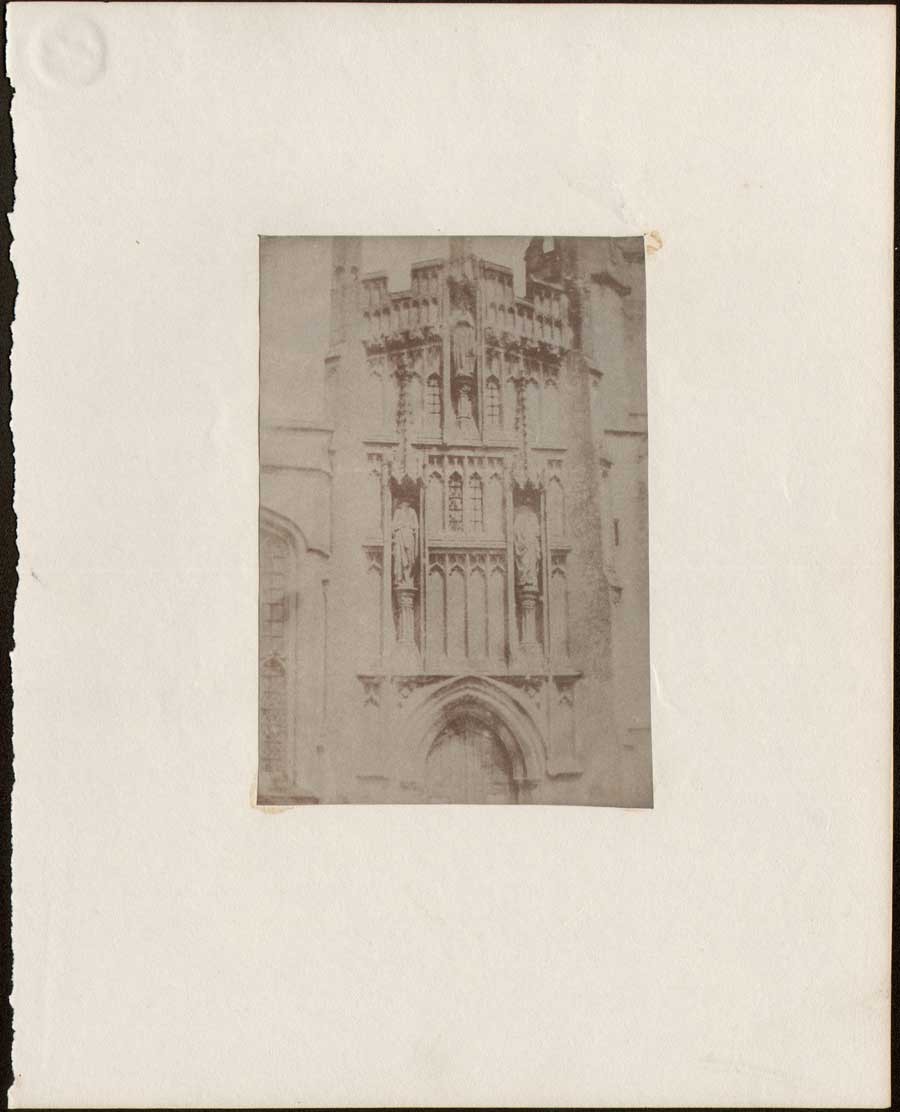 Example of vintage mounted salt print from calotype negative:(trimmed) : ca. 1845-1855: unknown photographer and location: detail from facade of English or Continental church building: ca. 1845-55: 12.8 x 8.8 | 24.9 x 19.9 cm: from PhotoSeed Archive
Example of vintage mounted salt print from calotype negative:(trimmed) : ca. 1845-1855: unknown photographer and location: detail from facade of English or Continental church building: ca. 1845-55: 12.8 x 8.8 | 24.9 x 19.9 cm: from PhotoSeed Archive
Thank the Calotype
Because the patent restricting Englishman William Henry Fox-Talbot’s 1841 invention of the Calotype process did not apply in Scotland, Hill & Adamson were able to exploit it to full potential. I’ve uploaded an example above, which in viewable form is technically known as a salted paper print from a calotype negative, for comparison. A survivor showing a bit of Gothic architectural detail, it was most likely done between 1845-1855 and found tucked between the pages of this archive’s copy of the aforementioned monthly Art-Union from 1846: the first magazine in history to publish (6000 copies) an example of a Talbotype “Sun Pictures” process calotype.
For a relatively clear understanding of what this early, yet cumbersome two-step process was, former George Eastman House Senior Curator of Photography William R. Stapp wrote in the pages of Image magazine from 1993 on the occasion of a seminal show of original Hill & Adamson calotypes held by the institution:
Calotypes are made on paper. The process requires the photographer to sensitize a sheet of good quality writing paper by brushing it with successive solutions of silver nitrate, potassium iodide, gallic acid, and silver nitrate. After being dried in the dark, the sensitized paper is loaded in the camera; after an exposure of several minutes, the negative is developed by brushing the paper with a solution of gallic acid and silver nitrate, fixed in a bath of sodium thiosulfate (“hypo”) to remove unexposed silver salts, and washed. When dried, this typically dense and contrasty negative is used to make a positive print on so called “salted paper,” which the photographer also has to prepare. This time a sheet of the same good quality writing paper is soaked first in a solution of sodium chloride (ordinary table salt, hence the term “salted paper”), then in a solution of silver nitrate, to produce the halide silver chloride. After it has been dried in the dark, the now light-sensitive salted paper is exposed to the negative in strong sunlight until the image is printed-out on it in deep orange hues. The resulting positive print is fixed in hypo, toned with gold chloride to a rich reddish-brown color, and washed to remove the residual chemistry. In all modern photographic materials, a transparent gelatin emulsion coated on the film or paper support contains the silver particles that form the image. Neither the calotype negative nor the calotype positive has an emulsion of any kind. The image resides literally within the fibers of the paper because the paper itself has been permeated with the photosensitive chemicals. A calotype print consequently incorporates the “tooth” (texture) of both the negative paper and the positive paper in its image. The print has a texture that is both visual and physical, which softens the image and mutes the rendition of detail. (2.)
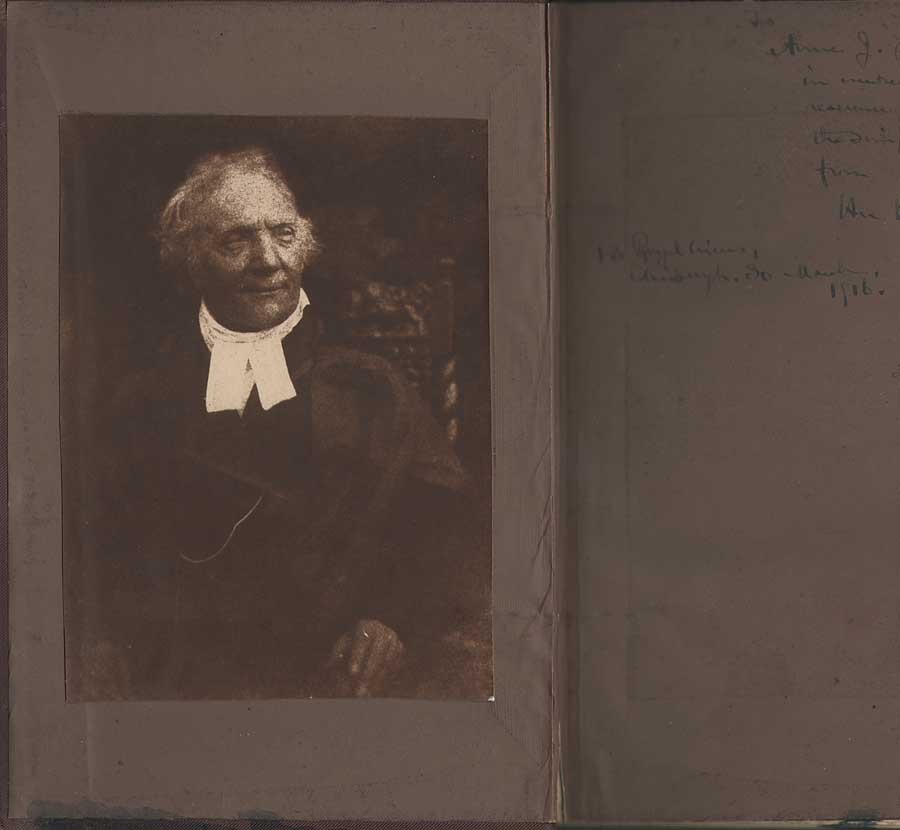 Pasted carbon print: ca. 1916: The Rev. Dr. Thomas Chalmers: (1780-1847) minister, social reformer, leader & first Moderator of the Free Church of Scotland Assembly, Principal of New College, Edinburgh.:15.2 x 11.1 cm: Jesse Bertram: after original ca. 1843 calotype by Hill & Adamson.: shown on opened, inside board cover to volume: "A Selection from the Correspondence of the late Thomas Chalmers, D.D. LL.D." : Edinburgh: Thomas Constable and Co. : 1853: from PhotoSeed Archive
Pasted carbon print: ca. 1916: The Rev. Dr. Thomas Chalmers: (1780-1847) minister, social reformer, leader & first Moderator of the Free Church of Scotland Assembly, Principal of New College, Edinburgh.:15.2 x 11.1 cm: Jesse Bertram: after original ca. 1843 calotype by Hill & Adamson.: shown on opened, inside board cover to volume: "A Selection from the Correspondence of the late Thomas Chalmers, D.D. LL.D." : Edinburgh: Thomas Constable and Co. : 1853: from PhotoSeed Archive
Activism, and a bit of Fate
As fate would have it, one of those involved with the Scottish Free Church movement was Fox-Talbot correspondent Sir David Brewster. A friend of “Disruption” general assembly moderator, the Rev. Dr. Thomas Chalmers, (1780-1847) who was a minister, social reformer and evangelical orator of high renown chiefly responsible for the secession from the established Church, Brewster early on had learned the Calotype process from his friend Talbot. Teaming with Saint Andrews University chemistry professor John Adamson, they in turn taught it to Adamson’s younger brother Robert Adamson in 1842 after he had moved to Edinburgh.
And the rest they say is history. With Brewster also present at the assembly signing with Hill, he in turn suggested the new process to the painter as a way to solve the dilemma of accurately portraying the hundreds of clergy and others present at the “Disruption” for posterity.
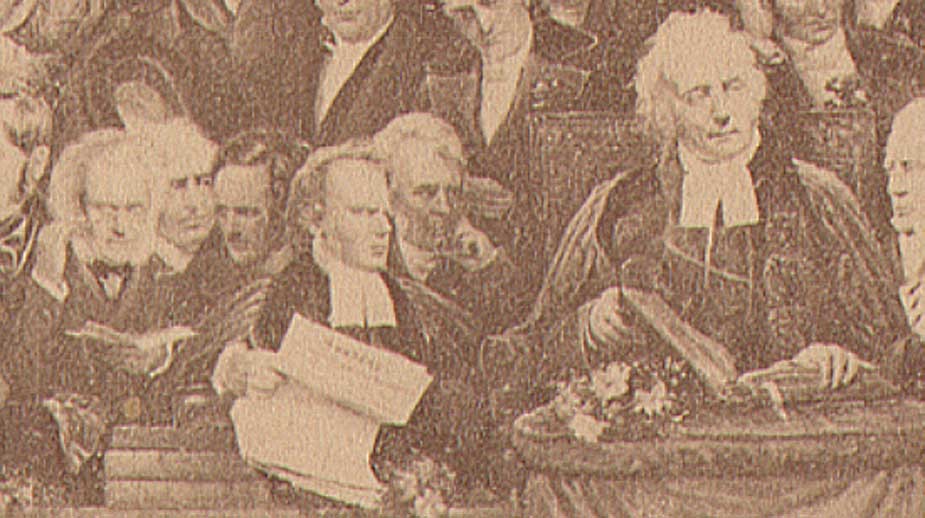 Detail: 1868: far right: Rev. Dr. Thomas Chalmers: Free Church of Scotland moderator along with major figures left to right: Scottish photography pioneer Sir David Brewster, (wearing spectacles looking down at book) Rev. Robert Lorimer, Rev. John Forbes, Dr. David Welsh: undivided Church of Scotland moderator holding a copy of May 18, 1843 church protest that was never answered, Dr. John Fleming, Chalmers. : Thomas Annan: vintage carbon copy photograph after D.O. Hill painting: "The Disruption of the Church of Scotland"completed 1866: original: (13.5 x 31.4 | 34.4 x 41.4 cm ) : from PhotoSeed Archive
Detail: 1868: far right: Rev. Dr. Thomas Chalmers: Free Church of Scotland moderator along with major figures left to right: Scottish photography pioneer Sir David Brewster, (wearing spectacles looking down at book) Rev. Robert Lorimer, Rev. John Forbes, Dr. David Welsh: undivided Church of Scotland moderator holding a copy of May 18, 1843 church protest that was never answered, Dr. John Fleming, Chalmers. : Thomas Annan: vintage carbon copy photograph after D.O. Hill painting: "The Disruption of the Church of Scotland"completed 1866: original: (13.5 x 31.4 | 34.4 x 41.4 cm ) : from PhotoSeed Archive
Twenty-three years later, most likely with the help of Hill’s second wife Amelia Paton, (1820-1904) a sculptress, the Disruption painting, measuring in finished at over 11 feet by 5 feet, was ready for public display. And this is where it gets interesting for the career of Thomas Annan (1829–1887) and much later, his son James Craig Annan. (1864-1946) The decision to copy the painting for a mass audience was never in doubt for Hill, a man well-connected with the Scottish publishing trade who was born into it; his father being a bookseller and publisher. Hill had even learned the art of lithography from an early age, using it in the reproduction of his own work as a landscape painter for 20 years.
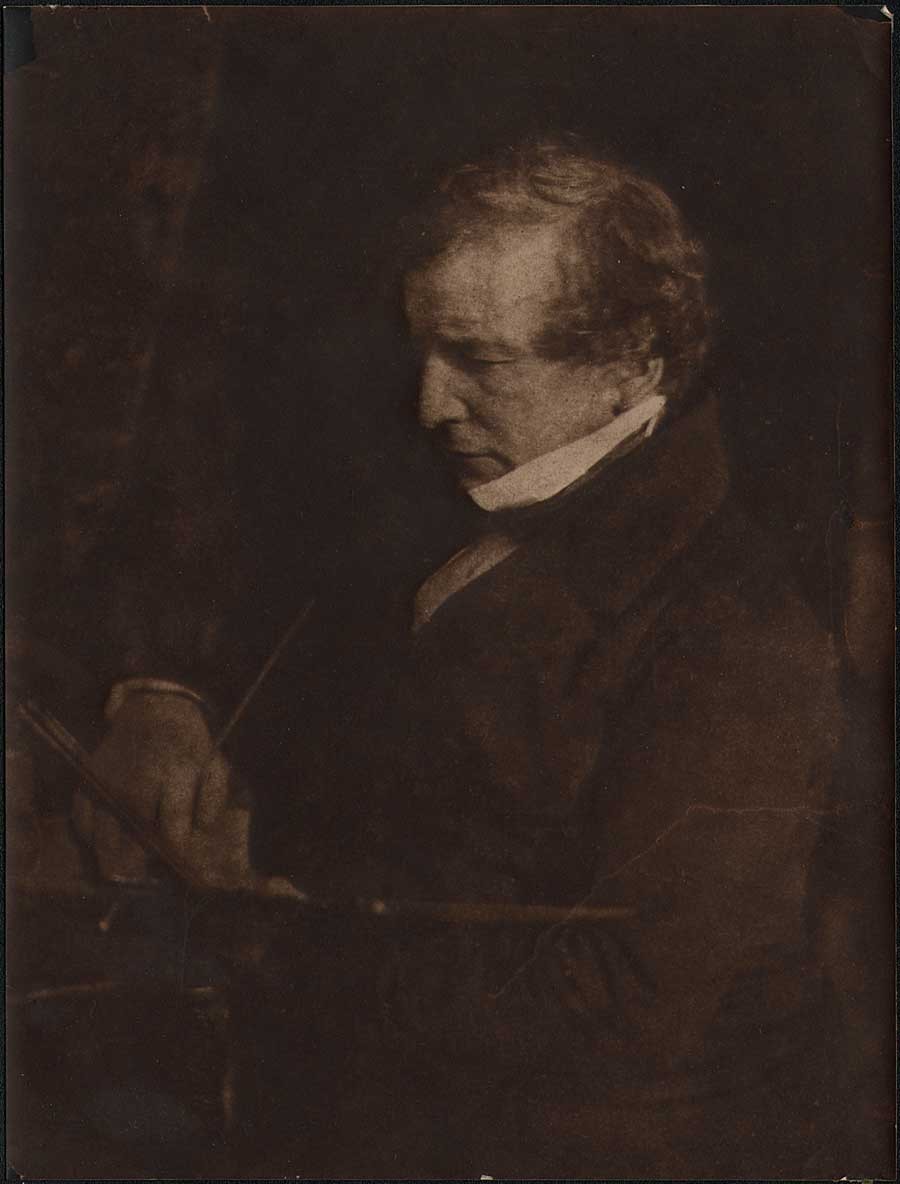 Carbon print: ca. 1879 - 1881 : William Etty, R.A. (English painter: 1787-1849) : Thomas Annan or James Craig Annan: after original 1844 calotype paper negative by Hill & Adamson: 18.5 x 14.0 cm: former collection: Exeter Camera Club: from PhotoSeed Archive
Carbon print: ca. 1879 - 1881 : William Etty, R.A. (English painter: 1787-1849) : Thomas Annan or James Craig Annan: after original 1844 calotype paper negative by Hill & Adamson: 18.5 x 14.0 cm: former collection: Exeter Camera Club: from PhotoSeed Archive
In 1865, shortly before his masterwork was finished, Hill made the acquaintance of Annan by reputation through his brother Alexander’s art gallery in Edinburgh. Annan’s copy paintings had been displayed there, for he had already made a name for himself in this line of work as early as 1862, producing fine copies of artwork for the Glasgow Art Union. These Art Unions “were lotteries connected with the major art exhibitions; the successful subscribers won paintings, and every subscriber received an engraving.” (3)
A commission resulted between Hill and Annan to copy Hill’s Disruption masterwork, a canvas that unfortunately- as opposed to the hundreds of Hill & Adamson calotypes used for reference works in its’ creation and now considered masterpieces of the photographic art-did not equate it to a masterpiece itself. Annan employed for this task an improved permanent carbon photographic process, using Joseph Wilson Swan’s 1864 patent carbon tissue to reproduce copies of the “Disruption” after purchasing the Scottish rights from him in 1866. (4.)
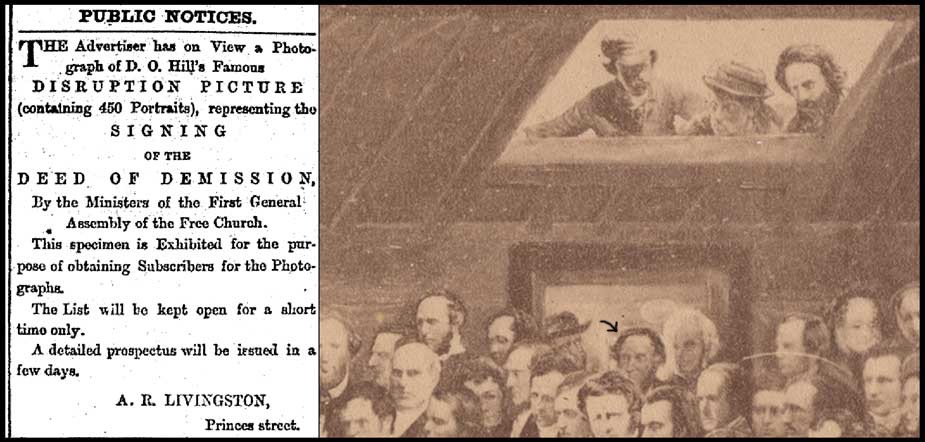 Left: 1868: advertisement: New Zealand bookseller A.R. Livingston's solicitation for Thomas Annan carbon photo of "Disruption Picture" completed 1866 by D.O. Hill: published in Otago Daily Times. Right: 1868: Detail: black arrow pointing to Thomas Annan standing in doorway painted as part of "Disruption" painting (another account states Annan is at left of this figure wearing hat) : Thomas Annan: vintage carbon copy photograph after D.O. Hill painting: "The Disruption of the Church of Scotland"completed 1866: original: (13.5 x 31.4 | 34.4 x 41.4 cm ) : from PhotoSeed Archive
Left: 1868: advertisement: New Zealand bookseller A.R. Livingston's solicitation for Thomas Annan carbon photo of "Disruption Picture" completed 1866 by D.O. Hill: published in Otago Daily Times. Right: 1868: Detail: black arrow pointing to Thomas Annan standing in doorway painted as part of "Disruption" painting (another account states Annan is at left of this figure wearing hat) : Thomas Annan: vintage carbon copy photograph after D.O. Hill painting: "The Disruption of the Church of Scotland"completed 1866: original: (13.5 x 31.4 | 34.4 x 41.4 cm ) : from PhotoSeed Archive
In addition to several detail photos of the painting included with this post, a mounted carbon copy photograph by Annan published in 1868 for the 25th anniversary of the signing of the Act of Separation and Deed of Demission can be seen in our archive here. For those adventurous enough to decipher names and titles of some of those making up the sea of faces in the painting, partly seen below, a fascinating, yet tricky key to some of the major figures can be found here. This was published as part of the 1943 centenary volume The Disruption Picture: A Memorial of the First General Assembly of the Free Church of Scotland by Donald MacKinnon. (5.)
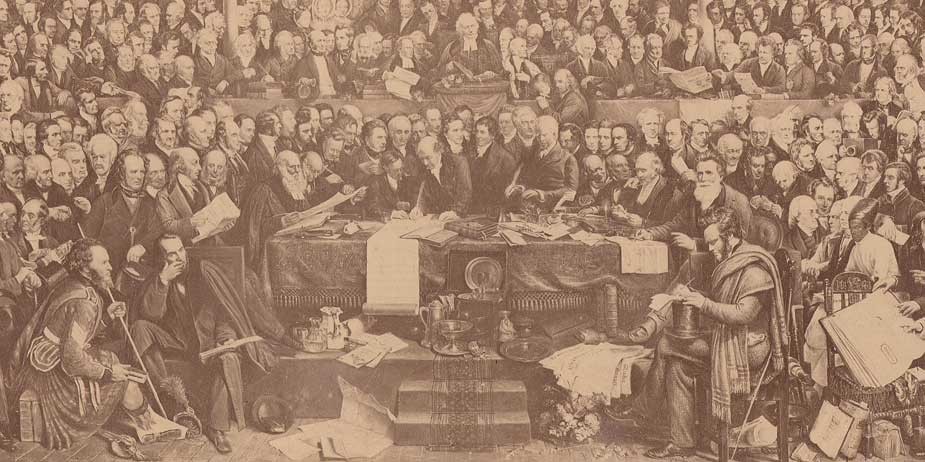 Detail: 1868: At center of table, the Rev. Dr. Patrick MacFarlan (1781-1849) of Greenock is first to sign the "Deed of Demission", "resigning the highest living in the Church of Scotland at the time", said to be £ 1000.00 annually, which commemorated the establishment of the Free Church of Scotland: Thomas Annan: vintage carbon copy photograph after D.O. Hill painting: "The Disruption of the Church of Scotland"completed 1866: original: (13.5 x 31.4 cm | 34.4 x 41.4 cm ) : from PhotoSeed Archive
Detail: 1868: At center of table, the Rev. Dr. Patrick MacFarlan (1781-1849) of Greenock is first to sign the "Deed of Demission", "resigning the highest living in the Church of Scotland at the time", said to be £ 1000.00 annually, which commemorated the establishment of the Free Church of Scotland: Thomas Annan: vintage carbon copy photograph after D.O. Hill painting: "The Disruption of the Church of Scotland"completed 1866: original: (13.5 x 31.4 cm | 34.4 x 41.4 cm ) : from PhotoSeed Archive
Thomas Annan, Documentarian
With Hill’s work complete, Thomas Annan’s professional career was starting to hit full stride, especially after his success with the Disruption commission. In 1868, the same year a version of this carbon photo was published, (6.) Annan undertook a new commission from the City of Glasgow Improvements Trust that when first published as a series of around 35 albumen prints in 1872, became known as The Old Closes & Streets of Glasgow. As previously outlined in my essay written in 2006 for the Luminous Lint website, Annan’s photographs taken between 1868-1871 are among the earliest done specifically for a record of slum housing conditions prior to urban renewal and as such are an important milestone in the history of documentary photography. (7)
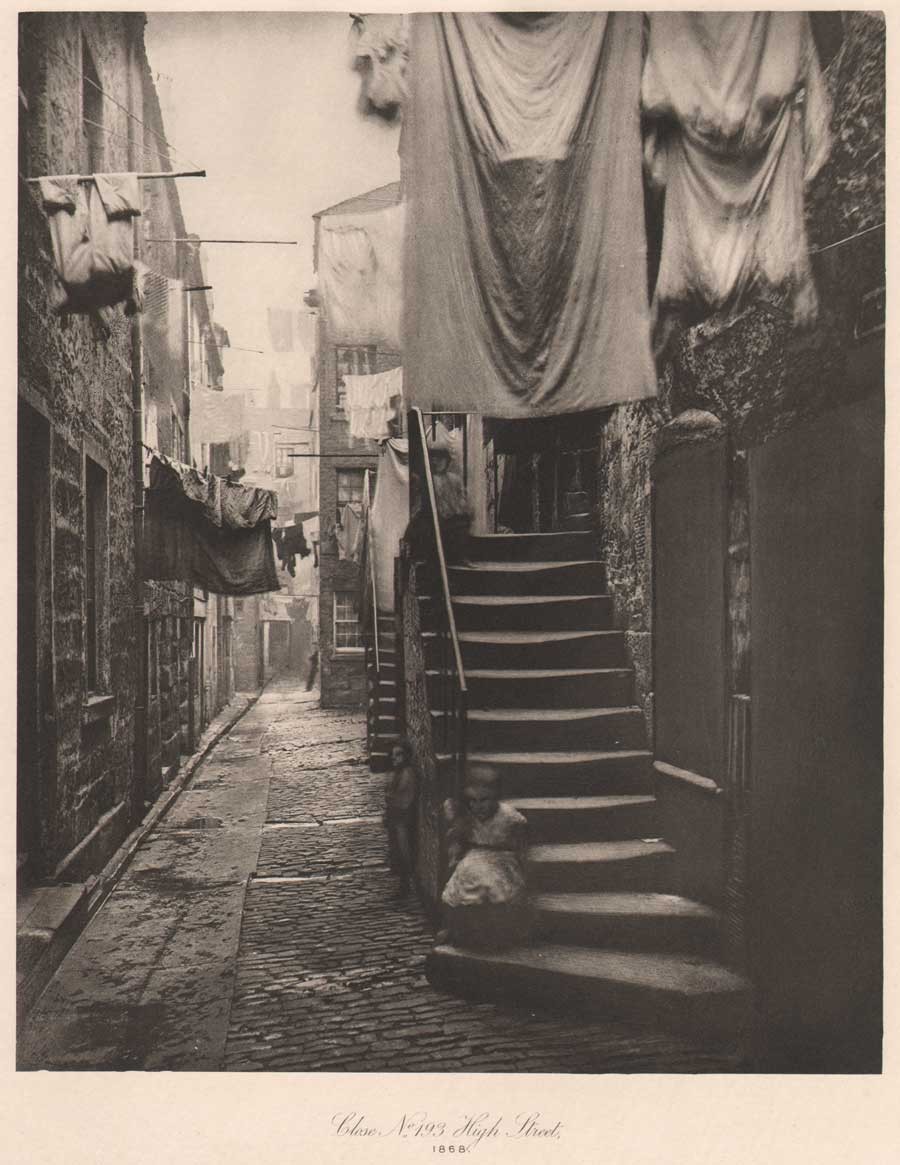 1868: vintage hand-pulled photogravure: "Close No. 193 High Street": Thomas Annan: from: "The Old Closes & Streets of Glasgow" - photographs taken for the City of Glasgow Improvements Trust : 22.2 x 18.1 | 38.0 x 28.5 cm: 1900: gravure from original collodion glass plate by James Craig Annan: Glasgow: plate #9 from James MacLehose & Sons limited edition of 100: from PhotoSeed Archive
1868: vintage hand-pulled photogravure: "Close No. 193 High Street": Thomas Annan: from: "The Old Closes & Streets of Glasgow" - photographs taken for the City of Glasgow Improvements Trust : 22.2 x 18.1 | 38.0 x 28.5 cm: 1900: gravure from original collodion glass plate by James Craig Annan: Glasgow: plate #9 from James MacLehose & Sons limited edition of 100: from PhotoSeed Archive
Perhaps knowing her husband’s photographic legacy might be carried on, Amelia Paton bequeathed to Annan “a large collection of calotypes and the portrait lens used by Hill and Adamson” after Hill’s death in 1870. (8.) Speculation he used this very lens for portraits taken soon after for his illustrated volume the Memorials of the Old College of Glasgow, (1871) with examples seen in this post, are an intriguing insight raised by Sara Stevenson in her biography of Annan. (9.) Proportionally, individual portraits taken by Hill & Adamson in the 1840’s compared with those by Annan of the professors from the Glasgow volume and are very similar. However, Annan had the advantage of using the collodion process as opposed to calotype, with the increase of sensitivity of these plates lending a sharpness to his work not possible as movement was often the inevitable result of the slower 2-3 minute exposures required for the older process.
A comparison showing the softness, beauty and masterful composition of a later generation carbon print portrait of English painter William Etty (1787-1849) done ca. 1843 by Hill and Adamson can be seen with this post along with portraits by Annan taken around 1870. These include the striking portrait of professor and theologian John Caird (1820-1898) that reveal compositional similarities between the photographers nearly 30 years apart. With the archival benefit of Annan printing his efforts in permanent carbon, it’s also amusing to see exposure times, although shorter than calotype, did not prevent him in at least one case from seizing the moment in order to permanently memorialize his subject and another unwitting one: a rather large housefly clinging to academic robes worn by University of Glasgow English Language and Literature Professor John Nichol.
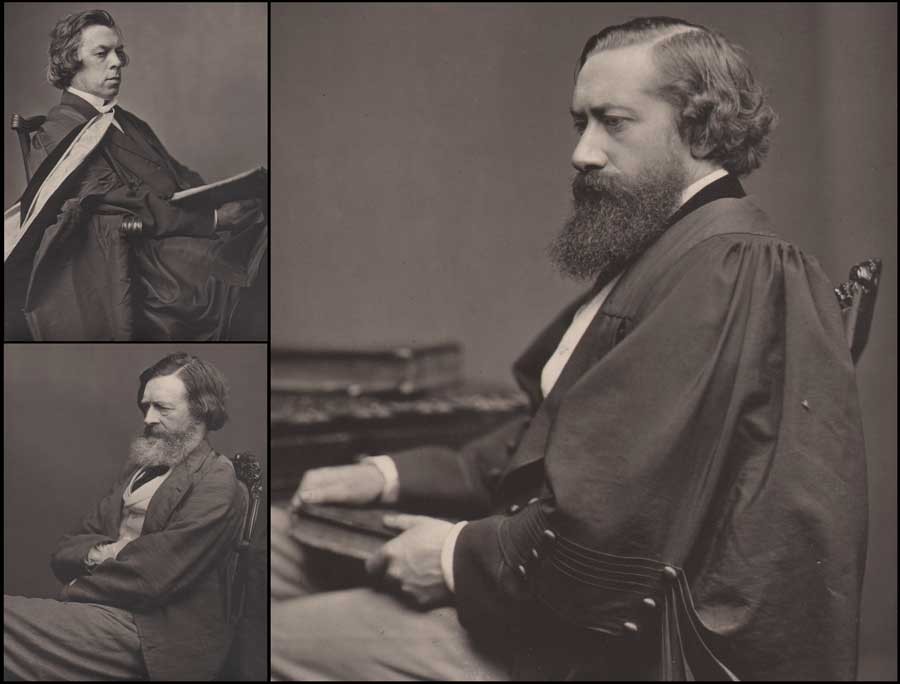 1871: Thomas Annan: mounted carbon portraits from"Memorials of the Old College of Glasgow"(each cropped) : all portraits 21.5 x 16.4 | 36.5 26.0 : upper left: Professor of Divinity John Caird (1820-1898) : lower left: Professor of Greek Edmund Law Lushington (1811-1893) : right: Regius Professor of English Language and Literature John Nichol (1833-1894) (note housefly on academic robe at right below chair back) : from PhotoSeed Archive
1871: Thomas Annan: mounted carbon portraits from"Memorials of the Old College of Glasgow"(each cropped) : all portraits 21.5 x 16.4 | 36.5 26.0 : upper left: Professor of Divinity John Caird (1820-1898) : lower left: Professor of Greek Edmund Law Lushington (1811-1893) : right: Regius Professor of English Language and Literature John Nichol (1833-1894) (note housefly on academic robe at right below chair back) : from PhotoSeed Archive
Besides University professors, Annan did many fine portraits of Free Church of Scotland ministers in addition to ministers, elders and missionaries affiliated with the United Presbyterian Church. A unique album of these portraits, reproduced in Woodburytype, is held by this archive, with several appearing in the 1875 Annan published volume Historical Notices of the United Presbyterian Congregations in Glasgow. As a businessman running a commercial studio, Annan marketed many of these images, often as variants, in the carte de visite format. The following is a listing of Annan’s Scotland studios with dates supplied by Peter Stubbs of the EdinPhoto web site:
202 Hope Street, Glasgow: 1862-72
77 Sauchiehall St. Glasgow: 1873-74
153 Sauchiehall St. Glasgow: 1875-91
75 Princes St. Edinburgh: 1876-82
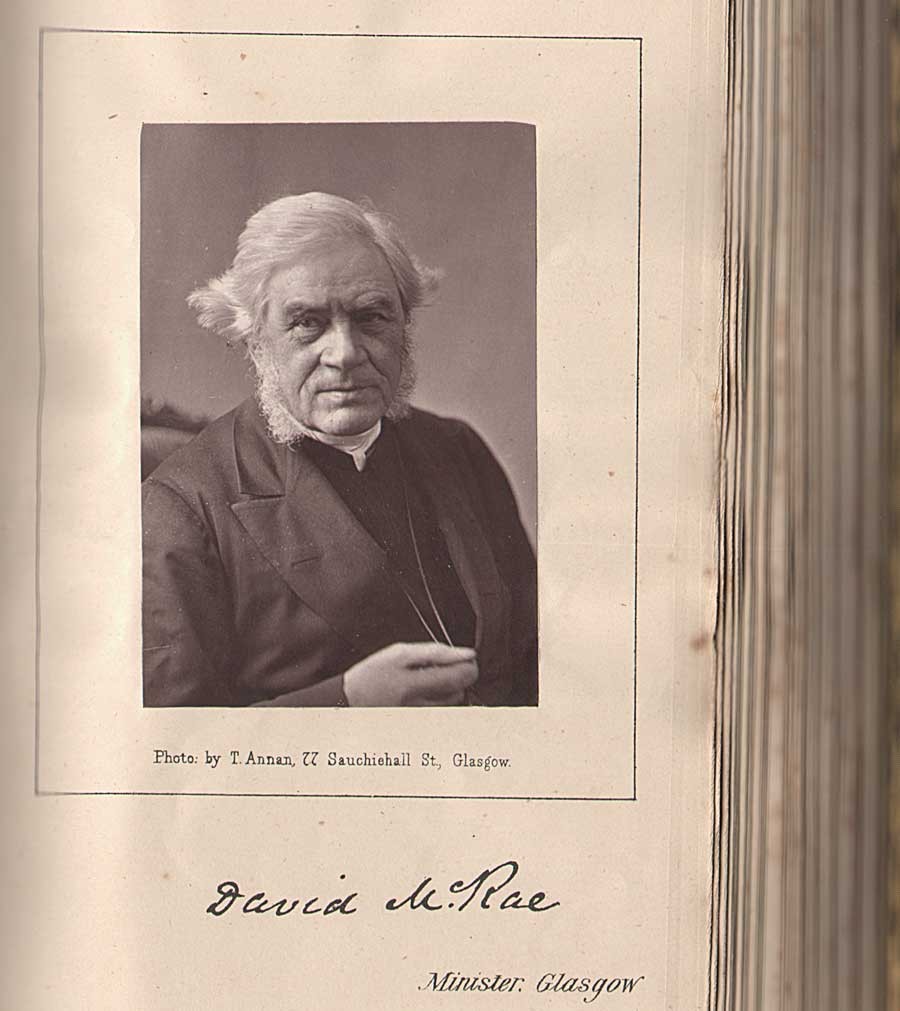 1873-74: Rev. David McRae of Glasgow: (a leading temperance movement leader from the 1850-70's) mounted Woodburytype portrait with facsimile autograph: Thomas Annan: 8.3 x 5.6 | 19.4 x 10.5 cm : from unique folio album of nearly 60 Woodburytype photographs taken ca. 1862-1882 by Thomas Annan and most likely John Annan of ministers, elders and missionaries affiliated with the United Presbyterian Church: from PhotoSeed Archive
1873-74: Rev. David McRae of Glasgow: (a leading temperance movement leader from the 1850-70's) mounted Woodburytype portrait with facsimile autograph: Thomas Annan: 8.3 x 5.6 | 19.4 x 10.5 cm : from unique folio album of nearly 60 Woodburytype photographs taken ca. 1862-1882 by Thomas Annan and most likely John Annan of ministers, elders and missionaries affiliated with the United Presbyterian Church: from PhotoSeed Archive
Coming full-circle: Learning Photogravure
In 1883, after purchasing the British rights to a new process of Photogravure invented by Czech artist Karl Klíc, (1841-1926) Thomas Annan and son James Craig Annan traveled to Vienna in order to personally learn its intricacies. As defined by our good friends over at Photogravure.com, Klíc’s 1879 refined process of “reproducing a photograph by printing on paper from an inked and etched copper plate” was a vast improvement over that of William Henry Fox Talbot’s 1858 patented Photoglyphic Engraving process. Thomas Annan was so smitten he wrote Klíc the following appreciation:
“I beg to express my entire satisfaction with your gravure process… The process itself is very valuable to a fine art publisher because of the beauty of the work and the crafted manner in which the plates are executed. With many thanks to me and my son I remain, Dear Sir, yours very truly” - Thomas Annan March 11, 1883 (10.)
Fittingly renamed the Talbot-Klíc Dust Grain Photogravure by Klíc, the process was soon fully embraced by Annan’s publishing concerns, T. & R. Annan and Sons of Glasgow, Hamilton and Edinburgh, who utilized photogravure for high-quality, fade-resistant and archival plates, mostly copies of original works of art, an established specialty. Soon, the new process, which involved the individual hand-pulling of plates from a copper-plate press, was further exploited and refined by the budding photographer James Craig Annan in the early 1890’s, whose original photographic negatives “from nature” during his travels to the Continent, particularly North Holland and Italy, were directly reproduced in gravure after an ongoing period of great experimentation and refinement.
Like his father Thomas, who reproduced and exhibited some of the Hill & Adamson calotypes in carbon during the 1870’s and early 80’s using his own refinements of Swan’s process, (11.) James Craig Annan fully embraced Talbot-Klíc gravure printing to reinterpret their landmark achievements in early pictorial portraiture as well as other studies including the fisherfolk of Newhaven near Edinburgh. In this regard, beginning as early as 1890, Annan produced a series of hand-pulled gravures re-photographed from the original Hill & Adamson paper calotype “negatives in the possession of Andrew Elliott.” (12.) Later in 1905, working as part of the T & R Annan firm of Glasgow, he produced a further series of 20 plates printed on Japan tissue. (13.) These copper plates were then re-used for a series of gravures published in Alfred Stieglitz’s Camera Work XI, (1905) XXVIII, (1909) and XXXVII, (1912) thereby introducing new generations to the masterful legacy left by Hill & Adamson.
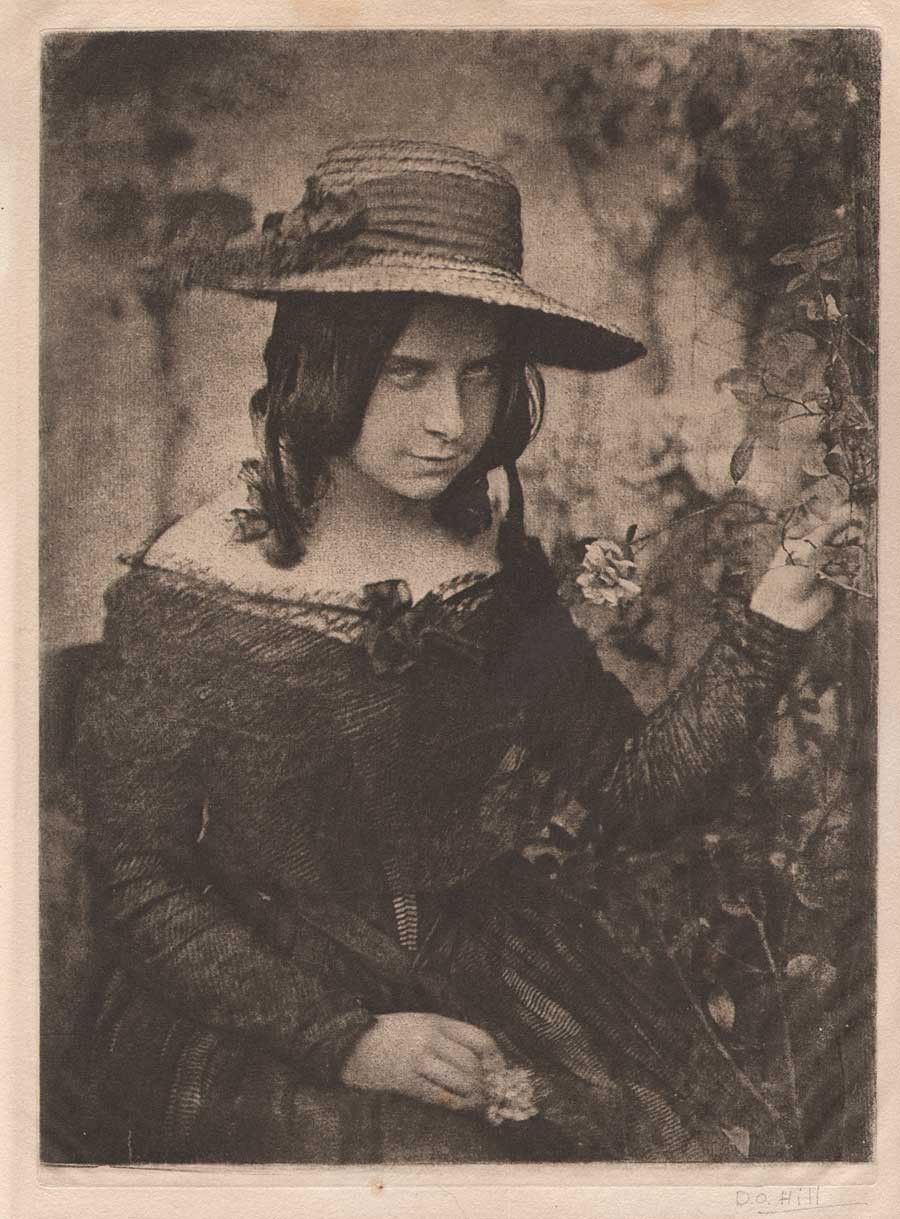 1890-1912: "Girl in Straw Hat" (Miss Mary McCandlish) : vintage hand-pulled photogravure trimmed and mounted within cream paper folder: possibly a 1912 Camera Work proof: 21.5 x 15.9 |25.5 x 19.0 cm: James Craig Annan after original paper calotype ca. 1843-47 by Hill & Adamson: reproduced in CW XXXVII: originally in Margaret Harker Collection: from PhotoSeed Archive
1890-1912: "Girl in Straw Hat" (Miss Mary McCandlish) : vintage hand-pulled photogravure trimmed and mounted within cream paper folder: possibly a 1912 Camera Work proof: 21.5 x 15.9 |25.5 x 19.0 cm: James Craig Annan after original paper calotype ca. 1843-47 by Hill & Adamson: reproduced in CW XXXVII: originally in Margaret Harker Collection: from PhotoSeed Archive
I’ll end this lengthy post with an excerpt from an appreciation of D.O. Hill by James Craig Annan, who was fortunate to have met and been inspired by the artist when he was only six years old- the result of his father being an intimate friend of Hill. This was included as part of a larger essay he wrote on the Scottish pioneer for Camera Work XI, and he makes the strong case their achievement was a direct result of their portrait collaborations for the Disruption painting:
“Thus the partnership began which was to produce the noble and extensive series of portraits which for powerful characterization and artistic quality of uniformly high excellence have certainly never been surpassed and possibly not even rivaled by any other photographer. This may seem an extravagant appreciation of Hill’s work, but it has been arrived at after mature deliberation.” (14.)
-David Spencer
Notes:
1. British Artists: Their Style and Character: With Engraved Illustrations. : David Octavius Hill, R.S.A.: in: The Art-Journal: London: October 1, 1869: p. 317
2. William F. Stapp.: Hill and Adamson: Artists of the Calotype: from: Image: George Eastman House: Spring/Summer: Vol. 36: No. 1-2: 1993: p. 55
3. Sara Stevenson: Scottish Masters 12: Thomas Annan: National Galleries of Scotland: 1990: p. 5
4. After discussions with Hill, the copy photograph of the “Disruption“canvas was taken by Thomas Annan after he had ordered “a large Photographic Camera of the latest and most perfect construction” from Dallmeyer: in: 1866 Disruption prospectus by Hill: published in: Scottish Masters 12: p. 7
5. Alan Newble has thoughtfully, and no doubt, painstakingly, compiled the key as part of his website, with further insights on the historical importance of the Rev. Dr. Thomas Chalmers.
6. In correspondence between Annan and Hill in late December, 1865, Hill stated he wanted the Disruption painting reproduced in thousands of photographs in 3 separate sizes. “He (Hill) was hoping for prints half the size of the painting, and suggested that Annan make them in three parts, joining them together around the figures rather than in an arbitrary straight line.” : from: Hill & Annan letters: quoted in: Scottish Masters 12: pp. 6-7. Alas, Hill’s desires were trumped by technical limitation, with carbon prints supplied by Annan printed in 1866 in 3 sizes, as stated in the Photographic News of London: “Photographs of the picture will be issued in three sizes, ranging from 24 inches by 9 inches to 48 inches by 21 1/4 inches, at prices ranging from a guinea and a half to twelve guineas.”
7. The carbon print edition of Old Closes first appeared in 1877, with two later photogravure editions featuring 50 plates each printed by James Craig Annan published in 1900. Fine examples of the albumen prints from Old Closes can be found along with superb background on their making at the University of Glasgow Library special collections department online resource found here.
8. cited in Scottish Masters 12: p. 8
9. Ibid: p. 13
10. from: Photogravure.com online resource accessed August, 2014. While in Vienna under Klíc’s watchful eye, the Annans had produced a photogravure of Noel Paton’s painting of The Fairy Raid.
11. Scottish Masters 12: p. 8
12. David Octavius Hill & Robert Adamson: in: The Collection of Alfred Stieglitz: Weston Naef: New York: The Metropolitan Museum of Art: p. 378. Elliott, (1830-1922) was a nephew of D.O. Hill
13. Ibid, p. 378
14. excerpt: David Octavius Hill, R.S.A. ⎯1802-1870.: J. Craig Annan: in: Camera Work XI: New York: edited and published by Alfred Stieglitz:1905: p. 18
Performance, not Results
Posted March 2014 in New Additions, Photography
Besides the obvious: a permanent, for the most part, result in the form of a photograph; the act of taking said photograph could be argued as being just as important. For some, it really is the point.
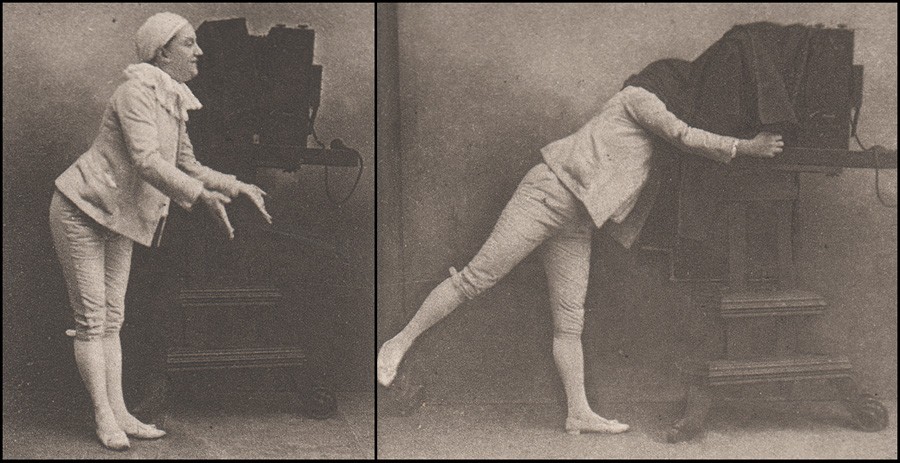 Left: Pantomime clown Pierrot played by French actress Félicia Mallet (1863-1928) introduces himself to subject in the Photography studio. Right: Pierrot steps underneath the dark cloth while focusing the camera. Details-both: (5.7 x 4.3 cm & 5.7 x 5.4 cm) Arthur da Cunha: "Pierrot Photographe": vintage hand-pulled photogravure from March, 1896 issue of the Bulletin du Photo-Club de Paris: PhotoSeed Archive
Left: Pantomime clown Pierrot played by French actress Félicia Mallet (1863-1928) introduces himself to subject in the Photography studio. Right: Pierrot steps underneath the dark cloth while focusing the camera. Details-both: (5.7 x 4.3 cm & 5.7 x 5.4 cm) Arthur da Cunha: "Pierrot Photographe": vintage hand-pulled photogravure from March, 1896 issue of the Bulletin du Photo-Club de Paris: PhotoSeed Archive
Can I take your picture? Why sure. Why would you be interested may I ask? Because…
I find you: insert adjective here. Or don’t ask permission.
Because. No real reason at all, other than it sorta confirms your existence for posterity. So not a bad tradeoff, especially for those who might want to look back, far off in the future, or five minutes from now.
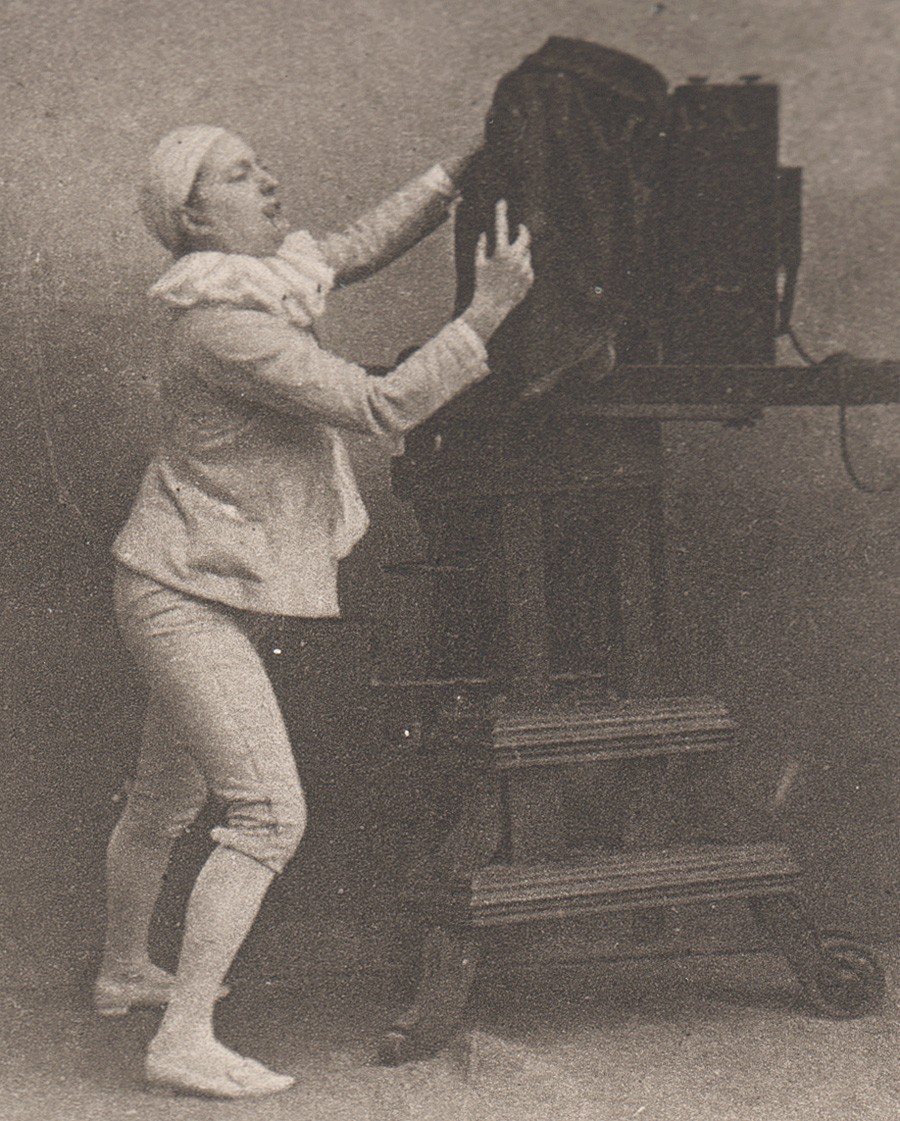 Pantomime clown Pierrot played by French actress Félicia Mallet (1863-1928) places the film back into the rear of the studio camera. Detail: (5.7 x 4.3 cm) Arthur da Cunha: "Pierrot Photographe": vintage hand-pulled photogravure from March, 1896 issue of the Bulletin du Photo-Club de Paris: PhotoSeed Archive
Pantomime clown Pierrot played by French actress Félicia Mallet (1863-1928) places the film back into the rear of the studio camera. Detail: (5.7 x 4.3 cm) Arthur da Cunha: "Pierrot Photographe": vintage hand-pulled photogravure from March, 1896 issue of the Bulletin du Photo-Club de Paris: PhotoSeed Archive
Going back well over a century, this series of photographs is confirmation act has always been wrapped up in art. For proof, observe the capable body language of voiceless French actress Félicia Mallet, (1863–1928) published in 1896 and recently posted. As Pierrot, she was taking on the role modern scholars consider the essence of the artist’s alter-ego. Especially as some might consider: “the famously alienated artist of the nineteenth and early twentieth centuries.” (1.)
 Pantomime clown Pierrot played by French actress Félicia Mallet (1863-1928) instructs subject to be still while preparing to release bulb shutter on studio camera. Detail: (5.7 x 4.3 cm) Arthur da Cunha: "Pierrot Photographe": vintage hand-pulled photogravure from March, 1896 issue of the Bulletin du Photo-Club de Paris: PhotoSeed Archive
Pantomime clown Pierrot played by French actress Félicia Mallet (1863-1928) instructs subject to be still while preparing to release bulb shutter on studio camera. Detail: (5.7 x 4.3 cm) Arthur da Cunha: "Pierrot Photographe": vintage hand-pulled photogravure from March, 1896 issue of the Bulletin du Photo-Club de Paris: PhotoSeed Archive
But the inherently silent results recorded by French photographer Arthur da Cunha here are besides the point. A live performance will always elicit a critic, particularly one on the public stage.
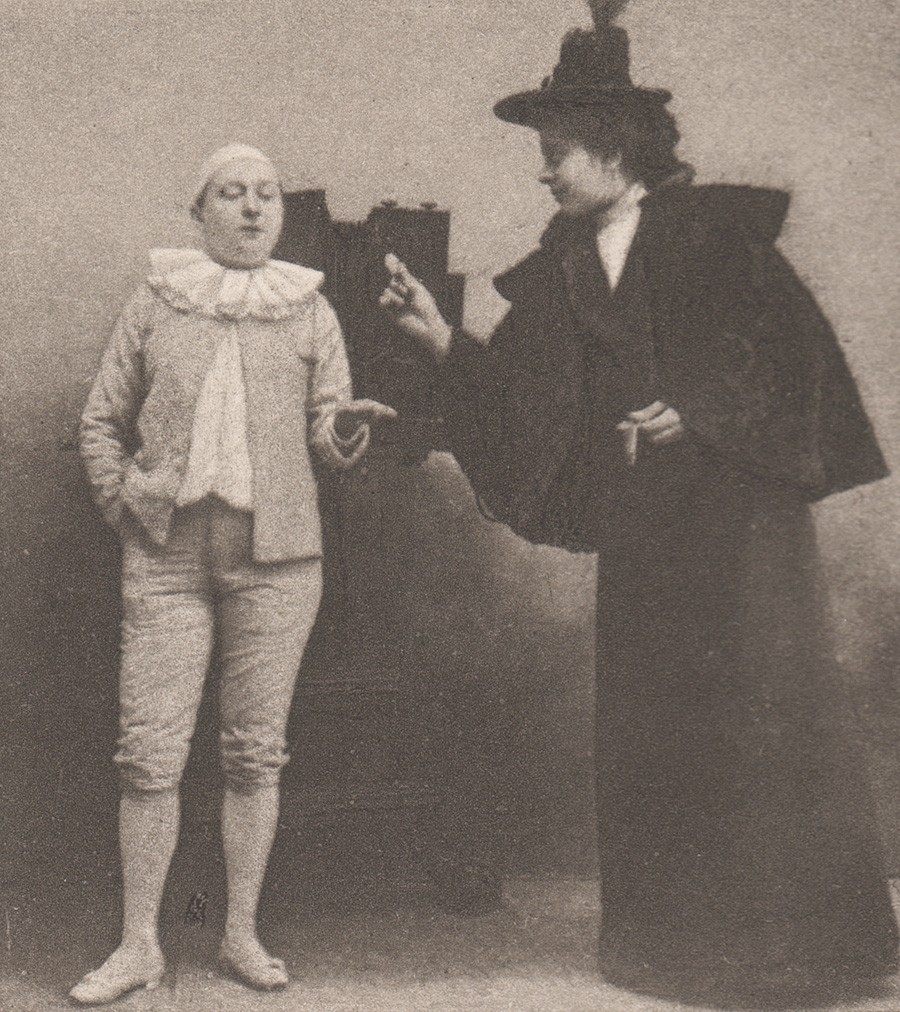 Pantomime clown Pierrot played by French actress Félicia Mallet (1863-1928) holds out hand to receive payment from subject for taking photograph. Detail: (5.7 x 5.4 cm) Arthur da Cunha: "Pierrot Photographe": vintage hand-pulled photogravure from March, 1896 issue of the Bulletin du Photo-Club de Paris: PhotoSeed Archive
Pantomime clown Pierrot played by French actress Félicia Mallet (1863-1928) holds out hand to receive payment from subject for taking photograph. Detail: (5.7 x 5.4 cm) Arthur da Cunha: "Pierrot Photographe": vintage hand-pulled photogravure from March, 1896 issue of the Bulletin du Photo-Club de Paris: PhotoSeed Archive
In a fortunate coincidence, no less an observer than George Bernard Shaw weighed in a year later, his take on Mallet’s performance during the London stage production of A Pierrot’s Life giving readers the opinion her Pierrot was far more believable than one played by (Mrs.) Signora Litini:
The recasting of “A Pierrot’s Life” at the matinees at the Prince of Wales’ Theatre greatly increases and solidifies the attraction of the piece. Felicia Mallet now plays Pierrot; but we can still hang on the upturned nose of the irresistible Litini, who reappears as Fifine. Litini was certainly a charming Pierrot; but the delicate, subtle charm was an intensely feminine one, and only incorporated itself dreamily with the drama in the tender shyness of the first act and the pathos of the last. Litini as a vulgar drunkard and gambler was as fantastically impossible as an angel at a horse-race. Felicia Mallet is much more credible, much more realistic, and therefore much more intelligible — also much less slim, and not quite so youthful. Litini was like a dissolute “La Sylphide”: Mallet is frankly and heartily like a scion of the very smallest bourgeoisie sowing his wild oats. She is a good observer, a smart executant, and a vigorous and sympathetic actress, apparently quite indifferent to romantic charm, and intent only on the dramatic interest, realistic illusion, and comic force of her work. And she avoids the conventional gesture-code of academic Italian pantomime, depending on popularly graphic methods throughout. The result is that the piece is now much fuller of incident, much more exciting in the second act (hitherto the weak point) and much more vivid than before. (2.)
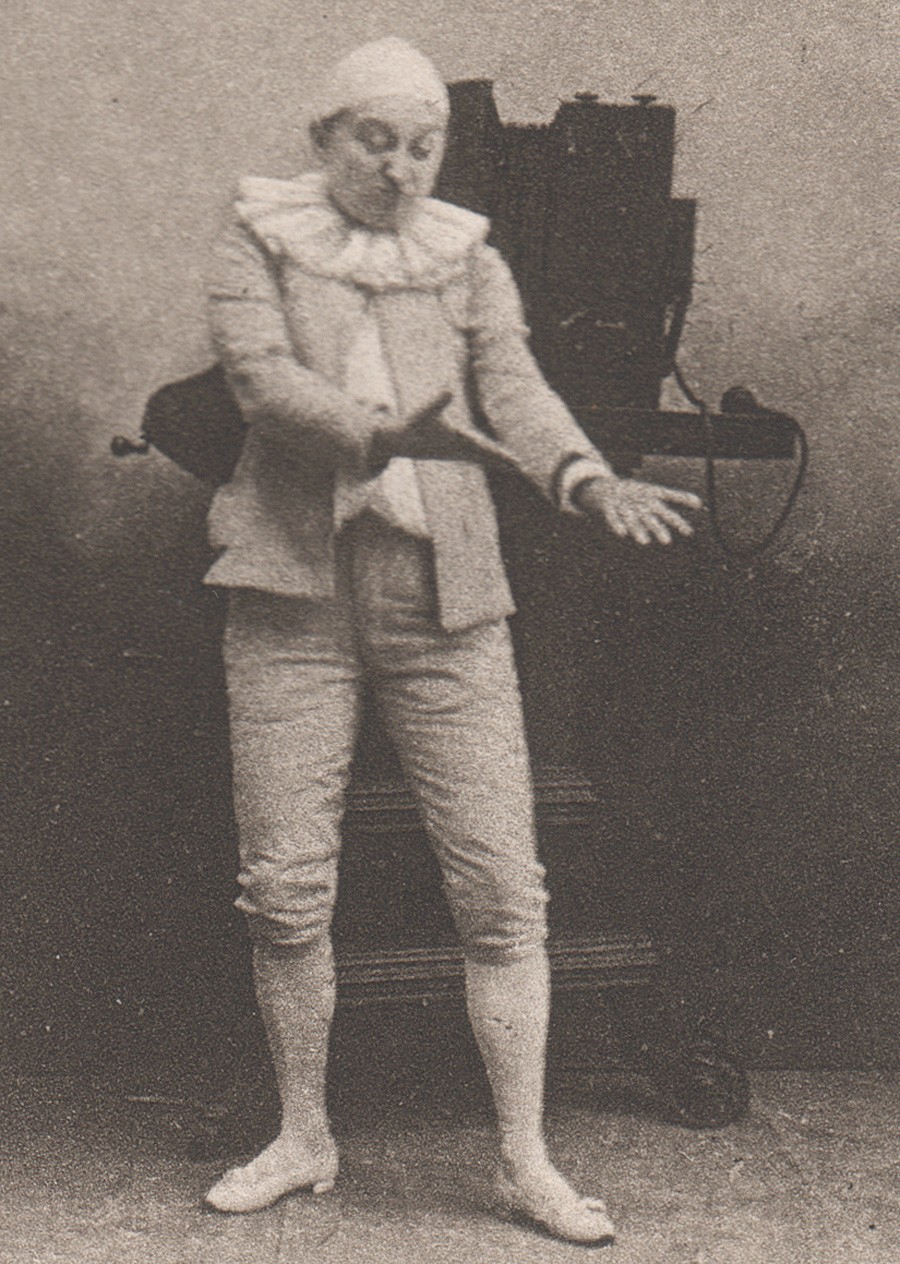 Performance complete. Pantomime clown Pierrot played by French actress Félicia Mallet (1863-1928) acknowledges applause for taking photograph. Detail: (5.7 x 4.3 cm) Arthur da Cunha: "Pierrot Photographe": vintage hand-pulled photogravure from March, 1896 issue of the Bulletin du Photo-Club de Paris: PhotoSeed Archive
Performance complete. Pantomime clown Pierrot played by French actress Félicia Mallet (1863-1928) acknowledges applause for taking photograph. Detail: (5.7 x 4.3 cm) Arthur da Cunha: "Pierrot Photographe": vintage hand-pulled photogravure from March, 1896 issue of the Bulletin du Photo-Club de Paris: PhotoSeed Archive
Notes:
1. Pierrot: see: Wikipedia overview: accessed, March, 2014
2. excerpt: Meredith on Comedy: An Essay on Comedy. By George Meredith. Westminster: Archibald Constable & Co. 1897: from: Dramatic Opinions and Essays by G. Bernard Shaw/(James Huneker): Volume 2: New York: Brentanos: 1906: pp. 225-6
